The table below shows the recorded times that the images were taken. Times are taken from official data. A total of 100 images were taken (image 510 – image 609). No image was taken after image 609. The majority of durations between images around or above 9s, which means they could have taken with flash and most likely were taken with flash.
Additionally, the table shows the rain intensity as seen in each image, on a 1-10 scale, with 1 being minimal rainfall and 10 being heavy rainfall. Note that this scale does not necessarily equate to the true rain fall, as some images do not show the rain well, mainly due to the poor lighting conditions.
People that are familiar with the disappearance case of Kris Kremers and Lisanne Froon are at least somewhat familiar with the disconcerting night time photos. The photos were found on the camera that Lisanne Froon carried in her backpack during their adventures in Panama. Once discovered, the night photos became an important part of the disappearance investigation.
If this is the first time you’ve heard about this disappearance case, I suggest you read the background story: Unsolved: Kris Kremers And Lisanne Froon In Panama
After researching the case and writing about it extensively, I asked interested persons to help me research the disappearance case – the case simply has too many angles to research alone. I wanted to create a research team (link to info).
Matt, a gentleman from Canada, contacted me and we spoke for numerous hours about the case.
Matt had purchased the exact same camera model (Canon Powershot SX270 HS) that Kris Kremers and Lisanne Froon had with them when they disappeared. In conjunction with the camera, he also purchased a red wig that matches Kris Kremers red hair, he carefully measured the reach of the flash, measured the difference between all of the object in the viewport, duplicated the rainy conditions in the images, evaluated the camera’s inner programming and EXIF operations, among numerous other important investigations.
Overall, Matt has tested the camera extensively in order to understand the role the camera played during the evening that the night photos were taken. Matt is a technology professional and a photographer. He is extremely knowledgable about the case and very methodical in his research, as you will see below.
This is Matt’s thorough analysis of the night photos, written by him. If you wish to contact him, his contact information is at the bottom of the page.
Here is his research…
Kris Kremers & Lisanne Froon Night Photo Analysis
The following is an analysis of the photos 510 to 609, also referred to as the “night photos”, related to the disappearance of Kris Kremers and Lisanne Froon. The case entails the tragic and unnecessary death of two young women. This should be remembered to show the utmost respect for the two young women and their loved ones.
The official investigation into this case leaves much to be desired and did not do a justice for Kris and Lisanne. They deserve the respect that this case is properly investigated and all facts be considered. Simply claiming that they got themselves lost and perished, while there may have been more factors involved that were out of their control, is unjust and unfair.
It’s understood that the night photos were on the Canon Powershot SX270 HS digital camera that was found in Lisanne’s backpack. The photos were never officially “released”, but instead were “leaked” by various investigators. It is my understanding that the majority of the photos were leaked to Juan (link to Juan’s archives).
The Date and Time that the images were taken exists from publications and other leaked data. I used the publicly available data on Scarlet’s website (link).
Out of the 100 photos, only 51 photos exist. The remaining photos never surfaced to the public. It is also possible that more than 100 photos exist. For now, we’ll assume that the only photos that exist are the 100 known photos.
Night Photo Damage
Unfortunately, all photos were damaged to some degree. What we have to work with are only those damaged images.
The damage consists of:
Resizing – The original resolution of the images would be 4000 x 3000 pixels, from the Camera’s 12 MegaPixel sensor with a 4:3 aspect ratio. The publicly available images were all resized to 1280 x 960 (1284 x 963) and 772 x 963 or 1.2 MegaPixel and 0.74 MegaPixel. Unfortunately, this resizing resulted in a loss of 90% of the actual image data.
Removal of EXIF data – With the exception of image 542 and 550 no images have EXIF data.
Color Manipulation – It is not easy to determine which images were manipulated. It is likely that several images were increased in brightness and contrast. This can be seen, for example, in image 595 (shown below), which shows typical color artifacts of underexposed and then brightened digital images.
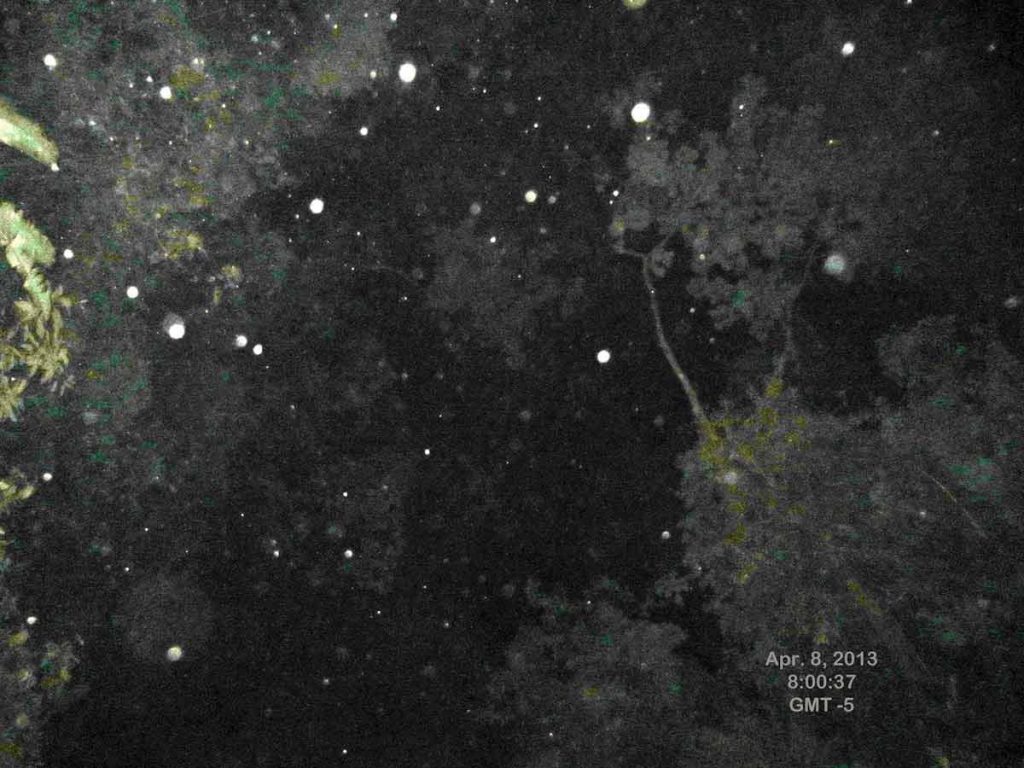
The unedited images would have looked nearly all black, like shown below.
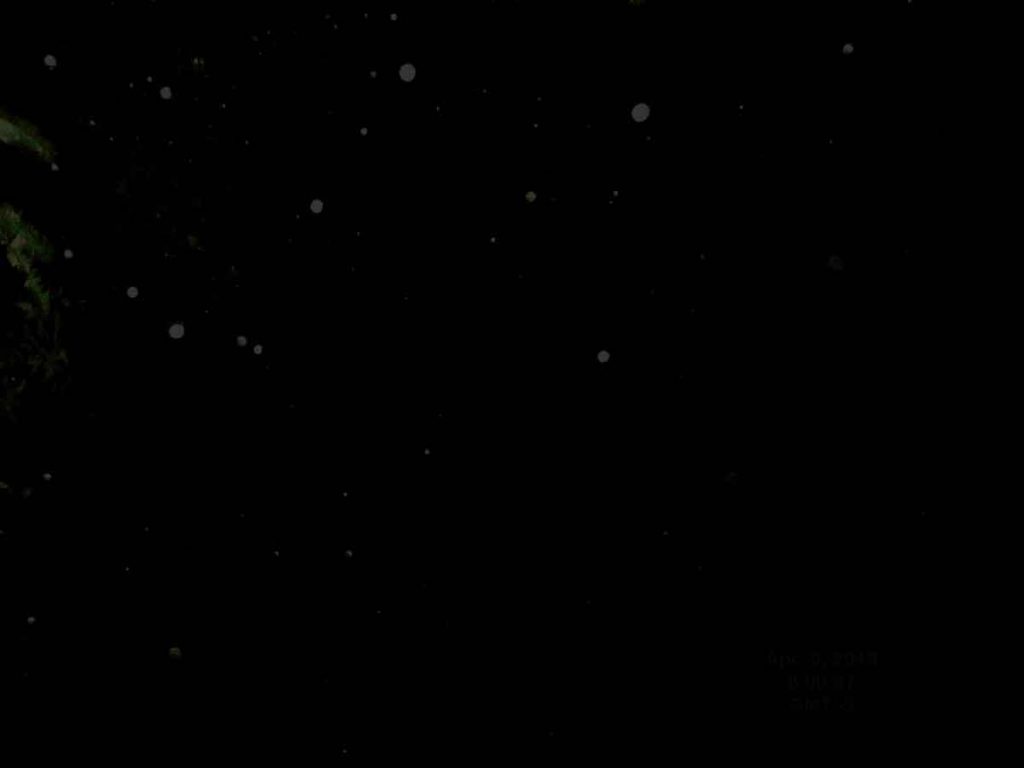
The image adjustments were done in simple fashion by someone that was probably not an expert with digital image editing, namely because only the brightness and contrast were increased, rather than adjusting image levels. The image’s brightness levels are shown below. Here we can observe a typical image that’s been severely underexposed.
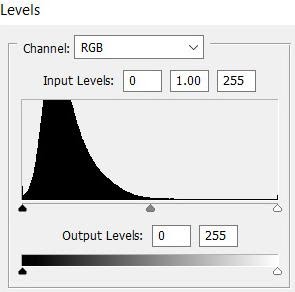
Without getting too technical, experienced graphics editors use “levels” to adjust the range of brightness and darkness tones. This tool essentially makes the dark and light areas of a photo more consistent and visually pleasing. When image brightness is adjusted via levels, it leads to visible gaps in the histogram because the existing brightness levels are spread over the entire brightness spectrum of 0 – 255. The same image further brightened by me has a histogram as seen below. You can see a clear difference.
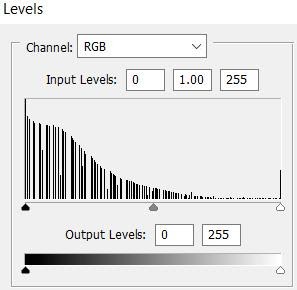
The example below shows a crop from image 511 and is representative of most images in the night photos. The image was brightened which is evident by the dark green color artifacts visible in the bushes. Below is a crop of the top left corner. Visible are the dark green color artifacts.

An image that I took with the Canon Powershot, under similar conditions (at night during rain) and not brightened, would look like the image below. The photo is nearly all black. Note that there is a branch visible in the lower left corner that is very close to the camera.
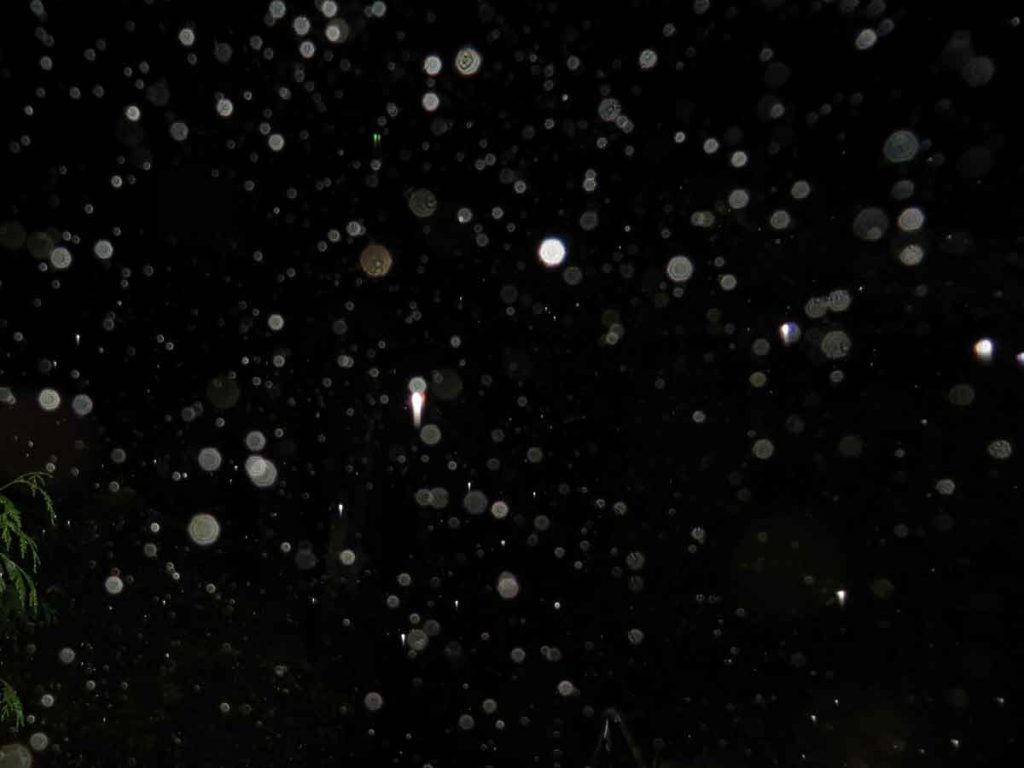
The image above further brightened will look like the image below. Now we can see trees, bushes and the same green color artifacts.
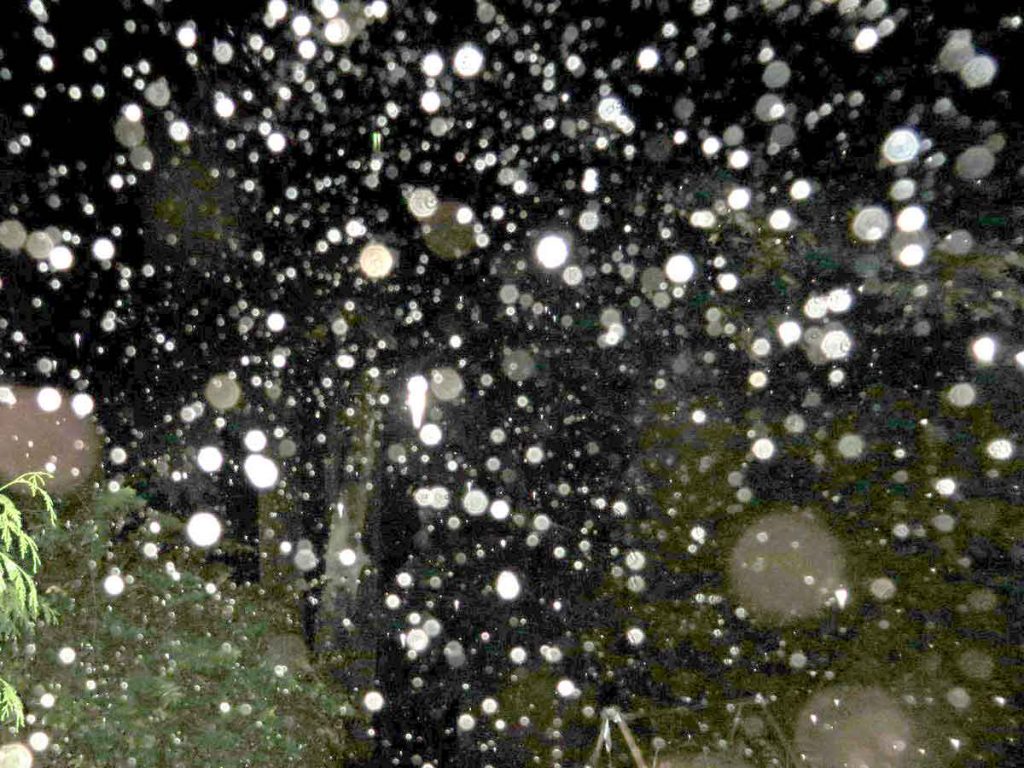
This is also an explanation for the statements made by people that saw the original images. Apart from a few of the night photos, the original night photos would have been mostly black. Furthermore, it would be a fair to refer to even almost black pictures as “black” unless you are examining them meticulously, as is done here. Thus, I’d like to point out that the statement describing the night images as mostly black was truthful and not intended to be misleading.
Several images exist in as many as three different versions, which is best seen with image 542. I combined all three of the images below to illustrate this point.

On the left is most likely the original image. The middle image has brightness and contrast increased. The image on the right contains the date and time written into the image. It is likely that the person who edited those images had the originals and took this data from the EXIF information. That practice is not uncommon. Images are often edited and then saved under different names, in order to safely maintain the original images. I do the same when editing images and I do not see this as an attempt to covertly manipulate the images. Whoever duplicated the images was most likely just trying to see what is in those images and ended up sending the entire work-in-progress with single, double and triple images to Juan. There is nothing untypical here.
Another example where this crude technique of image brightening was applied is with image 576, which is known as the ”SOS marker” photo. Simply adjusting brightness and contrast has the side effect that the entire “SOS marker” is obscured and it gives the impression it was intentionally hidden. Realistically, this is just the result of this simplistic approach to image “enhancement”.
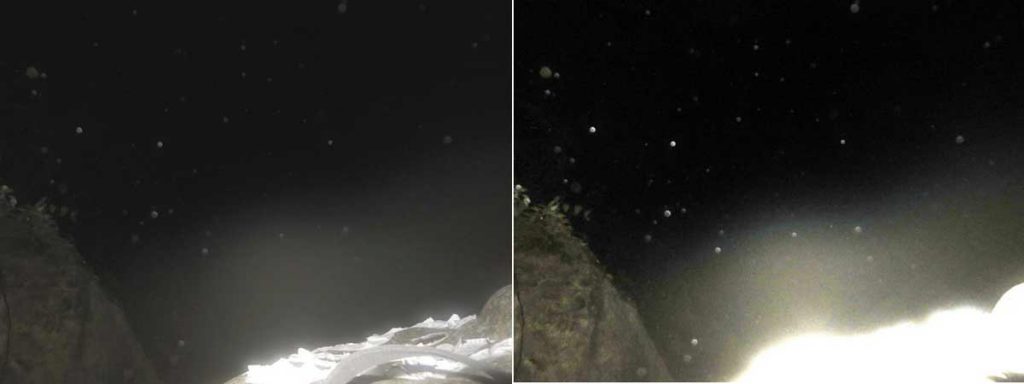
Above, on the left is the original image. On the right is the leaked image with brightness and contrast increased (i.e. +100/+100).
A bigger issue with the photos is that the recorded image numbers and times are probably mixed up and therefore inaccurate to some degree.
All of these shortcomings leaves us with a mess of small and damaged images. It is also problematic that it’s unknown which image artifacts, on some of the images, are caused by the original lighting conditions and which are caused by crude image manipulation. This causes some problems later in my research, as you’ll see.
Baseline Assumptions
The following assumptions were made for this investigation:
- Assumption 1 – The camera used was a Canon Powershot SX270 HS. This information was reported by officials and is also visible on the EXIF data, of the few images that offer EXIF data. However, the camera shown in the official photos does not clearly show the Canon Powershot SX270 HS. It may look similar if the camera has the lens extended. Also, the bag that could be a camera bag (shown below) does not appropriately fit this small camera. Kris Kremers and Lisanne Froon can be seen using a camera with one hand to take selfies, which points to a rather small camera being used. It is unlikely that the images were manipulated and the camera swapped, since there is no clear motive for this. It is therefore assumed for this investigation that a Canon Powershot SX270 HS was used. This is critically important since many conclusions are based on it.
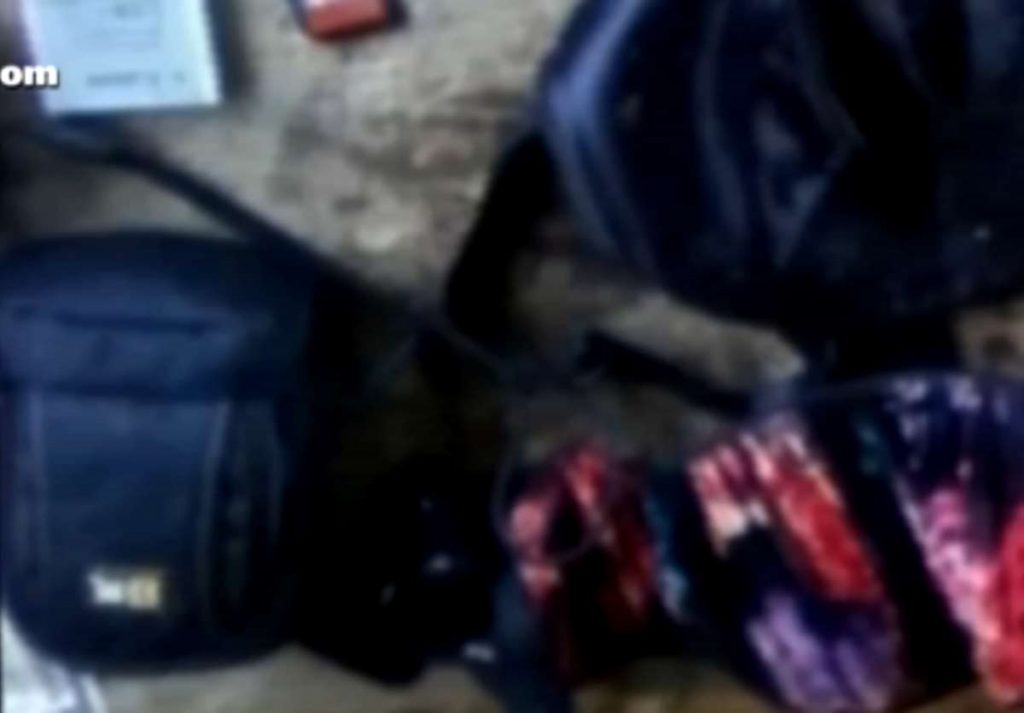
- Assumption 2 – The camera was functioning normally and was not exhibiting issues or malfuntions. This relates especially to the flash and auto focus. There is at present no reason to doubt this and it is assumed correct
- Assumption 3 – Image numbers and image times are generally correct. This said, it is very evident that they are not correct for all images. This can be seen by the fact that some image names don’t align with the sequence of photos and that several images were taken at the same time, if the available data is believed.
It is possible that this is due to mistakes by the person extracting this data from the original images. It is very easy to make mistakes when working with 100 mostly black images and when copying data from EXIF viewers into other tables. I myself have caught myself making similar mistakes when compiling this data. Those mix ups happen easily. It is thus assumed that the bulk of this data is correct but does occasionally contain mistakes. - Assumption 4 – No images were deleted. We know that image 509 was deleted but it is generally assumed that none of the night images were deleted.
Night Photo Data
The table below shows the recorded times that the images were taken. Times are taken from official data. A total of 100 images were taken (image 510 – image 609). No image was taken after image 609. The majority of durations between images around or above 9s, which means they could have taken with flash and most likely were taken with flash.
Additionally, the table shows the rain intensity as seen in each image, on a 1-10 scale, with 1 being minimal rainfall and 10 being heavy rainfall. Note that this scale does not necessarily equate to the true rain fall, as some images do not show the rain well, mainly due to the poor lighting conditions.
| Image # | Local Time | Delta T [mm:ss] | Rain [ 1 – 10 ] |
| Image 510 | 1:29:42 | NA | |
| Image 511 | 1:30:07 | 0:00:25 | 8 |
| Image 512 | 1:30:33 | 0:00:26 | |
| Image 513 | 1:30:47 | 0:00:14 | |
| Image 514 | 1:30:57 | 0:00:10 | |
| Image 515 | 1:31:07 | 0:00:10 | |
| Image 516 | 1:31:18 | 0:00:11 | |
| Image 517 | 1:31:42 | 0:00:24 | |
| Image 518 | 1:31:53 | 0:00:11 | |
| Image 519 | 1:32:30 | 0:00:37 | |
| Image 520 | 1:32:43 | 0:00:13 | |
| Image 521 | 1:32:53 | 0:00:10 | |
| Image 522 | 1:33:05 | 0:00:12 | |
| Image 523 | 1:33:14 | 0:00:09 | |
| Image 524 | 1:33:27 | 0:00:13 | |
| Image 525 | 1:33:39 | 0:00:12 | |
| Image 526 | 1:33:50 | 0:00:11 | |
| Image 527 | 1:34:09 | 0:00:19 | |
| Image 528 | 1:34:21 | 0:00:12 | |
| Image 529 | 1:34:38 | 0:00:17 | |
| Image 530 | 1:34:50 | 0:00:12 | |
| Image 531 | 1:35:05 | 0:00:15 | |
| Image 532 | 1:35:24 | 0:00:19 | |
| Image 533 | 1:35:41 | 0:00:17 | |
| Image 534 | 1:35:50 | 0:00:09 | |
| Image 535 | 1:36:06 | 0:00:16 | |
| Image 536 | 1:36:40 | 0:00:34 | |
| Image 537 | 1:36:53 | 0:00:13 | |
| Image 538 | 1:37:09 | 0:00:16 | |
| Image 539 | 1:37:21 | 0:00:12 | |
| Image 540 | 1:37:43 | 0:00:22 | |
| Image 541 | 1:37:57 | 0:00:14 | |
| Image 542 | 1:38:12 | 0:00:15 | 2 |
| Image 543 | 1:38:28 | 0:00:16 | 5 |
| Image 544 | 1:38:46 | 0:00:18 | 4 |
| Image 545 | 1:38:57 | 0:00:11 | 4 |
| Image 546 | 1:39:12 | 0:00:15 | 7 |
| Image 547 | 1:39:21 | 0:00:09 | 5 |
| Image 548 | 1:39:32 | 0:00:11 | 7 |
| Image 549 | 1:39:42 | 0:00:10 | 5 |
| Image 550 | 1:39:54 | 0:00:12 | |
| Image 551 | 1:40:07 | 0:00:13 | |
| Image 552 | 1:40:18 | 0:00:11 | 6 |
| Image 553 | 1:40:32 | 0:00:14 | 6 |
| Image 554 | 1:40:48 | 0:00:16 | 5 |
| Image 555 | 1:40:59 | 0:00:11 | 4 |
| Image 556 | 1:41:16 | 0:00:17 | 8 |
| Image 557 | 1:41:26 | 0:00:10 | |
| Image 558 | 1:41:33 | 0:00:07 | |
| Image 559 | 1:41:38 | 0:00:05 | |
| Image 560 | 1:41:58 | 0:00:20 | |
| Image 561 | 1:42:07 | 0:00:09 | 4 |
| Image 562 | 1:42:25 | 0:00:18 | 7 |
| Image 563 | 1:42:45 | 0:00:20 | |
| Image 564 | 1:43:14 | 0:00:29 | |
| Image 565 | 1:43:28 | 0:00:14 | 6 |
| Image 566 | 1:43:45 | 0:00:17 | |
| Image 567 | 1:44:12 | 0:00:27 | 8 |
| Image 568 | 1:44:37 | 0:00:25 | |
| Image 569 | 1:45:01 | 0:00:24 | 8 |
| Image 570 | 1:45:14 | 0:00:13 | 8 |
| Image 571 | 1:45:23 | 0:00:09 | |
| Image 572 | 1:45:32 | 0:00:09 | 4 |
| Image 573 | 1:45:52 | 0:00:20 | 6 |
| Image 574 | 1:46:01 | 0:00:09 | |
| Image 575 | 1:46:11 | 0:00:10 | |
| Image 576 | 1:46:20 | 0:00:09 | 5 |
| Image 577 | 1:47:31 | 0:01:11 | |
| Image 578 | 1:47:51 | 0:00:20 | |
| Image 579 | 1:48:10 | 0:00:19 | 9 |
| Image 580 | 1:49:47 | 0:01:37 | 0 |
| Image 581 | 1:49:56 | 0:00:09 | |
| Image 582 | 1:50:05 | 0:00:09 | 3 |
| Image 583 | 1:50:26 | 0:00:21 | 3 |
| Image 584 | 1:51:56 | 0:01:30 | 5 |
| Image 585 | 1:52:28 | 0:00:32 | 5 |
| Image 586 | 1:53:02 | 0:00:34 | 6 |
| Image 587 | 1:53:13 | 0:00:11 | 3 |
| Image 588 | 1:54:08 | 0:00:55 | |
| Image 589 | 1:54:46 | 0:00:38 | 4 |
| Image 590 | 1:55:01 | 0:00:15 | 8 |
| Image 591 | 1:55:36 | 0:00:35 | 10 |
| Image 592 | 1:57:02 | 0:01:26 | 7 |
| Image 593 | 1:58:26 | 0:01:24 | 6 |
| Image 594 | 1:58:35 | 0:00:09 | 6 |
| Image 595 | 2:00:37 | 0:02:02 | 5 |
| Image 596 | 2:05:16 | 0:04:39 | |
| Image 597 | 2:05:25 | 0:00:09 | 1 |
| Image 598 | 2:05:31 | 0:00:06 | |
| Image 599 | 2:12:11 | 0:06:40 | 7 |
| Image 600 | 2:15:25 | 0:03:14 | 8 |
| Image 601 | 2:20:48 | 0:05:23 | |
| Image 602 | 2:29:01 | 0:08:13 | 7 |
| Image 603 | 2:31:25 | 0:02:24 | 8 |
| Image 604 | 2:37:11 | 0:05:46 | 10 |
| Image 605 | 2:46:16 | 0:09:05 | 7 |
| Image 606 | 3:09:35 | 0:23:19 | |
| Image 607 | 3:09:51 | 0:00:16 | 6 |
| Image 608 | 3:22:47 | 0:12:56 | 9 |
| Image 609 | 4:10:59 | 0:48:12 | 5 |
Legend:
Exif Data Available
Image Missing
“—” Data Not Available
The following graph shows the time of day the images were taken on the X Axis and the duration between images on the Y Axis. The majority of the photos were taken at the beginning of the image series and in very quick succession. As time progresses, less and less images are taken, with the last image being taken after 48 min.

Potential reasons that no more images were taken are:
- Memory card full
This was not the case. - Camera battery ran out of power
This is possible. In order to determine how many images with full power flash the camera can take, I used a fully charged battery, took 52 images without flash to simulate the daylight images taken on 1 April and then took images with full power flash as fast as possible until the battery ran out.
This experiment shows that the camera could take 331 images with full power flash, so over three times as many as were taken on 8 April. It also showed that it is not possible to take an image before the flash is charged if the flash is enabled. All completely black images would either have the flash turned off or were aimed in a direction where there was no subject near the camera. The average time between images was 10.5s. This time was very consistent and shows that any two images with flash that have a time of less than 10s between them have some kind of issue.
The internal camera temperature is also recorded in the EXIF data and this temperature rose from 19C (ambient) to 34C after 331 images. After the camera shuts down from low power, the battery will recover after a while and a few more images can be taken and it will shut down again until it is completely drained. - The motivation to take the images was no longer there
It can not be said why no more images were taken, it is possible that the battery was only half full on April 8th and the battery ran out. The last image might have been taken after the battery recovered. It is equally possible that there was no longer a reason to take any more images.
Photo Timing Distribution
The following graph is a Pareto of number of images taken per time interval. The X Axis shows time intervals and the Y Axis shows how many images were taken in the interval.
The graph illustrates that the majority of images were taken at the beginning of the series with 70 images taken between 1:29 AM and 1:48 AM. Another 18 Images were taken 1:48 AM and 2:07 AM. After 2:07 AM, images were only taken sporadically.
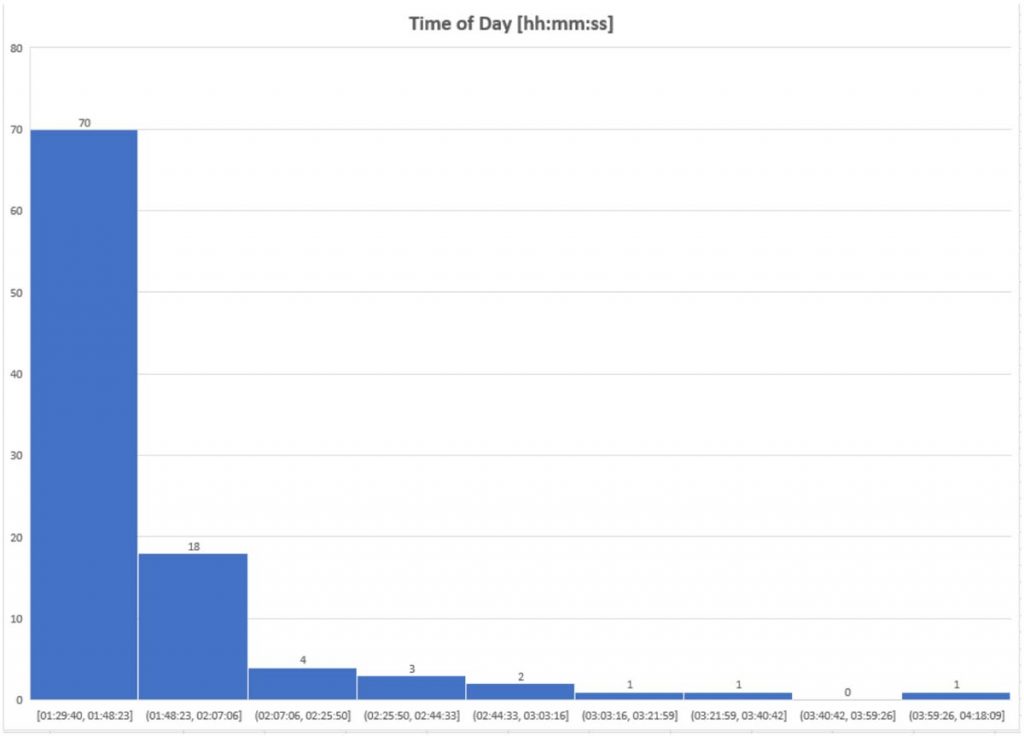
The graph below is a Pareto of number of images taken for a duration. It shows the majority of images (91) were taken within 4 minutes or less.
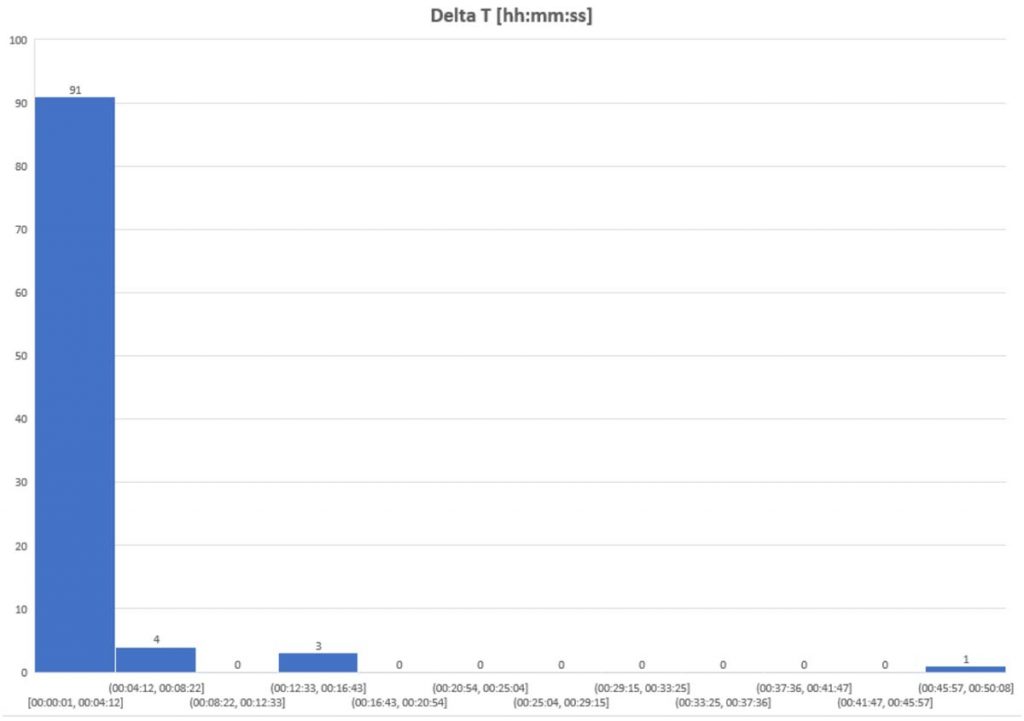
The images were taken more or less continuously from 1:29 AM to 3:22 AM. Then there was a 48 min break and a last image was taken. After that either no more images were taken or they are not known about or deleted.
Night Photo Overlay
The majority of the images show the same area and several features like specific leaves, trees, branches are shown in several images. This makes it possible to overlay the majority of images. There are only a few images that have no common features, which are image 541 (large bright area), image 550 (Balloon Marker) and image 580 (Head). The images are simply overlaid so that common features show the most overlap. Perspective is not considered so that image that are to the sides are distorted. In order to create a perfect panorama, it would be necessary to stretch the images to correct for the perspective. Since there are not enough images and the angles they were taken under are too great makes this impossible.
This results in the following composite. Note that for overlapping images only the ones with the most detail are shown. For each image there is a red frame that shows how the camera was held and a red dot that shows the center of each image. The green frame is the median frame that is determined from the median angle over horizontal and the green dot is the median center point. The green dot shows the area that the photographer was intending to aim the camera.
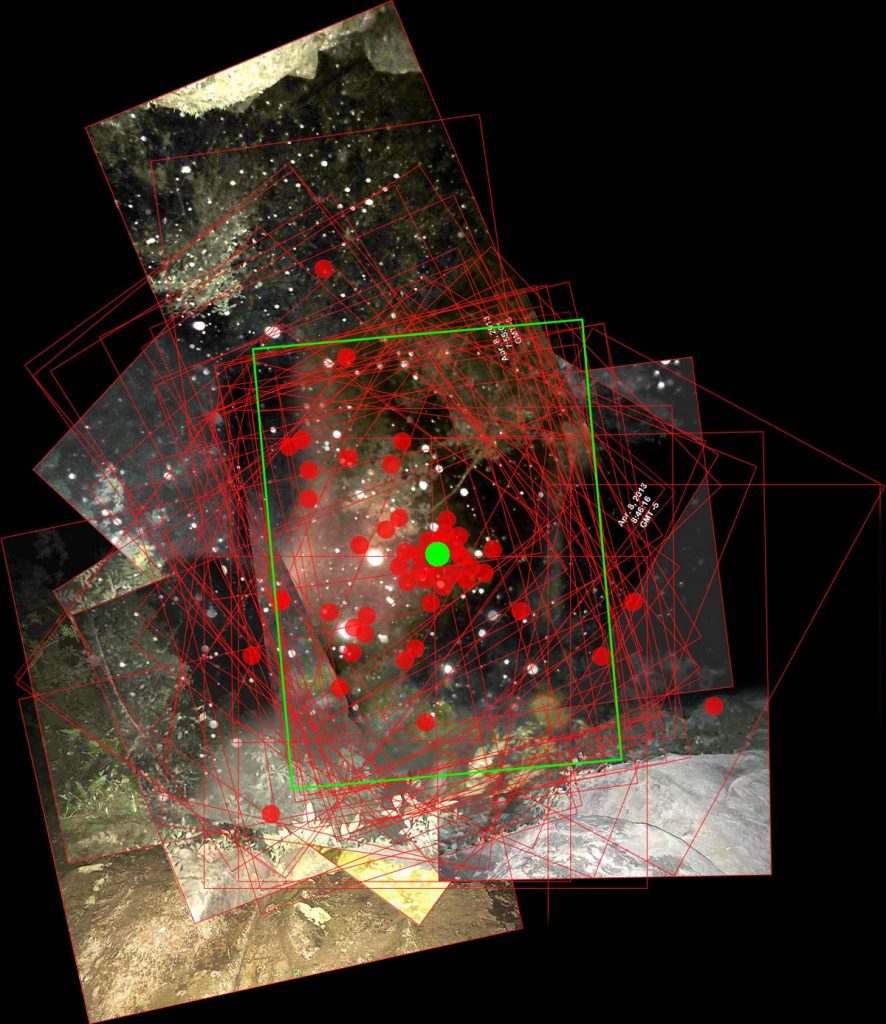
I’ve also created the following animation, which shows the images in the correct order as they were taken over time.
From the combined overlaid images, the layout of the location can be estimated to look as follows (not to scale):
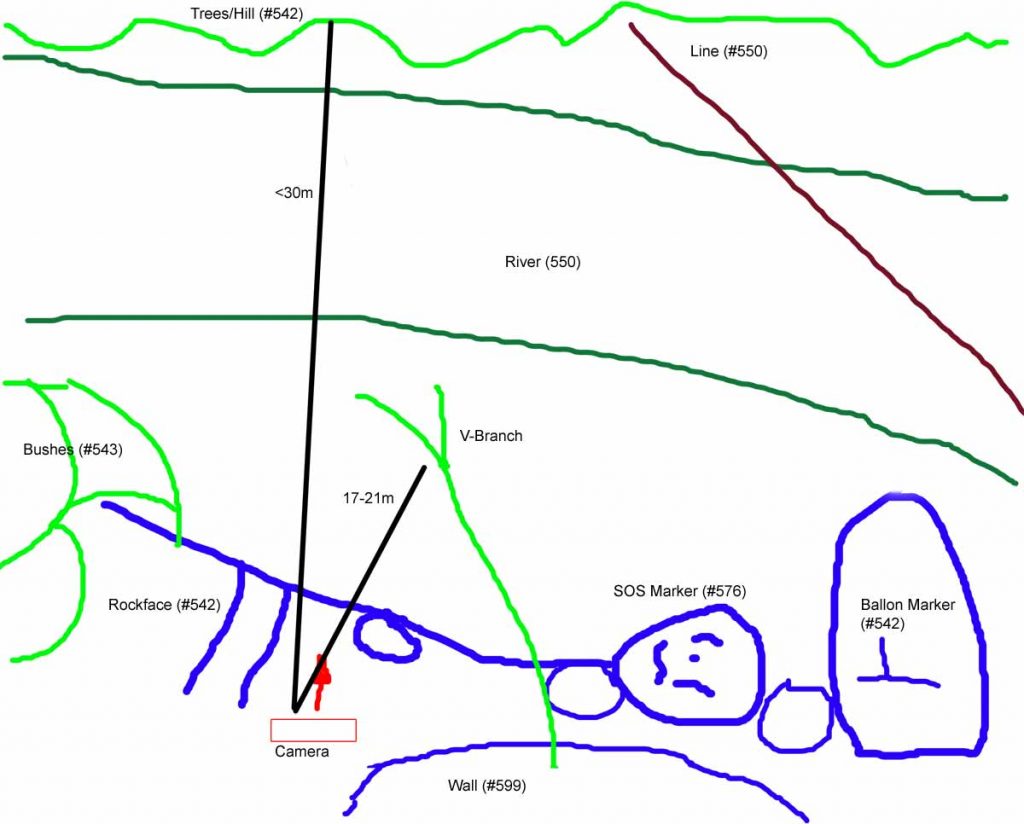
Next, we’ll analyze the circumstances regarding the images. We’ll discuss the following points below:
- Are the photos real?
- Who took the photos?
- What is on the photos?
Are the photos real?
Here “real” refers to: were they taken with Lisanne’s camera in the Boquete area? Although many aspects of the official investigation are questionable, it appears that there’s little doubt that the images were taken in the “Boquete Area”.
They may not have been taken near El Pianista trail though. We cannot be certain of the precise location.
Who took the photos?
It remains unknown who took the night photos. Without further evidence, a determination can only be estimated based on the highest probability. The following possibilities exist:
- Lisanne
- Kris
- Kris and Lisanne
- Someone else
1. Lisanne
It is Lisanne’s camera and she has taken the majority of the pictures so it is very probable that it was her. Additionally, it is possibly Kris in image 580, the notable “hair” photo.
Probability: Very likely.
2. Kris
It is also possible that it was Kris who took the photos. However since it is possible that she is in image 550, it decreases the likelihood that Kris took the photos. There is a possibility that she had taken the photo of herself. It has been speculated that this might have been done because she was by herself at the time and possibly wanted to examine the back of her head. This does not seem likely since there is nothing that is obviously wrong with the back of her head (see image discussion). If, for example, she had fallen and injured her head, then it is likely that there would be dirt or blood visible. But nothing is visible. It is not entirely easy to take a self pic of the back of one’s head, as I’ll demonstrate in a moment.
I have tested this while wearing a wig matching Kris’ hair color. I did have the advantage that I had lots of time to think about how to take such a photo. Firstly, one has to be able to reach behind one’s own head with the camera, aim the camera blindly and then get the shot.
Having longer arms than Kris, being rested, warm and dry, not in a state of distress and having had time to think about how to take the picture and the issues that arise, e.g. how to aim. I was able to take the following image.
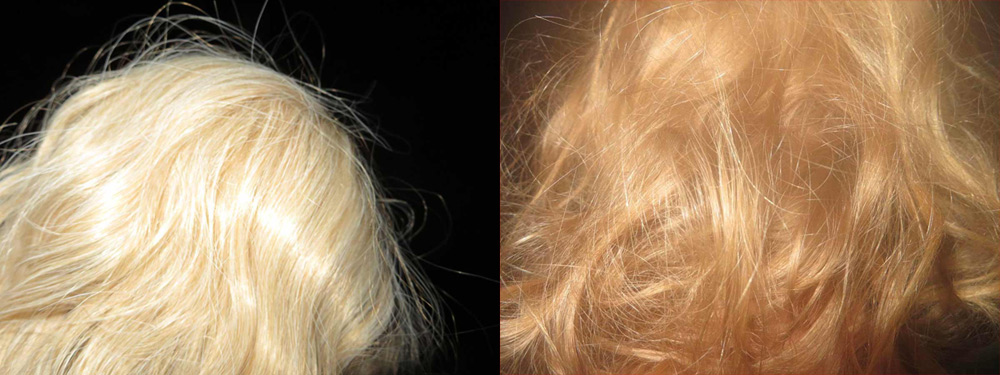
My test photo is on the left, the original photo of Kris’s hair on the right. Right away it becomes very apparent that despite the above mentioned advantages for me, my picture is far inferior. I did not even manage to get the back of my head into the image.
I only took one try because the original was also only taken in one try. If there were more photos of Kris’s hair, there would also be images displaying less successful attempts, which there is not. As for my photo, I would have had to retake the photo numerous times. Eventually I would probably have been able to get the back of my head in focus and in the frame. But since the original of Kris’s hair was taken with only one successful attempt, I left it at this.
Although it is possible that Kris took this photo of her own here, it remains unlikely.
Probablity: Unlikely.
3. Kris and Lisanne
It is possible that some photos were taken by Kris and some by Lisanne, implying that they shared the camera during the night-time photos. There is essentially no way to prove or disprove this. However, I find it unlikely that they would have taken a few pictures and then swapped the camera and so forth. Especially since the most images show similar composition. It is not impossible but unlikely. It makes nearly no difference though.
Probablity: Unlikely.
4. Someone else
There is large number of possible people that could have taken the night pictures, especially if our assumption is wrong that the recorded dates and times were correct.
If someone else took the photos, the following possibilities exist:
Someone with bad intentions was with Kris Kremers and Lisanne Froon in the night of April 8th and took the night photos, perhaps to mock them after hurting them or to play with his victims. This would require the foul play theory to be correct, which is not impossible. But what motive would someone have to commit possible crimes and then take photos of their victims along with other illogical photos? Perhaps rage? Confusion? Mental Illness?
This leads us to more speculative questions. Why not delete the images or destroy the camera? For someone not to at least delete the photos or destroy the camera, the person would have to be extremely stupid or a psychopath. It is unlikely, given the circumstances, that the assailants were truly stupid enough to take photos of their crime, and then let the photos get away to the police, unless they are also very incompetent, and the camera got away inadvertently.
For someone to be a psychopath and take photos of their victims and intentionally let them get to the police is quiet rare in criminal history, and although I am not familiar enough with psychopathic killers, I am only aware of the BTK killer who taunted the police with letters, etc.
It remains somewhat possible that someone could have taken the pictures. However, it’s not likely that they would have spent 4 hours in the rain, at night taking pictures of mostly nothing and then proceeded to let the pictures get to the police.
Probablity: Unlikely.
Another possibility is that someone found the camera at a later time, played with it and took those pictures intentionally or unintentionally. The problem with this theory is that it’s questionable if someone would spend numerous hours during a rainy night to play with a camera in the woods. This would make sense if there were only a few pictures or there were pictures earlier in the night or during the day.
Furthermore, if someone found the camera and played with it, that would also require the person to have someone with them that had red/blonde hair – and then take a picture of them with Lisanne’s camera. This is extremely unlikely in Boquete where this hair color is very uncommon. Additionally, it is not likely that this person would have had access to the camera on April 8th. Lastly, it is even more unlikely that this person took the time later to change all the recorded photo dates to April 8th and not make a single mistake in the process.
Probablity: Very Unlikely.
It can be concluded that although several possibilities exist of who took the night pictures, it is most likely that it was Lisanne (alone) or Kris and Lisanne (together). The probability of a third party taking those pictures is possible but unlikely. It is currently not possible to get a definitive answer to this question.
What is in the photos?
It was important for me to know what is in the night pictures, in order to answer some important questions. The objects in the photos can be grouped as follows:
- People: 2%
- Intentional Objects: 4%
- Surroundings 98%
(multiple categorization possible, thus the sum is over 100%)
The majority of the images show the surroundings of the photographer. Some images show various levels of rain. The images show some ground and some above ground.
For many images it is not clear what they show. To determine this, the following method was employed:
A control image was taken under known conditions, which resulted in an image that looks like the original photos. Then, since the conditions that the control image was taken under as well as the object or subject is known, it is possible conclude, with a high level of certainty, what the original object or subject was.
But before we look closely at the individual images, I’d like to discuss some artifacts that several images have in common.
White dots
A large number of the images shows “white dots”, for example in image 511:
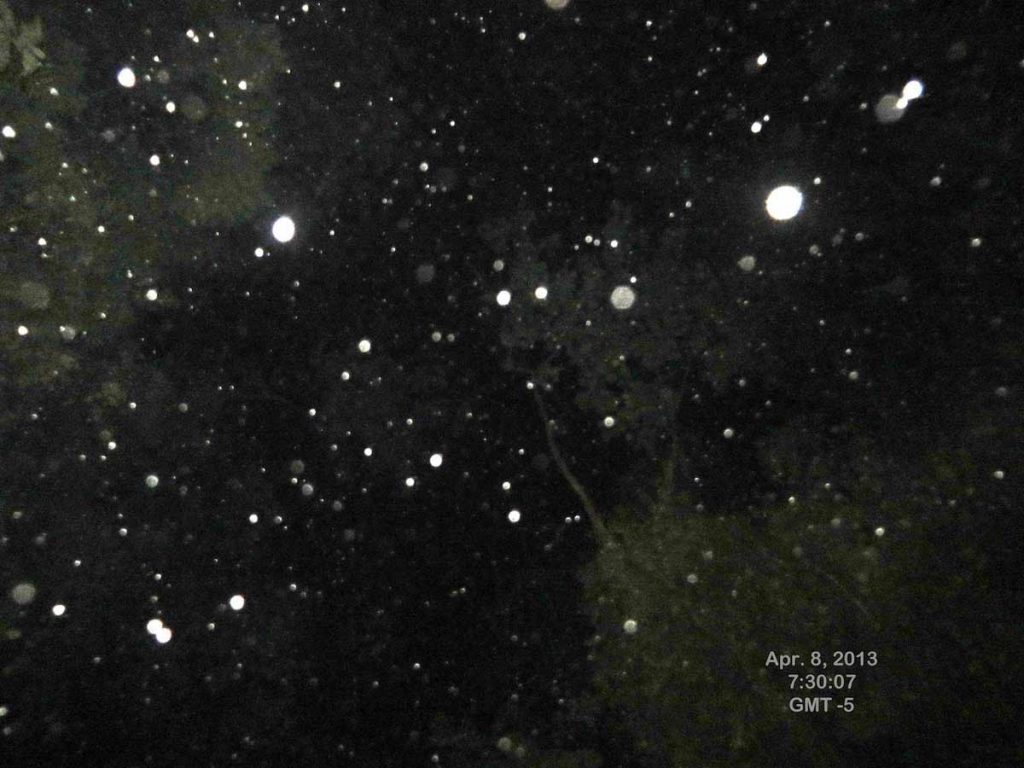
The “spots” were caused by objects lit up by the camera flash. Those objects must be close to the camera in order to be lit by the relatively weak flash of the Canon Powershot SX270 HS. I have found the following suggestions in several internet discussions about what those dots could be:
- Dust
- Insects
- Bats
- Rain
- Spray from a waterfall
Having been a hobby photographer for decades, only the last 2 seemed probable to me. In attempt to recreate the circumstances, I created the following image under these conditions:
- Darkness
- Outside
- Trees/bushes in the background
- Rain of 40 – 70mm per forecast and changing in intensity frequently.
- Flash used
- Camera missed focus
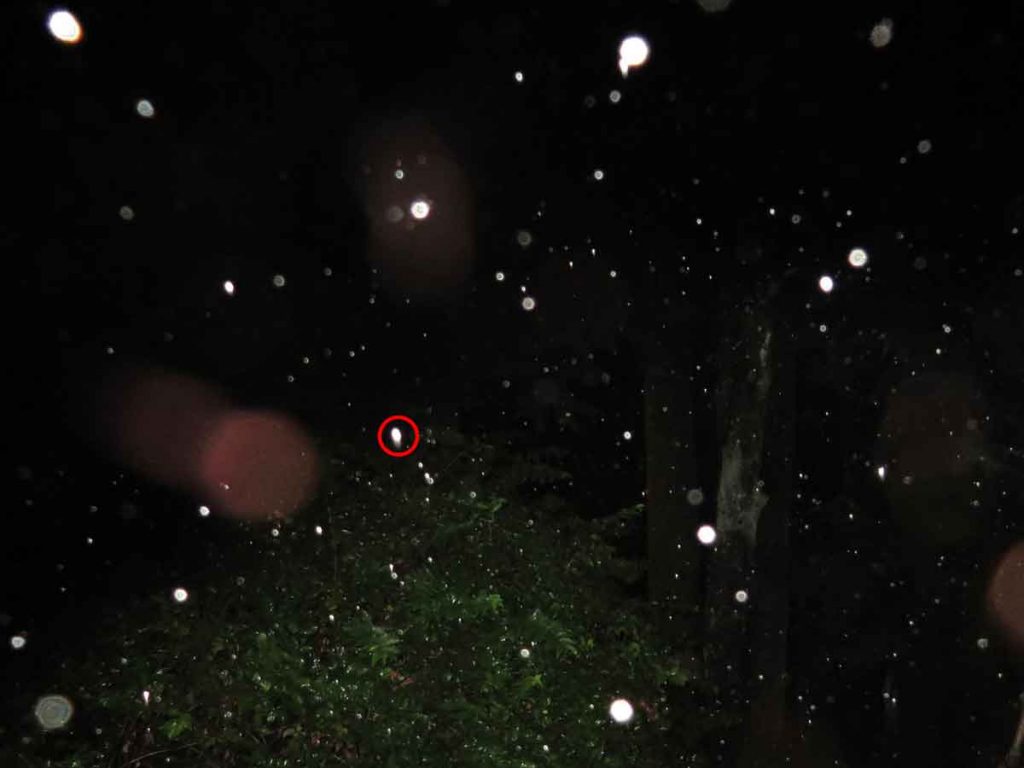
Note that the image is increased in contrast to match the original, cropped to remove an object I did not want in the image and resized to 1280 x 960. It is very apparent that the white objects look identical to those in the original images and we can concluded that the white objects are raindrops. I marked one dot with a red circle as it exhibits a phenomenon caused by the flash. It gives the drop an elongated shape and it points IN the direction of travel of the drop. This is a completely normal instance of flashing a moving object. The effect is more or less strong depending on the distance to the camera. Therefore not all spots have it and neither do the originals.
It is possible that the dots are caused from spray from a waterfall. However, waterfall spray is less likely the culprit. Based on the location of the camera, pointing away from the edge of a ledge, we can concluded that the white dots in the original photos are rain.
The rain must be strong at times as my photo shows much less rain as some of the originals and it shows a strong shower that had me soaked through all clothing after about 15 minutes. The actual pictures were taken during a period of less rain and per the local forecast and it was only about 9mm. This is somewhat problematic and although rainfall can very between nearby mountainous regions, the difference between forecast and what is seen in the images is substantial.
Bats, eyes, dust and insects, etc. can be ruled out.
Red orbs
Several images show red hexagon shaped “orbs” for example in image 585. The orbs we are looking at are those in the lower portion of the image. This image shows other artifacts that will be discussed later.
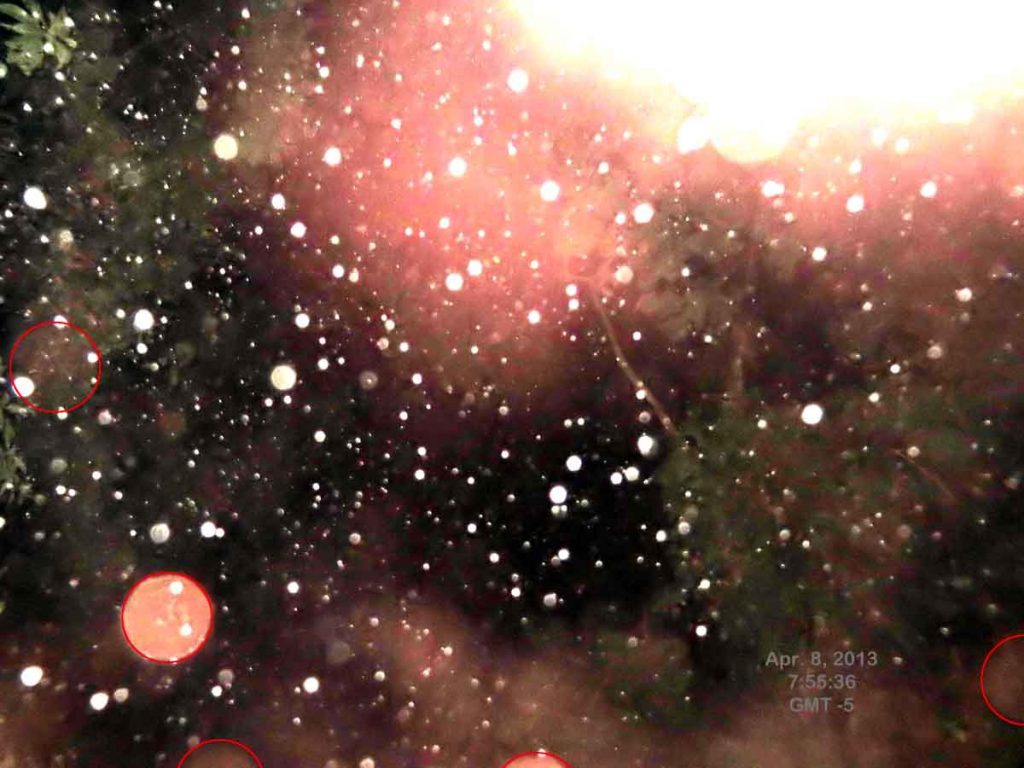
The orbs are caused by light being reflected back into the lens. The light can have several sources, for example flashlights or headlights but in this case is a reflection of the flash from a red/pink object, thus the red/pink color of the orb. The shape of the orb is formed by the aperture of the camera lens.
I recreated an image under the following conditions:
- Darkness
- Outside
- Trees/bushes in the background
- Flash used
- Camera missed focus
- Fingers placed in front of the flash but outside the view of the lens
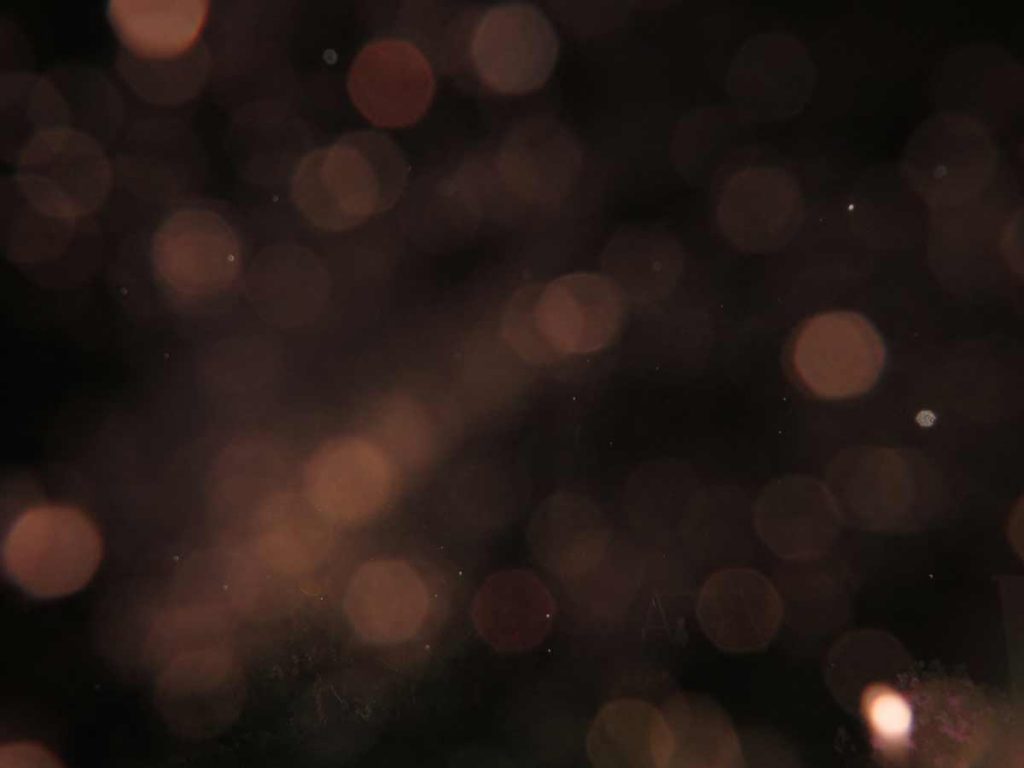
We can see that the orbs look nearly identical and are clearly caused by the flash lighting against skin and reflecting the light back into the lens.
If an image is taken under the same conditions, except a blue object is used to reflect the flash it looks as follows
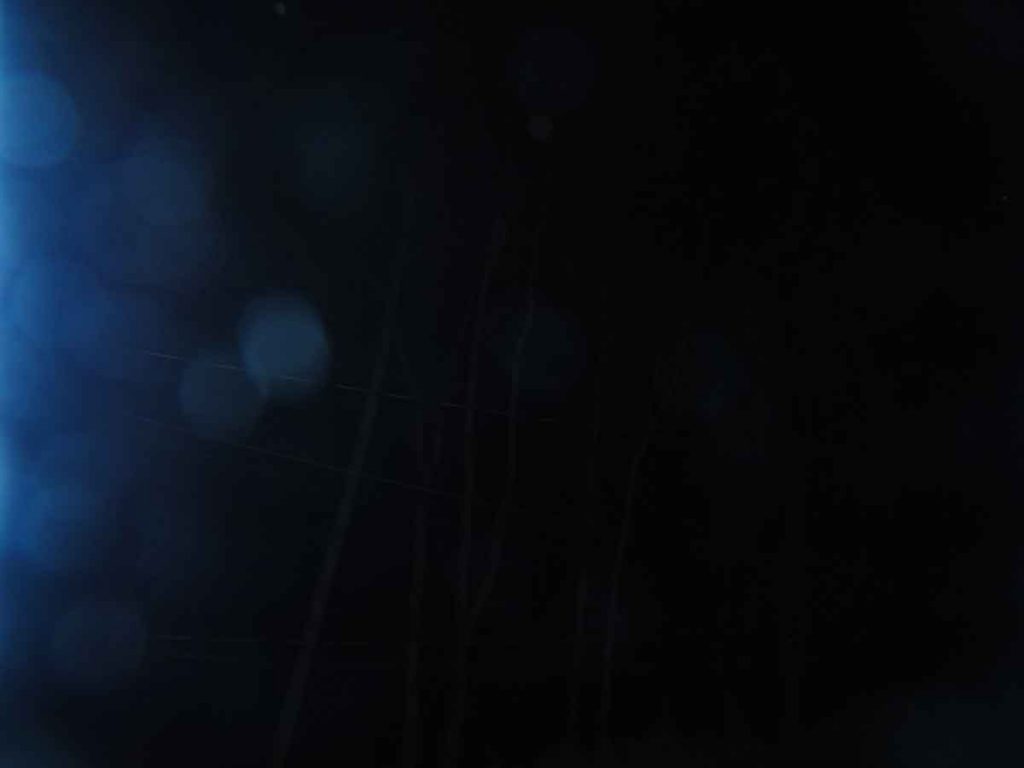
It can be concluded that the red/pink orbs are caused by the flash hitting skin and reflecting back into the camera. It is possible that this was another person that stood close to the camera to the left of the photographer (the flash is on the left side of the lens) or it is possible that the red reflection is from the hand of the photographer who placed one hand in front of the flash either while holding the camera or while trying to shield the camera from rain with one hand. It is likely that in most cases the orbs are caused by fingers or a hand close to the flash and the lens. It is possible, but not highly possible, that they are reflections of another person’s skin that stood very close to the camera.
Bright Blobs
In several images are bright white/yellow areas. One example can be seen in the image below in the upper portion of the image.
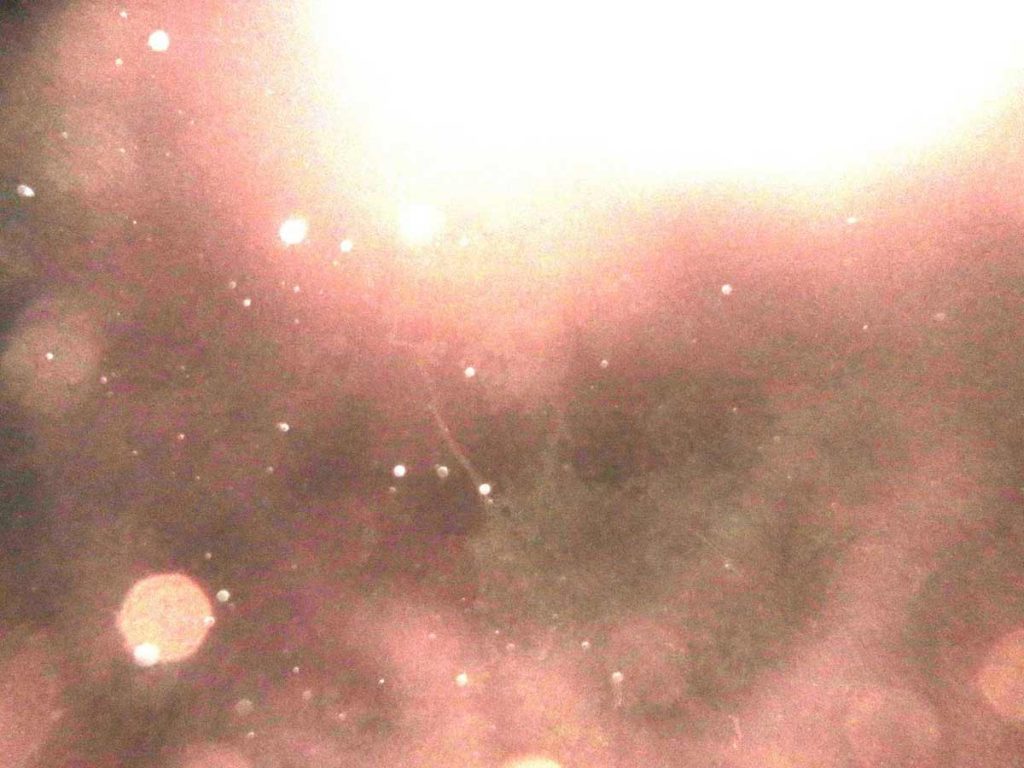
Those “bright blobs” are caused by a skin colored object close to the camera. The effect occurs when an out of focus object near the camera is lit up by the camera’s flash. The reflection leads to the overexposure and the color of the aura comes from the object itself. A white to reddish object is caused by a reflection of skin. For this effect to happen the camera must NOT focus on the object and it only occurs if the object is outside the camera’s focus zones or if the camera misses focus. It is difficult to be 100% certain, but it is likely that many of those “bright blobs” were exaggerated when then image’s brightness and contrast were increased in photo editing software.
Worse, by increasing brightness and contrast, it is possible that even an object in focus was overblown and therefore looks like an object that’s nearer and out of focus. The effect that this basic image manipulation can have on details in the images can especially be seen in the “SOS marker” image, where the existing bright detail (left) was totally overblown and turned into a bright white blob (left).

To test this hypothesis, I recreated a similar image under the following conditions:
- Darkness
- Outside
- Flash used
- Camera missed focus
- Hand placed 5cm in front of lens
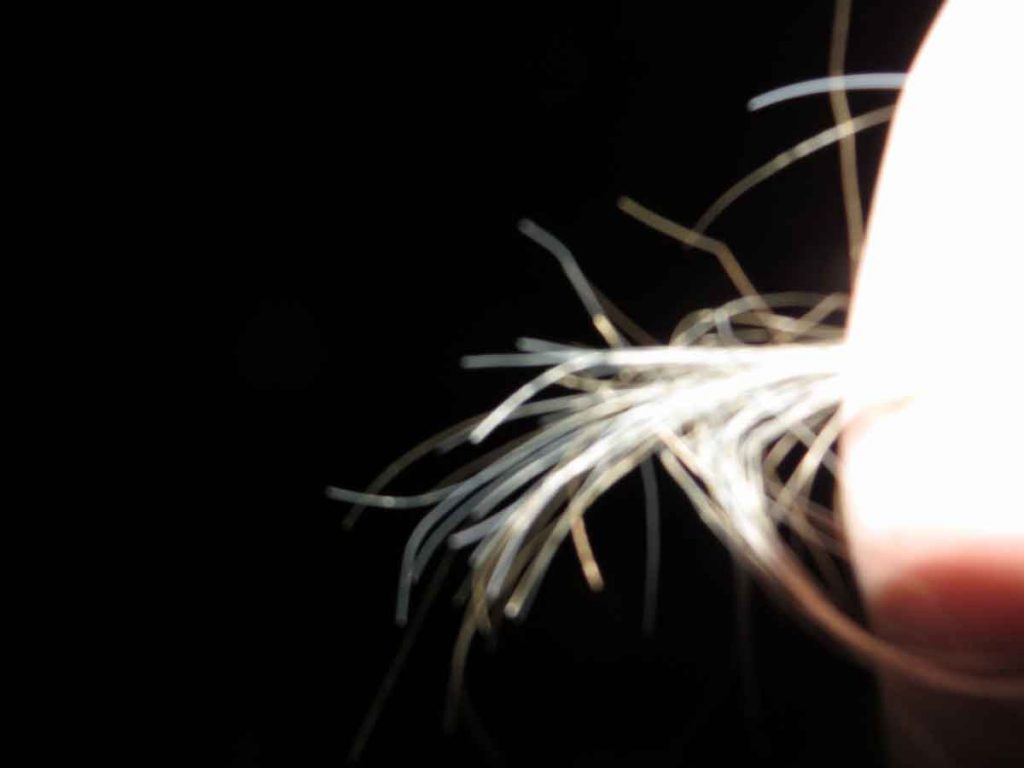
Note, that this image was only created to test the conditions and to evaluate how hair appears under those conditions. The hair itself can be ignored for now. It is clearly visible that the hand itself is out of focus and completely overblown. In the lower area of the image the hand is observed as reddish areas where the flash did not reach. I did not adjust the color or brightness of this image. The original image of the “SOS marker” has more of an aura around the blob which is likely caused by the image being brightened or caused by other slightly differing image conditions.
I was able to determined the distance of the objects in the night photos, by talking a series of images at varying distances from the camera. The Canon Powershot SX270 HS has a documented minimal focusing distance of 5cm in macro mode (which activates automatically), however my Canon Powershot SX270 HS seems to focus even 10-15mm closer. This means that those objects only appear out of focus for two possible reasons: 1. If the camera did not focus on them due to missed focus, or 2. If the image was too far at the edge of the frame where the camera is not able to focus.
I recreated the image below under the following conditions:
- Darkness
- Outside
- Flash used
- Camera missed focus
- Hand placed 5 – 30 cm in front of lens
I also used the image to evaluate how hair appears in the image. Please disregard this for now.
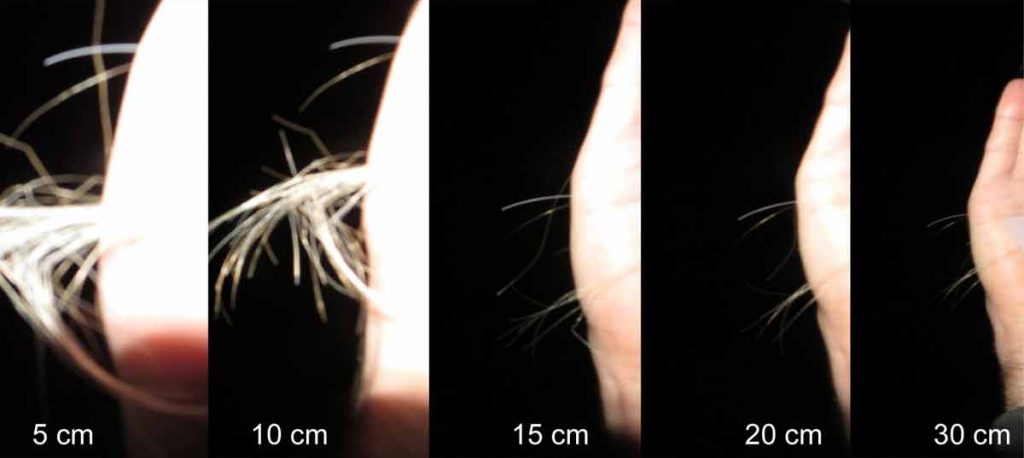
The image at a distance on 15 cm begins to show detail in the hand and the amount of overexposure is decreasing to a point where the image is barely overexposed. At a distance of 30 cm and beyond the hand is nearly in focus and not overexposed. The effect is caused by an optical phenomenon “depth of field” which causes an object to be in focus a certain distance in front and behind the actual focal plane. For wide angle lenses this can mean that it is possible that everything could be in focus that is roughly 1-1.5m to infinity away from the camera regardless of where the actual focal plane is. Many simple wide angled cameras utilize this method of “focusing” since with a fixed focus, a wide lens everything will be in focus.
If the Canon Powershot SX270 HS misses focus, it always reverts to the same focus distance. This means that the focus searches for an object in front of the camera and the camera does not automatically revert to macro focus.
Other possible causes for the bright blobs could be alternative light sources shining into the camera, perhaps like flashlights. I did not further investigated this since it’s unlikely and it is more likely that the blobs are caused by skin colored objects.
It can be concluded that out of focus objects causing those blobs were no further than 10-12 cm in front of the lens.
Image 511
This image is the first available image. It shows the V shaped tree that will be in the majority of the images as well as bushes to the left.
There is strong rain in this image.
Image 512 to 540
Those images are unfortunately not available
Image 541
This image is very interesting and has lead to a lot of speculation. It shows a blob (see above) and additionally, hair. As established above, it is very likely that this image shows skin and hair that was 12 cm or closer from the lens of the camera unless the image is heavily modified and detail lost. However I don’t believe this is the fact since the hair is not overblown.
At a distance of 12 cm the camera can fill the height of the frame with an object of max 18cm in length. The object in its greatest extension takes up 67% of the frame length and the visible portion is therefore 12cm long. However not the entire object is shown and it is likely larger.
It has been speculated that the object shown is part of a face (e.g. cheek/cheekbone/jaw). This is possible. However in order to get so close to someone and take a photo of just those features is very difficult. I have tried this with an artificial head and the best I can do, with many tries, is this:
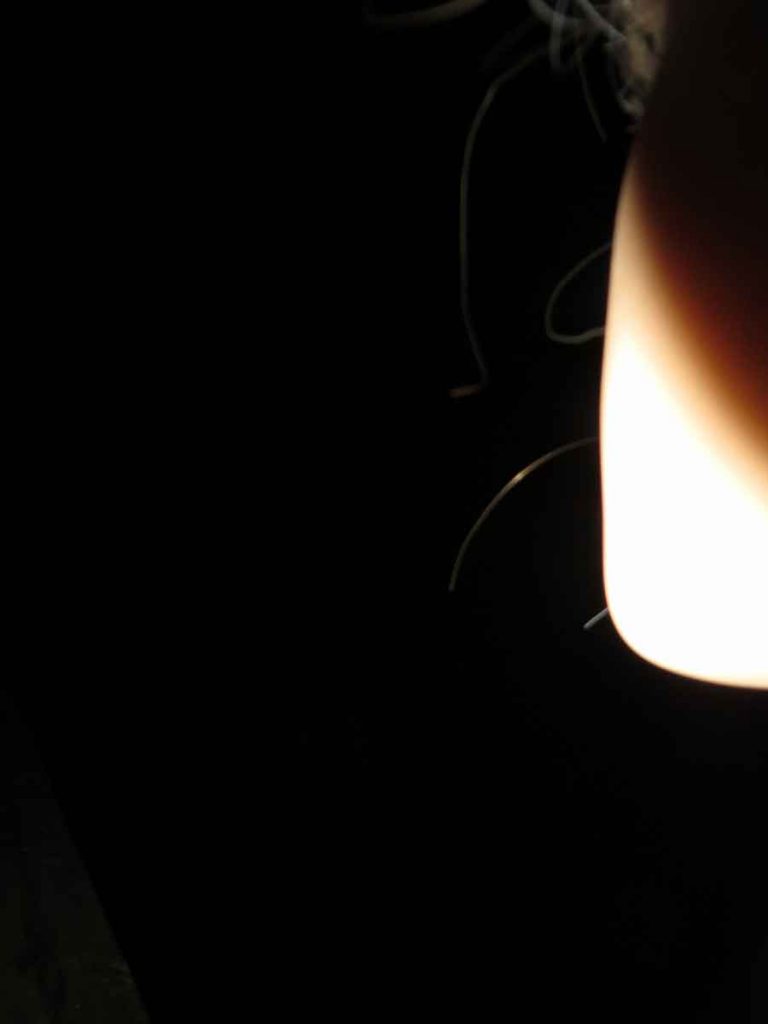
This is a photo of a makeup dummy with wig and hair tied together in a pony tail, so that the hair is out of the way. The photo was taken from behind. The bright area is the “chin”. It is nearly impossible to get as close as necessary. And it would be even more difficult with a real person because their body would be in the way.
Another example of a close up dummy is shown below. There are much more facial features visible.
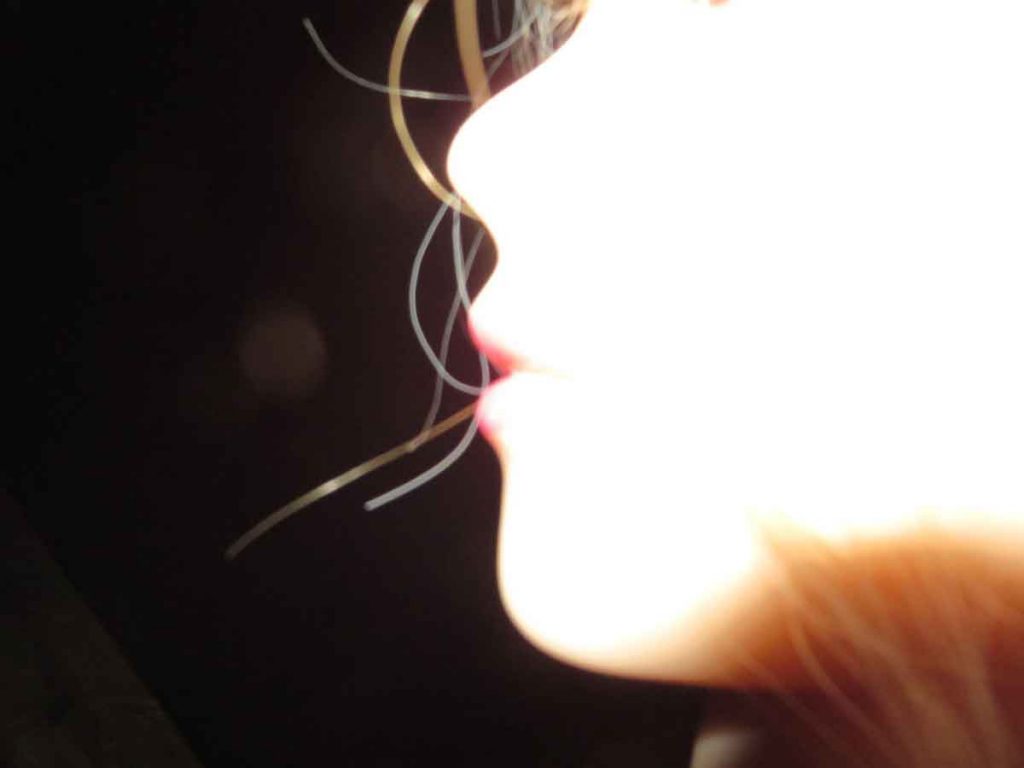
Other possibilities of Photo 541 are that this is someone’s bare arm and we see the elbow in the lower portion on the real image.
Photo 541 also shows one reoccurring problem that we see with many of the images…. even if something is visible, they show very little or it is not distinguishable exactly what they show. Although it is easy to take bad or blurry pictures, it is very difficult to take numerous obscure photos that show something but also show nothing at the same time.
If this photo was taken by either Kris or Lisanne then it shows either a head or arm or arm/shoulders. What exactly it shows is hereby irrelevant if it shows either Kris or Lisanne.
The issue is – how and why was photo 541 taken? I don’t think it was taken on purpose. It must have been taken accidentally. The camera has a built in focus light that impressively illuminates objects and therefore, it is rather easy to take photos in the dark. Photo 541 demonstrates that the focus light was intentionally ignored in taking the photo.
If it was attempted to take a photo of someone, it would have been easy. Even in complete darkness, if the first photo didn’t focus on the desired object properly, there would be several subsequent photos until one photo achieved the desired focus. So photo 541 must have either been taken by accident or it was deemed to be good enough. I believe it was taken by accident.
How was this image taken?
We know the following:
- The subject was no more than 12 cm away from the camera lens.
- The subject was to the right of the photographer.
- The subject was not the intended subject.
- The person was not laying on the ground as otherwise the ground would have shown up in the pic
One way this photo could have been taken is if both the photographer and the subject sat or stood close to each other and the photographer turned to the subject while trying to take a photo of something else and ended up catching the subject at the edge of the frame. Or the subject moved close to the photographer and just ended up in the frame.
Likely explanation: The subject ended up in the frame by accident. It is a photo of a person. The person is standing or sitting to the right of the photographer.
Image 542
This image shows a rockface that slightly slants down into the frame and has a drop after. This image is interesting since it is one of the few images that shows the ground.
The image has been heavily discussed and I like to mentioned what it does NOT shown:
- Monkeys – Those objects are ferns which is evident since the same ferns are in other images.
- People – Those are ferns which is evident since the same ferns are in other images.
- Body parts – Those are light areas on a rock’s surface.
- Animals – There are non visible.
- A steep rock face – The leaves and water on the surface show that it is horizontal or slightly downward sloped.
However, photo 542 does show water. To the right is a small puddle and water is seen flowing into this puddle. The surface of the puddle must be horizontal, which gives us the orientation of the entire rock. Water is flowing into this puddle meaning there is a slight slant.
There are also leaves on the rock face which is further evidence that it is not steep. It is clearly visible that the plants, towards the center of the frame, are lower so there is a drop after the rick face. It is not possible to tell how deep.
Another interesting object in photo 542 is a small spindle or clip-like object (see photo below). This object is very small (estimated 5 – 10 cm long) and reflective. It is possible that it is laying on the rock or is penetrating into the rock. It does not appear natural, but it is not possible to tell what it is or for how long it has been there.
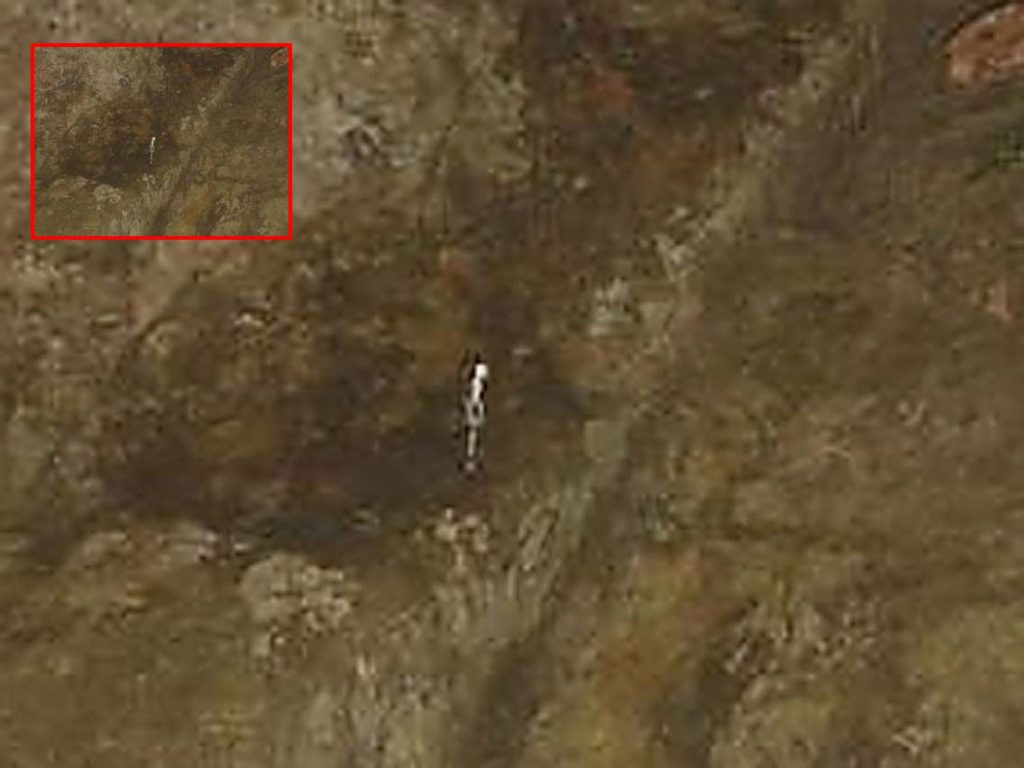
When lighting the image, some rain is visible but the ground is dry or only slightly wet. It is possible to tell that the ground is dry since there is wet ground where the water is flowing to compare. This is remarkable since it was raining pretty strong in image 511 that was taken only approximately 10 min earlier, yet the ground is still pretty dry.
The rockface is likely formed by water erosion so the image must have been taken by a river. It is possible that this is a small waterfall and there is a river to the right. The river water levels are likely low since it had been a very dry season up to April 2014 in Boquete.
Image 543 to 546
Those images do not show anything particularly interesting. Image 546 is the first to show the characteristic bushes to the left and the v tree at the same time and therefore allows putting the majority of images into relation to each other.
There is rain visible in all images.
Image 547
This image also shows the v shaped tree. There is a reddish area, most likely caused by the hand or finger of the photographer. This possibly comes from an attempt to shield the camera from rain with one hand.
There is rain visible in the image.
Image 548
There are no new objects. The image repeats subjects of previous images.
There is rain visible in the image.
Image 549
There are no new objects. The image repeats subjects of previous images.
There is rain visible in the image.
Image 550
This image is very interesting as it appears that an image was deliberately photographed, the twig with the red balloons attached, to be referred to as the “balloon marker”, although it is not likely a marker. Much has been speculated to the purpose of the balloon marker. Most likely the red objects are not balloons but red shopping bags that have been spotted around the Boquete area. It could have been created or been there for the following purposes. The probabilities are scored with the following ratings:
- Very unlikely
- Unlikely
- Possible
- Likely
- Very likely
Signaling device
This is somewhat possible, it could have been used to move around to attract attention of search parties. Although it is questionable how effective it would be due to its small size and waving a shirt or a shirt mounted to a stronger branch would be much more effective. It is not impossible to be a signaling device but not likely.
Probability: Unlikely
To keep insects away
Apparently, such constructions are used by locals to fight mosquitos and it is not impossible that this is its intent.
Probability: Possible
To collect water
It has been speculated that the device constructed from the twig and the red objects was built to collect rain water or to scoop river water. The device looks unsuited for this purpose. First, the twig appear too weak for it to be able to lift a reasonable amount of water without bending or breaking and furthermore the bags are attached in a way that they don’t seem to be able to hold water. It would be more useful to attach one bag and use the twig to spread the bag open. It can not be ruled out that whoever built the device did not have the knowledge or ability in order to construct a better device. It is also likely that the photo was taken at the shore of a river in it might have been easier to scoop up water directly from the river with a bottle. It is possible that other reasons prohibited this and that the intent of the device is to collect water.
Probability: Possible
As a marker/map to mark a location
It has been speculated that the marker is .. well .. a marker. I don’t find it very likely since it doesn’t mark anything… Sure it could mark the location of two locations (balloons) to a river or road (branch) but really it would be next to impossible to find anything based on such a marker. Furthermore there would have been much better methods at hand to mark or document something, for example, taking a photo of it, writing a digital note in a phone, using big rocks and branches as markers or scratching something into the boulder with other rocks. That this “marker” is a marker is therefore very unlikely.
Probability: Very unlikely
Out of boredom
Someone who was confined to this location or was waiting there for searchers for several days could have started to distract themselves by constructing crafts, especially if those could be used to fend off insects. I find this possible.
Probability: Possible
It could have been there before
This object could simply have been there before the photographer arrived in this location.
This is possible but probably not very likely since the photographer has taken the time to take a photo off it which is probably nothing that would be done with a random piece of trash
Probability: Unlikely
By a third party
A third party could have brought this marker to the location.
This is not likely as this person would have either helped a getaway from the location in which case it makes no sense to sit around and take photos of the marker or the person was not friendly in which case it makes even less case to take photos of their brought twig
Probability: Unlikely
It is not possible to determine the reason why this device was created and placed there and also not why a photo was taken. The highest probabilities are that the device Most likely is that it was intended to keep insects away, to collect water or out of boredom. It does not seem to have no particular important purpose.
Further objects on the large boulder are leaves that occur naturally and two pieces of paper. One piece might be a torn-up piece of the tourist map that Lisanne is holding in image 470. The other piece could be a wrapper from candy.
The boulder itself is very large and appears to be a round eroded boulder that is washed free in a river. Therefore it is very likely this photo was taken in a river bed. In the background are light areas visible that could be rapids in a river.
In the image is also a remarkable straight line visible. This line does appear to be man made and could be a cable for a money bridge or a cable that is installed for climbing or other leisure activities. It is not possible to clearly determine what the background in image 550 shows. It could be a rockface or trees.
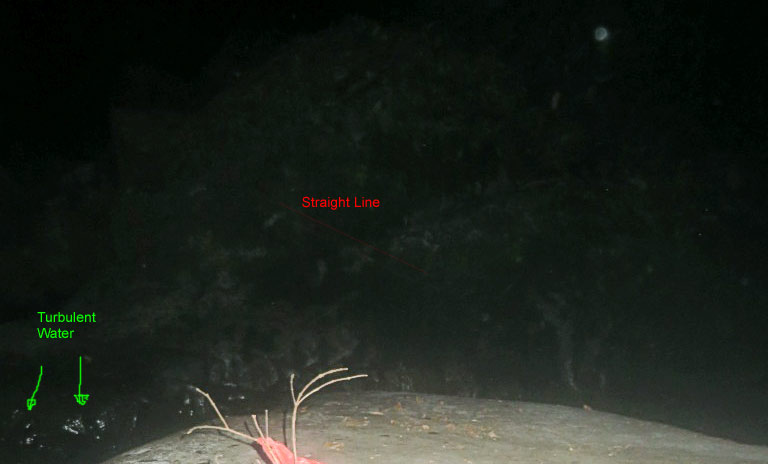
Image 552 to 555
There are no new objects. The image repeats subjects of previous images.
There is rain visible in the image.
Images 556, 559, 561, 562
There are no new objects. However the image shows again a large blob. This could be a person nearby or a part of the photographers hand
I recreated the image below under the following conditions:
- Darkness
- Outside
- Flash used
- Camera missed focus by focusing in a distant dark object
- Fingers within a few cm in front of the lens
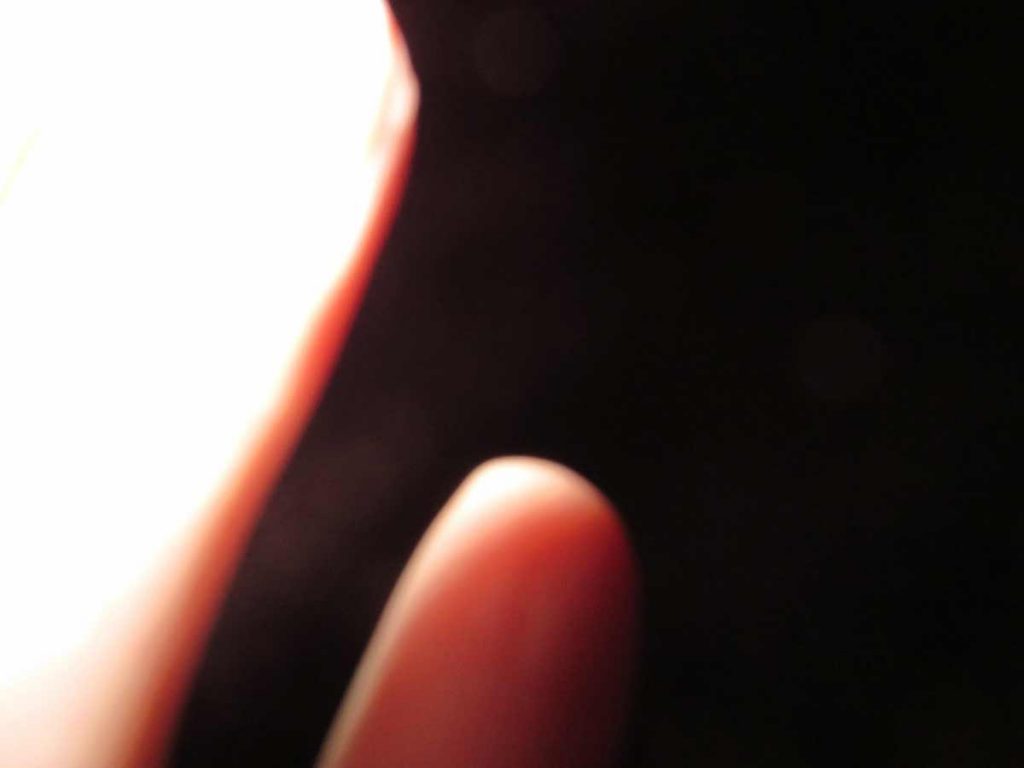
The test image creates a very similar effect to the original. I was not able to recreate the aura effect of the original, however it is possible the aura comes from processing the image. A water on the camera lens does create similar but different effects.
There is rain visible in the image.
Images 565, 567, 569, 570, 572
There are no new objects. The image repeats subjects of previous images.
There is rain visible in the image.
Image 573
There are no new objects. The image repeats subjects of previous images. There is a small blob visible , likely caused be a person nearby or a part of the photographers hand
There is rain visible in the image.
Image 576
This image shows large rocks with objects on one rock. It does not appear as if the objects were photographed deliberately because they are barely visible in the corner of the image. The photographer has demonstrated to be able to take well framed and lit photos so it is likely those objects are in the photo by chance.
Much has been speculated as to what those objects are and again it looks like some pieces are the torn up tourist map Lisanne is holding in image 470. The long silvery object could be the inside padding of a backpack strap. The round object could be the bottom of a pringles can. The remaining objects appear to be tissue paper or paper.
The image below shows the bottom of a pringles taken with flash in total darkness. The can portion of the pringles can was ripped off in one go as quickly as possible to simulate a possible real event.
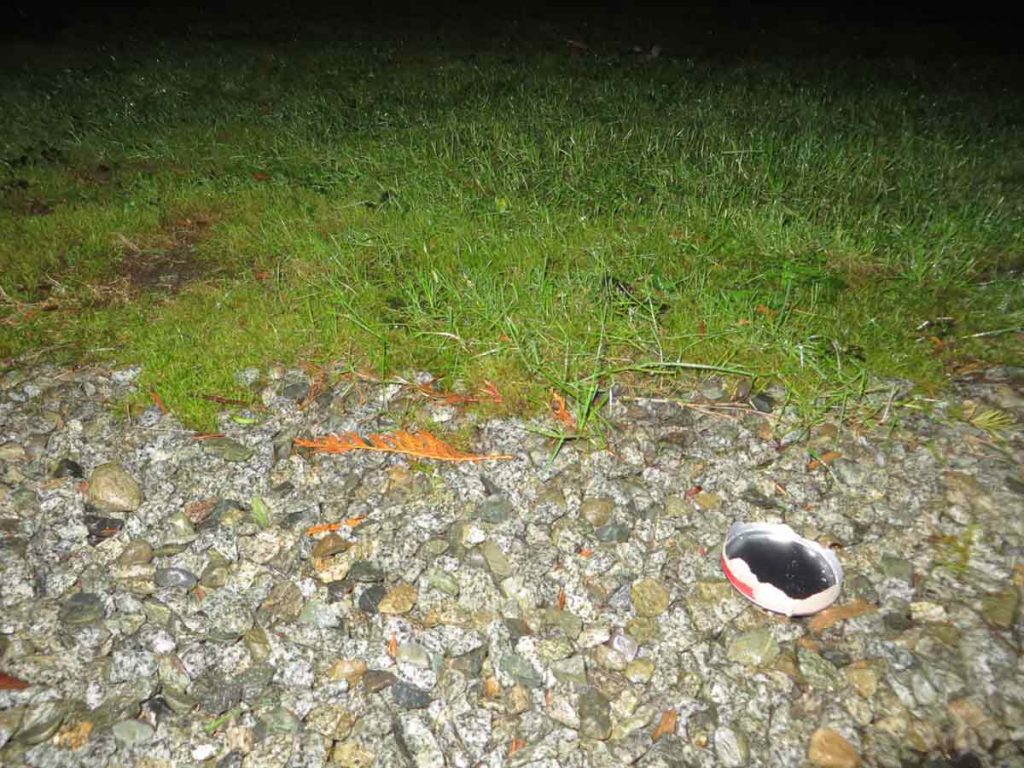
It appears as if some of the tissue paper is arranged around the round reflective piece of the pringles can. The purpose of the objects is unknown. It could be they were used in an attempt to light a fire, although this is not at all how a fire could be created. They could have been placed there in anger but for that they appear to deliberate. Lastly it is possible they were placed as a marker to attract attention.
The exact purpose can not be determined.
There is rain visible in the image.
Image 579
There are no new objects. The image repeats subjects of previous images.
There is rain visible in the image.
Image 580
This is probably the most remarkable of all images since it differs drastically from the others as it clearly shows a person and it is perfectly exposed and focused.
The most obvious assumption is that this shows the back of Kris’ head since the red/blonde hair matches and this is probably the most likely explanation since this type of hair color is extremely rare in Panama and finding a person matching it would probably near impossible. The same applies to it being a photo of someone else wearing a wig, which is probably also very difficult to find locally.
The question who could have taken the photo was already discussed above and I will only post the “stages self pic” (left) for comparison here. It is possible but unlikely that this is a self pic. So it must have been taken by another person.
It is important to remember that the camera has the flash on the left side so the light, especially at close distance would come from the left and cast a shadow on everything on the right that is further away from the camera. This explains the lower right corner where the hair is darker and appears to have a different color. This is caused by the flash being shadowed by the head.

I recreated the image below under the following conditions:
- Darkness
- Outside
- Flash used
- Camera allowed to focus
- Distance of the front of the lens to the head 10 – 12 cm
- Head placed on ground
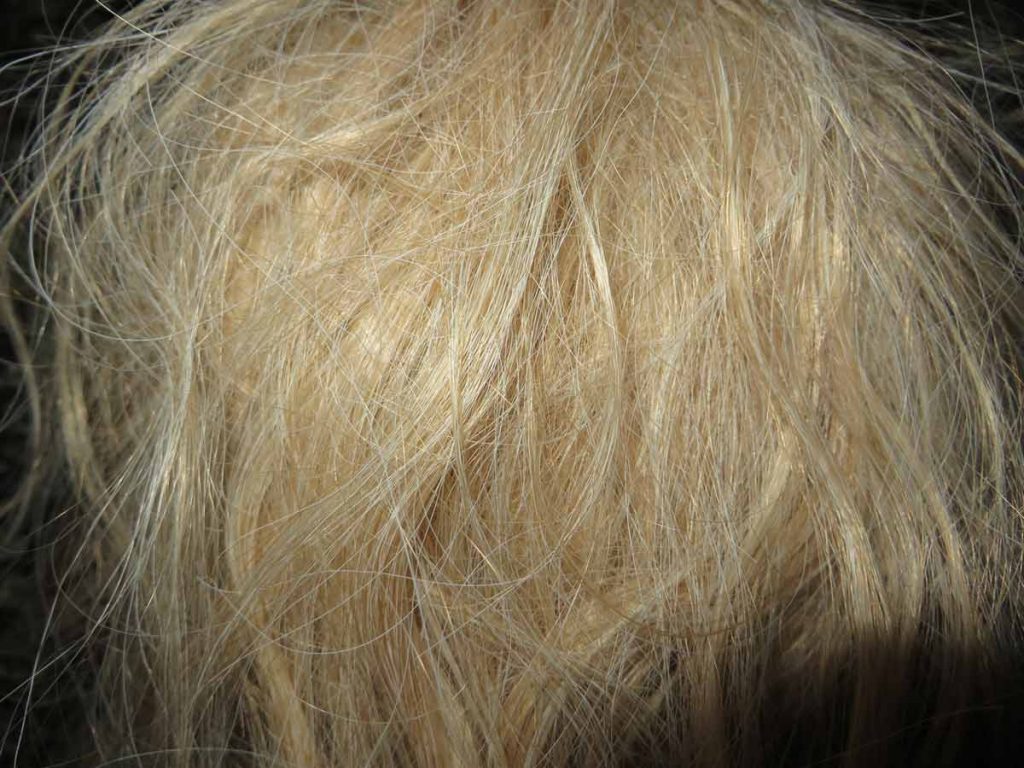
It results in the photo above. It is very difficult to tell if the ground is visible in the photo or not. In the full size original staged photo it is possible to see the ground. However in the resized one it is difficult to tell.
It has been speculated that the person in the photo is incapacitated laying on the ground. However I don’t find this probably since it is unlikely for anybody incapacitated or not to lay with the face to the ground since it is uncomfortable and the head would always try to roll to either side. Therefore it is more likely that the person is sitting or standing when the photo is taken.
The question however is where was Kris? We know that image 580 was taken 107s after image 579 and image 581 was taken 9s after image 580. Both, images 579 and 581 (note add timescale) were taken of pretty much the same area ahead of the photographer. There was not much time to think about taking the photo of the back of the head, walk somewhere in the night, take the photo and walk back and take the next photo, so it is not likely this was done.
Then it must be that the Kris is extremely close to Lisanne and somehow gets into the frame, Lisanne focusses on the back of the head and Kris disappears. Or Kris is to the left or right of Lisanne facing AWAY from Lisanne, Lisanne turns to Kris, focusses on the back of the head in 107s, takes the photo and turns back forward and after 9 seconds takes the next photo.
None of those scenarios seem very likely. It is still most probable that both were close together, Lisanne turns and takes a photo of the back of Kris’ head. This would also explain the other images with blobs and it could be that those is Kris arms and hands and face that got into the frame as well.
(note: add location map)
It is also possible that Kris moved into the frame or Lisanne turned and got Kris into the frame. The following two points do not support this however: The image must have been focused before taken, which take a few seconds and the image shows no motion blur indicating that camera and subject were reasonably at rest when the shot was taken. Otherwise the camera would also not have focused.
The image below was taken under the following conditions
- Darkness
- Outside
- Flash used
- Camera allowed to focus, focus held
- Distance of the front of the lens to the head 10 – 12 cm
- Head moved in front of the camera while photo was taken
There is clearly motion blur visible and it is more likely that both were stationary.
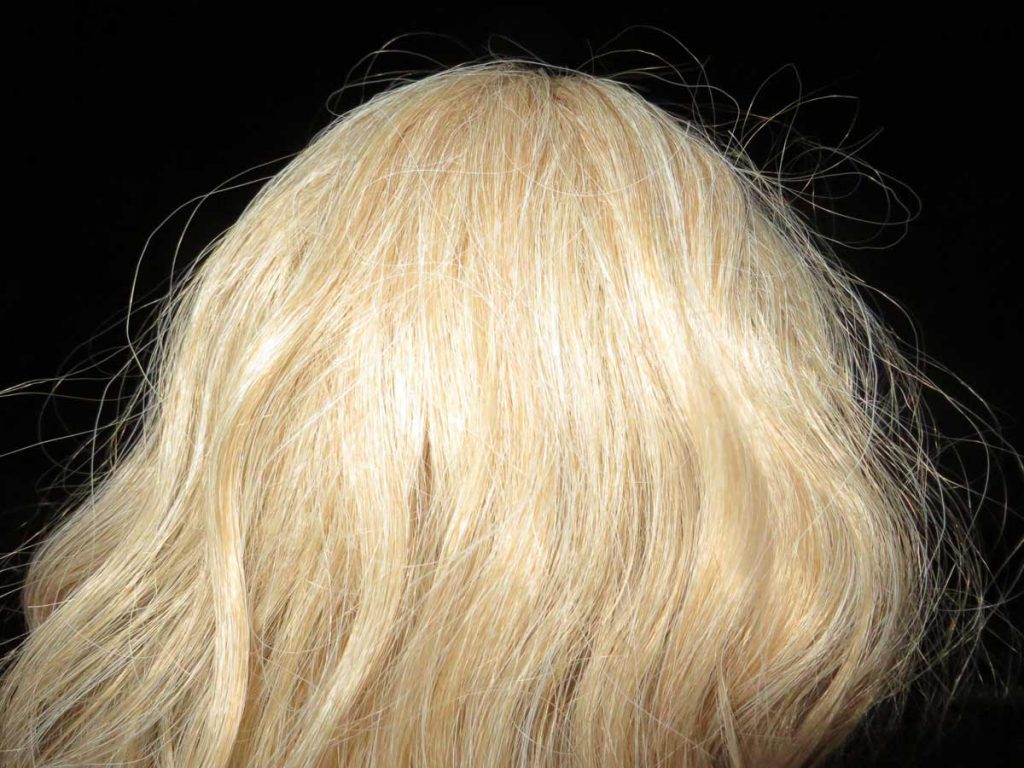
Another oddity is that 80% of all test images I took of the back of the head were very overexposed so that large portions of the hair were blown out as can be seen below.
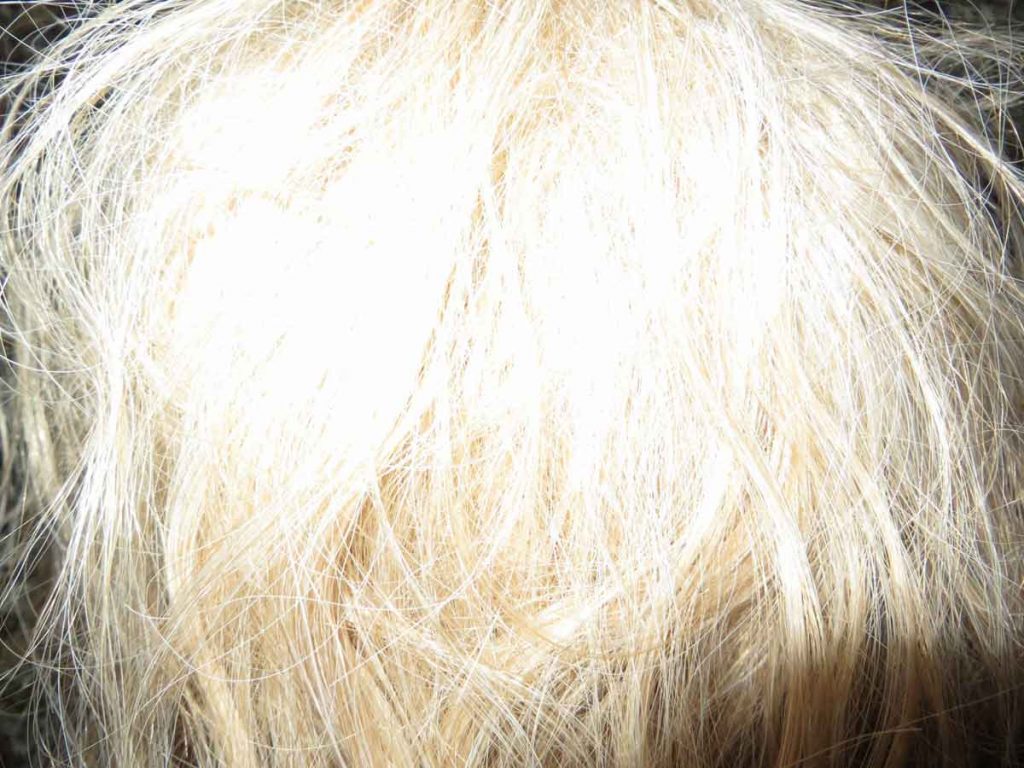
Only 20% if the images were properly exposed as the first one above. This is caused by the camera metering the light different every shot and sometimes measuring a darker vs brighter area. It is interesting that the real image is perfectly in focus and perfectly exposed. Which I only managed in 20% of the time.
This is not where the oddities around this image end. It is astounding that the hair is completely dry, there is not a spec of dirt and not a single leaf or twig or anything in the hair. At the time this image was taken Kris would have been outside for 7 days and 7 nights and it is hardly imaginable that her hair would be completely clean and dry. The only possible foreign object in the hair is in the upper left corner. This could be a leaf or torn piece of paper. It is difficult to say for sure due to the low image resolution. I do not think that it is hair.
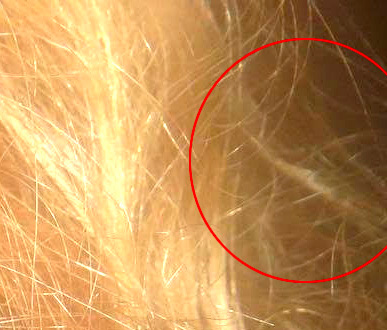
I have taken the image below after 15 min exposure to 40 – 70 mm of rain.
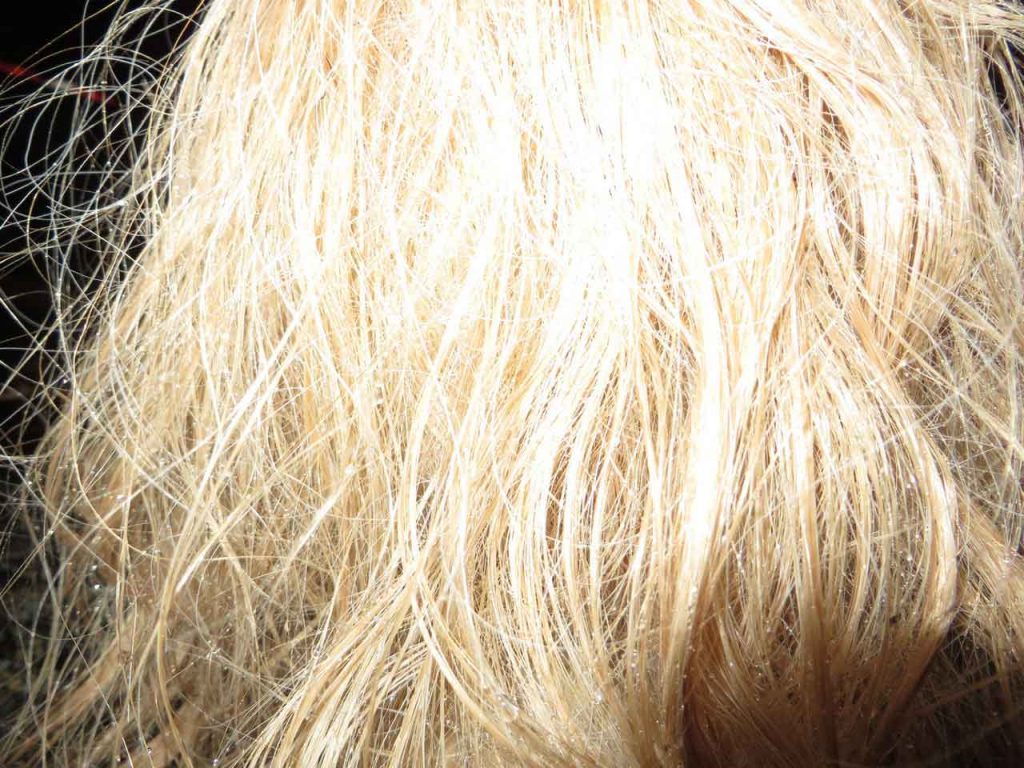
It is very clearly visible that the hair is very wet after only 15 min.
It is strange that there is not a hint of wetness in the original image after it has rained for at least 15 min.
There are another three artifacts in this image that should be discussed (see 1, 2, and 3 in image below). The image is color modified to show more of the artifacts.
#1 shows two dark spots, those are likely shadows caused by two crossing hair strands. It is possible to estimate which strands form those shadows. It has been speculated that this is a nose, but its clearly not since the nose is not in this location and if you measure the distance between the “nostrils” and compare them to a normal picture of Kris, it is clear that the distance of the “nostrils” below is far too great. Other speculations are that those spots are stab, bullet or other wounds. This is extremely unlikely as there is no blood and no disturbance of adjacent tissue.
#2 is also likely to show shadows of hair caused by the flash.
It is not easy to say what #3 is but it is most likely light from the flash reflecting of hair. It has been speculated that those are teeth that form a face together with items 1 and 2, however this is not the case. The image clearly shows thr back of a head facing up (oriented correctly).
All three artifacts are most likely artifacts caused by light and shadow.
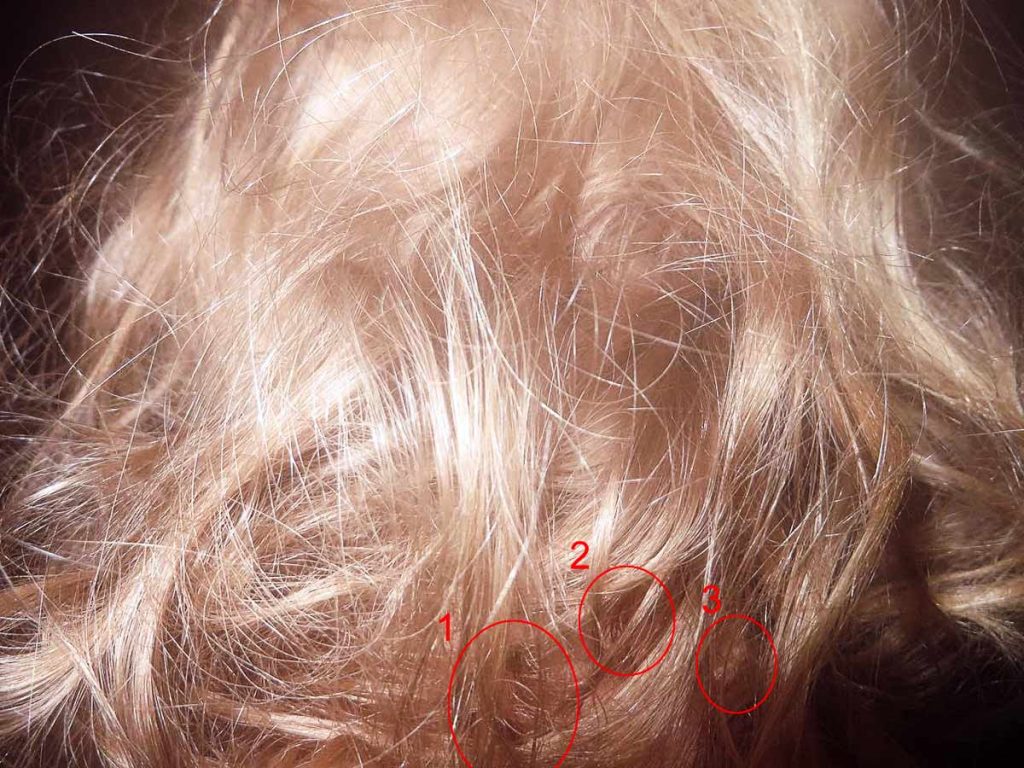
It has been speculated that this image was cropped and that the original shows more of the person, including wounds. It is remarkable that the image is framed in the way to show just hair, which raises suspicion that something might have been cropped out that is not supposed to be visible.
The image has a size of 1280 x 960 pixel which is a ratio of 1.33. The Canon Powershot SX270 HS takes images in a native 4000 x 3000 pixel which also is a ratio of 1.33. Thus, if the image was cropped it was cropped maintaining the original aspect ration. This is no evidence that it is not cropped since most software will have the option or default to maintain the original aspect ration when cropping but it shows it was not randomly cropped.
Another clue comes from the image resolution and pixelation of objects in the image. The more the image is cropped the more pixelated objects will appear.
The image below shows on top a 300% upsized portion of the original image 580, while the bottom is a portion from my head image downsized to 1280 x 960 and then 300% upsized. The pixilation and detail in individual hair is reasonably comparable. Note that the original shows more JPG artifacts which do not influence this analysis.
Although this is also no evidence the image was not cropped, it does indicate that it could not have been cropped drastically.
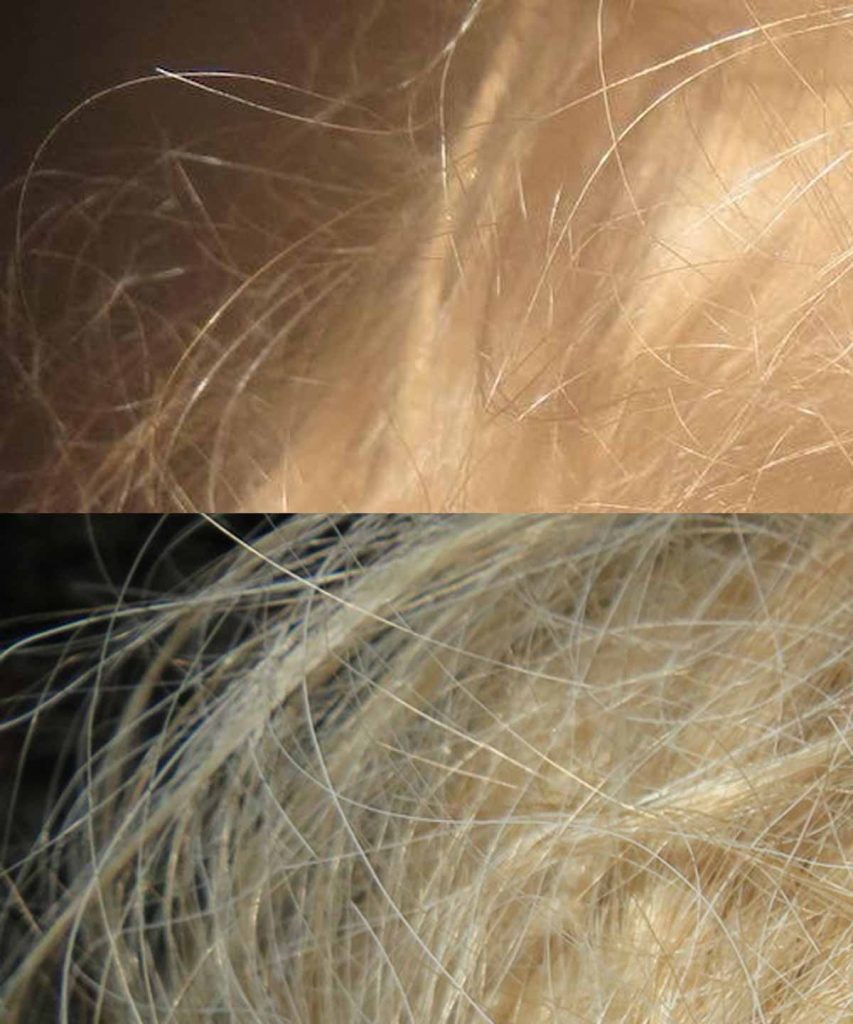
It is known that the families of Kris Kremers and Lisanne Froon disagree on the official police report and that they have the original images. Therefore we can conclude that there is nothing on a possibly uncropped original that indicates foul play, e.g. unnatural wounds as otherwise both families would disagree with the official police report. To be clear, the families had two different stances on the conclusions from the police. The Kremers family disagreed with the police report and sued the Panama government. The Froon family agreed with the police report.
Lastly, I know from a person who has seen the original image that it is not cropped, although this is rather hearsay than hard evidence.
It can be concluded though that it is likely that the image is not cropped.
Image 582
There are no new objects. The image repeats subjects of previous images. It is one of the few images that shows the ground.
There is rain visible in the image.
Image 583
There are no new objects. A slight red blob is visible, likely a reflection of a finger or skin. The image repeats subjects of previous images. It is one of the few images that shows the ground.
There is rain visible in the image.
Image 584
There are no new objects. The image repeats subjects of previous images.
There is rain visible in the image.
Image 585
There are no new objects. However the image shows again a large blob. This could be a person nearby or a part of the photographers hand
There is rain visible in the image.
Image 586
There are no new objects. The image repeats subjects of previous images.
There is rain visible in the image.
Image 587
There are no new objects. The image repeats subjects of previous images.
There is rain visible in the image.
Image 589
There are no new objects. A slight red blob is visible, likely a reflection of a finger or skin. The image repeats subjects of previous images. It is one of the few images that shows the ground.
There is rain visible in the image.
Image 590
There are no new objects. However the image shows again a large blob. This could be a person nearby or a part of the photographers hand
There is rain visible in the image.
Image 591
There are no new objects. However the image shows again a large blob. This could be a person nearby or a part of the photographers hand
There is rain visible in the image.
Image 592
There are no new objects in this image.
There is rain visible in the image.
Image 593
There are no new objects in this image.
There is rain visible in the image.
Image 594
There are no new objects in this image. The image repeats subjects of previous images. It is one of the few images that shows the ground.
There is rain visible in the image.
Image 595
There are no new objects in this image. The image repeats subjects of previous images.
There is rain visible in the image.
Image 597
There are no new objects. However the image shows again a large blob. This could be a person nearby or a part of the photographers hand
There is no rain visible in the image, however this is likely caused by the poor image quality.
Image 599
This image stands out as it is the only of two images that shows above or behind the photographer. This image was taken while the camera pointed nearly straight up and due to the field of view it captured behind or above, which appear upside down in this image.
Image 600
This image stands out as it is the only of two images that shows above or behind the photographer. This image was taken while the camera pointed nearly straight up and due to the field of view it captured behind or above, which appear upside down in this image.
Image 602
There are no new objects in this image. The image repeats subjects of previous images.
There is rain visible in the image.
Image 603
There are no new objects in this image. The image repeats subjects of previous images.
There is rain visible in the image.
Image 604
There are no new objects in this image. The image repeats subjects of previous images.
There is rain visible in the image.
Image 605
There are no new objects in this image. The image repeats subjects of previous images.
There is rain visible in the image.
Image 607
There are no new objects in this image. The image repeats subjects of previous images.
There is rain visible in the image.
Image 608
There are no new objects in this image. The image repeats subjects of previous images.
There is rain visible in the image.
Image 609
There are no new objects in this image. The image repeats subjects of previous images.
There is rain visible in the image.
What do the missing images show?
It is not known if those images show anything of interest or simply the same subjects or possibly even less by being completely underexposed. As mentioned before, we do know that those images can not show anything that disproves the official police report as otherwise the two families would not disagree (with each other) about that police report.
There are statements of the families that all but a few night photos show nothing but black, so this could be correct and those images might show black or nearly black.
With my Canon Powershot SX270 HS it is not possible to take a photo in the dark without the flash firing, which indicates that all night photos must have had the flash fire, unless it was disabled for some images. It is not likely but possible that the flash was disabled inadvertently and images were taken and then this error noticed and the flash turned back on. It is somewhat easy to disable the flash as all that is necessary to press the multicontroller on the back of the camera to the right. It is possible that this happened when holding on to the camera. It is however not very likely that this happened several times.
It is also worth considering how the night images were obtained. It is likely that whoever leaked them had access to the entire image set from the camera. We know there was nothing revealing on those images and it is more likely tha not that they showed simply black so it is most likely that whoever leaked those images did not find them leak worthy and simply did not bother to leak them.
Those images will most likely have looked similar to this:

Why were the photos taken?
In order to answer this question we list all reason why those images could have been taken and then try to select the most likely one and rule out unlikely ones.
- To scare off predatory animals
- To scare off annoying animals
- To light up / find a path / location
- Out of boredom
- Out of panic
- As a signal
- To scare off ill meaning people
- To deceive (taken by another person)
- Images inadvertently taken (by other person)
- To document something for the future or loved ones
The probabilities are scored with the following ratings:
- Very unlikely
- Unlikely
- Possible
- Likely
- Very likely
1. To scare off predatory animals
The most likely predator in the area are mountain lions. They are not likely to stalk adults, especially not two, however they might be more likely to be attracted by injured adults or adults with reduced mobility. Mountain lions however are ambush predators who stalk their prey unseen and then attack from cover to surprise and overwhelm their prey. This does not fit the images being taken over a time span of almost 3h.
Other predatory animals are alligators and snakes but it does not seem likely someone tried to scare such slow moving animals over a period of nearly 3h without getting the animal in at least one shot. Also the majority of the images were taken above ground in the same general direction, making it further unlikely that they were used to scare off a predatory animal.
Probability: Very unlikely
2. To scare off annoying animals
It is possible that there were animals that were making noise or were annoying for other reasons that were supposed to be scared off. This is unlikely for the same reasons as above and if there were such animals around they would likely be there every night and pictures be taken in several nights. If those animals were annoying and approached humans they could not be scared and it is likely that they would have come close enough to be in an image. For example monkeys or smaller mammals would be possible, although they are likely too shy to approach humans
Probability: Very unlikely
3. To light up / find a path / location
One possible reason to use the camera is to light something up instead of using a flashlight. The Canon Powershot SX270 HS has three sources of light: the build in flash, the LCD and the green focus assist light.
It is theoretically possible to replay an image on the LCD, turn the camera around to face the LCD in the direction to be lit and use the light coming off the LCD as a light source. This only works in theory as there are several issues with it. The light is too dim to see anything except a few cm away from the camera and that assumes that a mostly white or bright image is displayed. It does not work well enough to be used, especially not if there is moonlight, that will be more useful to use and the other light sources of the camera.
The focus assist light will come on when the shutter is half pressed and reaches surprisingly far, it turns on when the camera focusses and stays on while the shutter is half pressed. In the dark in can be used to light up several meters ahead and it is useable as a light source if nothing else is available. It is very easy to inadvertently press the shutter all the way and take an image. It could be speculated that this is exactly what happened and this is why the night photos were taken. I don’t believe this to be likely though as where the majority of the night images were taken was not much to be lit up and if this method was employed, it is likely that it was used on other nights and more inadvertent images would have been taken on other nights.
Probability: Unlikely
Lastly, the camera has the built in flash that can be used as a light source. There has been much speculation if it is possible to use the flash as a flashlight and a simple experiment with the camera shows that it is very possible and works reasonably well. The flash lights up to 10m ahead for a moment and together with the image remaining “in the eye” it is quiet possible to walk around very slowly by lighting up sections in front.
If this is the reason those images were taken is questionable. The photographer would have most likely reached the location where the images were taken during the day as they had time to create and place the SOS marker and the balloon twig. Doing all this at night is not very easy and not likely and it the flash would have been used to help so that there would have been more images of those objects. If it is assumed the photographer reached the location during the day, they would have known what it looks like and there would be less reason to light it up by night for orientation. Also if that was the goal, more of the ground and surroundings would have been lit up rather than the same spot above.
Probability: Possible
In summary it is unlikely that the images were taken as a by product of illuminating the surroundings.
4. Out of boredom
If the photographer was constraint to the location the images were taken for unknown reasons, it is possible the images were taken out of boredom. If it is assumed the photographer was not able to or did not want to leave the location then the question arises what one does all day and all night sitting in the same spot. Aside from the need to forage for food and water there would not be much to do and it is possible the photographer simply became bored and started playing with the camera taking pictures. I do not believe this to be the case since at the time of the images being taken the photographer was likely being affected by hunger and some amount of panic or unrest. Additionally if photos were simply taken by a bored person, they would show more playful things like persons, hands, feet, selfies and would be taken on different days as well.
Probability: Very unlikely
5. Out of panic
Following the thought process of the previous point, if the photographer was constraint to the location and in a state of restlessness, hunger and unrest in a rainy night, it is not impossible to believe that the photographer simply panicked, maybe spooked by animal noises and started flashing the camera to create light, together with the hope to see something that spooked them. For this the images were taken over a too long time (2:40h) and they are too purposely aimed at one location. Images taken in a panic would be unaimed directed at several locations and not focused on mostly one location
Probability: Very unlikely
6. As a Signal
Most of the images were taken of the same spot above the photographer and there is nothing of interest visible in this location, except a tree branch that does not seem to hold any significance. Even if it did it would be sufficient to take a few images but not dozens of images over nearly 3h. It is a remarkable coincidence that official searches were conducted between 7 -11 April. It is reported that some of those searches were conducted into the late evening. However none of the searches were conducted in the night. There has been speculation that the images were used to signal search parties who searched at night or to helicopters that searched at night. This has to be rejected as cause since the searches were not conducted at night. There is not much verified information but at most, some searches were taken into the late evening. Even unreliable sources do not put searches past midnight so the searchers would not be around when the images were taken in the early morning. Aside from this, no searches are undertaken in the night unless in the most extreme circumstances for the reason that there is no benefit. Unless it is believed the lost person will face certain death at night, it is in all instances better for the searchers to rest at night and search at first daylight. Night searches are also dangerous and slow and require additional light gear that has to be brought. That this expensive activity was done by Sinaproc is not likely at all. They would also have needed night teams that rest during the day as otherwise they would search at night and have to rest during the day when a search is faster and more effective. There remains the theory that the flash photos were used to signal search helicopters. Although this makes sense in principle, there is no information that helicopters flew at night. In fact, for cost reasons there were only a few helicopter flights at all and those were during the day. Flying any aircraft by night requires a specialized pilot that is rated to fly by instruments (IFR flight) in addition to a helicopter equipment with night vision gear. Flying helicopters at night is extremely dangerous and rarely done. It is even more dangerous over mountainous terrain. There absolutely no reason to believe that Sinaproc had an IFR pilot, night flying helicopter with thermal vision (to see any lost person at night) and took the cost and risk to fly it at night. Sinaproc conducted a few flights during the day only. So it can be ruled out that the night photos were taken to signal a searching search party or helicopter.
However it is possible that the images were used as a signal. There is some probability that the photographer was somewhat near a house or village and was able to see light in the distance. Or they were able to hear something like farm animals or people and flashed in the general direction of light or sound. It is also possible that they saw a search parties night camp, their fire or lights and flashed in that direction. Although it can be ruled out that the images were used to signal an actively searching search party, it is possible that they were used to send a light signal into a direction where sound of people or animals could be heard or light from houses or camps could be seen. This would explain why the majority of photos were taken pointing in the nearly exact same location.
Probability: likely
7. To scare off ill meaning people
The camera could have been used in attempt to scare off ill meaning people. It is not likely that any such person would be scared off by a camera flash.
Probability: Very unlikely
8. To deceive (taken by another person)
There is much speculation that there are third parties involved in this case and that the images underwent some sort of manipulation or were taken in an attempt to mislead or deflect from what truly happened. The oddity that there are two images (image 580 [head] and image 550 [ballon twig]) that so not fit into the rest of the images since they seem to have been deliberately taken of objects.
An involved third party could have taken the images to create the illusion that Kris and Lisanne were conscious at a certain location in the night of 8 April 2014. In order to create this illusion it would have been better to take those images during the day and of both Kris and Lisanne, unless Kris and Lisanne were not available to be in the night photos or they might have been in a condition that would indicate foul play or they might have been unwilling to participate in such activities. The fact that only the back of Kris’ head was photographed would support this theory since it would not show and revealing facial expression or injuries.
Of course the question remains why someone would even undertake the effort to do that in the rain in the night over a period of several hours. It seems too much effort when a few images during the day can be taken and be more convincing. Everything those image are doing is raise suspicion and question which would be the exact opposite of the intent for too much effort. It cold be considered that the images were taken by a psychopath in order to create confusion and in order to cause pain for the relatives. This type of activity seems to be pretty rare, even amongst psychopathic murderers and it would likely have been followed by more such activity but none is known.
Probability: Unlikely
9. Images inadvertently taken (by other person)
Since the backpack was found by a local native person, it is possible that its contents were examined, and the camera found. The camera could then have been played with or used to take photos. Additionally, children could have used the camera and played with it and taken photos. Although those are two possible scenarios, we would see images of something other than night sky, since any people or children who used the camera would have taken some images by day and of something of their interest or people. Those people would not have spent a night in the rain and snapped photos for nearly 3 hours. It is possible that people did take photos and that they were deleted before the camera was handed in to the police. In this case there would have been some images recovered. Unless the images were securely deleted but since there is little motive and possibly not enough knowledge to do so in a remote village. However it is possible that image 509 was securely deleted and if that is case maybe more images were securely deleted. This though is no reason for the night photos to have been taken by such person.
Probability: Very unlikely
10. To document something for the future or loved ones
It is possible that the photographer wanted to document something for themselves like a landmark or location or they wanted to leave photos for loved ones. This does not seem likely since it would have been enough to take a few images of the tree branch and not dozens of images over nearly 3h. Additionally, the images would then show anything more remarkable, like persons, selfies, etc. lastly if the intent was to take images of locations for orientation, those images would have been taken over days during the day.
Probability: Very unlikely
Summary:
| Intention | Probability | |
|---|---|---|
| 1 | To scare off predatory animals | Very unlikely |
| 2 | To scare off annoying animals | Very unlikely |
| 3 | To light up / find a path / location | Unlikely |
| 4 | Out of boredom | Very unlikely |
| 5 | Out of panic | Very unlikely |
| 6 | As a signal | Likely |
| 7 | To scare off ill meaning people | Very unlikely |
| 8 | To deceive (taken by another person) | Unlikely |
| 9 | Images inadvertently taken (by other person) | Very unlikely |
| 10 | To document something for the future or loved ones | Very unlikely |
Out of the ten possible reasons the photos could have been taken, seven can be rejected as being very unlikely. Two are unlikely and only one is likely (as a signal).
It is possible that there is more than one explanation and a combination of reasons should be considered, rather than rejecting all unlikely reasons. Out of 100% motivation for taking the images we can arbitrarily attribute 75% to the likely reason (camera flash was used as a signal) and 25% to the unlikely reason (camera flash was used for illumination).
This means that over the period of 2h40min, the majority of images would have been taken as a consequence of using the camera flash to attract the attention of someone in the distance that was noticed by sound or light and while the photographer was up in the night might have used a few flashes to light up the area around them to orientate themselves or to make sure they don’t move to close to ledges or edges of boulders. This does not explain the image of Kris’ head, unless she got in the image inadvertently or there was another unknown reason why the image was taken.
Out of the ten possible reasons the night photos could have been taken, seven can be rejected as being very unlikely. Two are unlikely and only one is likely (as a signal).
It is possible that there is more than one explanation and a combination of reasons should be considered, rather than rejecting all unlikely reasons. Out of 100% motivation for taking the images we can arbitrarily attribute 75% to the likely reason (camera flash was used as a signal) and 25% to the unlikely reason (camera flash was used for illumination).
This means that over the period of 2h40min, the majority of images would have been taken as a consequence of using the camera flash to attract the attention of someone in the distance that was noticed by sound or light and while the photographer was up in the night might have used a few flashes to light up the area around them to orientate themselves or to make sure they don’t move to close to ledges or edges of boulders. This does not explain the image of Kris’ head, unless she got in the image inadvertently or there was another unknown reason why the image was taken.

The images must have been taken at the shore of a river, in fact it is possible to imagine reflection of streaming water in image 550, which is most likely the river. There are not many other possibilities of white reflective surfaces in the jungle so it is very likely to be a river.
In image 550 is also a remarkable straight line visible. This line does appear to be man made and could be a cable for a money bridge or a cable that is installed for climbing or other leisure activities. It is not possible to clearly determine what the background in image 550 shows. It could be a rockface or trees.

When were the night photos taken?
In order to determine when the images were taken it is only possible to go by the EXIF data that was contained in image 542 and 550.
This data shows the images to be taken at 2013:04:08 12:38:12 and 2013:04:08 12:39:54 camera time. The camera time was however not set correctly and the correct times are taken from Scarlet’s website (link – about 30% down the page).
The table below shows the times of the images when they were taken. Missing times were interpolated. Times that are obviously wrong, for example times showing several images to be taken at the exact same time or at impossible intervals, e.g. 1s were also interpolated.
The mistakes in the times is likely caused by whoever leaked them having made mistakes when taking the EXIF information. In Principle it is not relevant if the actual time an image was taken is slightly incorrect as long as the majority and the times they were taken in relation to each other is largely correct. Delta T shows the time elapsed between images. Note that the Canon Powershot SX270 HS averages at maximum 6.5s per image with full power flash as would be used at night.
Did the photographer move while taking the photos?
When overlaying the images it becomes apparent that although there are the same features in multiple images, they do not line up perfectly, even when rotated to match, in several cases the angle of view and the size of objects is different. This could have two reasons, the photographer moved between shots and the different distance to the objects caused them to be of different size in the images or it is caused by distortion of the camera lens.
In order to rule out camera lens distortion I took several images from the same point but with the camera pointed up and down facing the same object.
The results show that the resulting images can not be overplayed. Below are the two source images followed by an overlay where one images is rotated to match as closely as possible and overplayed at 50% transparency. It is not easy to see details but the features in the images clearly do not line up.

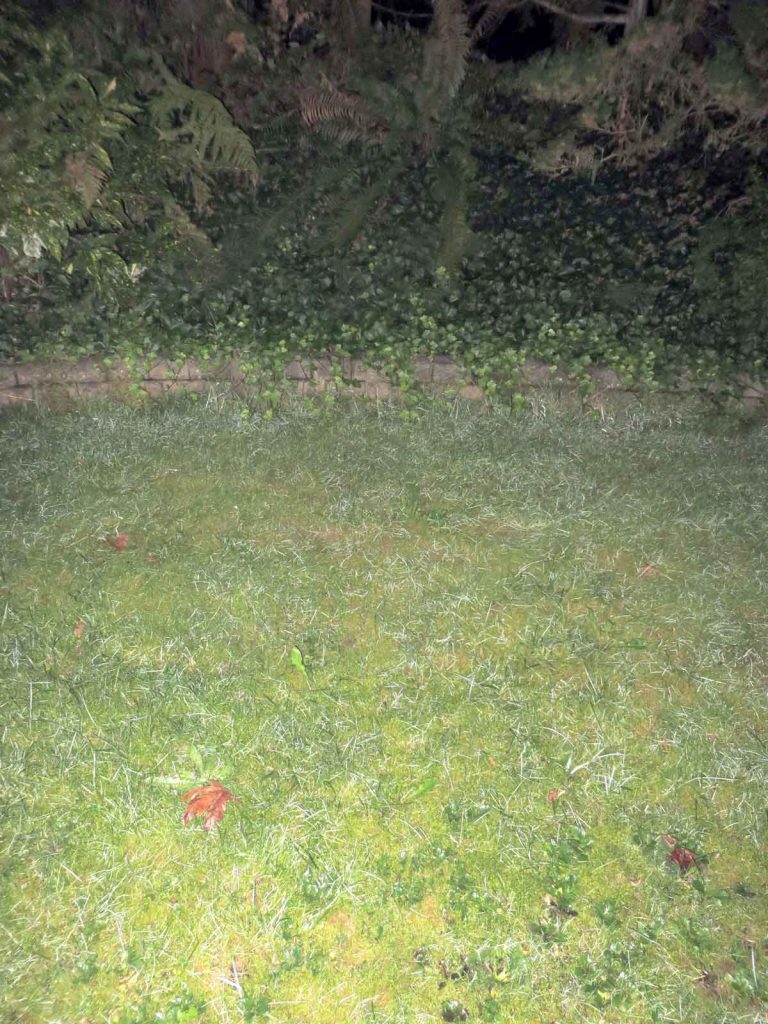
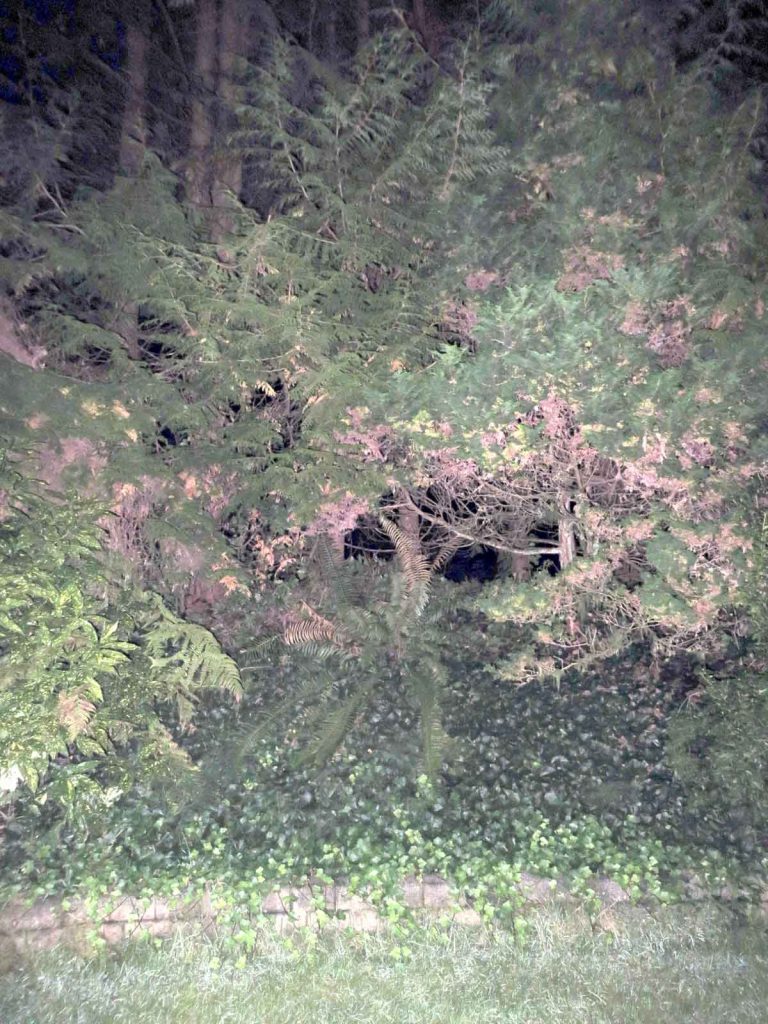
Unfortunately it is not possible to clearly determine if the photographer in the original night images moved or if the distortions are caused by the camera angle.
Distance Analysis
Since the size of the objects in the night images is not known it is not easy to estimate distances of the objects in the images. It is however possible to gain an estimate by the amount of light reflected from the objects. Since the camera flash has a defined maximum power and that maximum power is used in complete darkness since the camera tries to light up the scene, we can create comparison images taken under the same conditions and then compare the brightness of the objects.
The following sequence was taken under the following conditions:
- Darkness
- Outside
- Flash used
- Camera missed focus by focusing in a distant dark object
- Image distance: 8.5, 12, 15, 17, 21, 24m
Note that the images were resized so at this point the actual size of the objects is to be ignored. Focus should only be on brightness of the objects and color rendition.
The image on the very right is the most lit original image (image 590). The object to compare shall be the V shaped branch in image 590 and the center tree in the control images with the branch pointing in thw 2 o’ clock position.
At 24m the branch is nearly not visible anymore and contains no color information, so this distance is further than the branch in image 590. The color rendition and lightness of image 590 is matched between images 17m and 21m. Therefore we can conclude that the branch is between 17 and 21m away and probably closer to 17m since at 21m it ha already lost all color detail. At 15m the rendered color and detail is much to bright so this confirms the distance being 17 -21m.

At 24m the branch is nearly not visible anymore and contains no color information, so this distance is further than the branch in image 590. The color rendition and lightness of image 590 is matched between images 17m and 21m. Therefore we can conclude that the branch is between 17 and 21m away and probably closer to 17m since at 21m it ha already lost all color detail. At 15m the rendered color and detail is much to bright so this confirms the distance being 17 -21m.
It is further possible to estimate the diameter of the branch in image 590 by comparing the diameter of the control branch in the 17m image.
For this, image 17m is rotated so that the branch is in roughly the same orientation as that in image 590. Since the dimeter of the branch in image 17m is known to be 15cm at the red line, the correlation to 1 pixel to 1 cm can be made and this applied to the pixel size to the branch in image 590. By doing that it can be calculated that the diameter of the branch in image 590 is 11 cm and 25– cm at the two red lines. Note that there is some error in this estimation since the exact distances of image 590 is estimated and the branch in image 590 is not parallel to the plane of the camera.
However it gives us the ability to say if the tree is a pretty sizable tree and not a small branch.
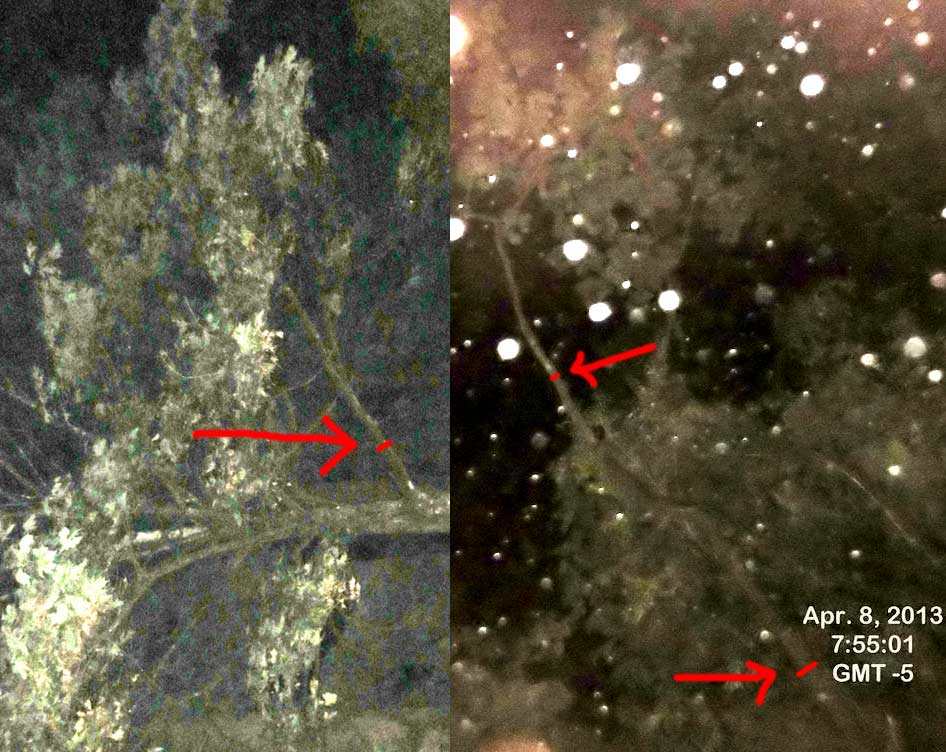
Another image where it is important to know distances is Image 590. Where it is likely that the image shows the opposite shore of a river.
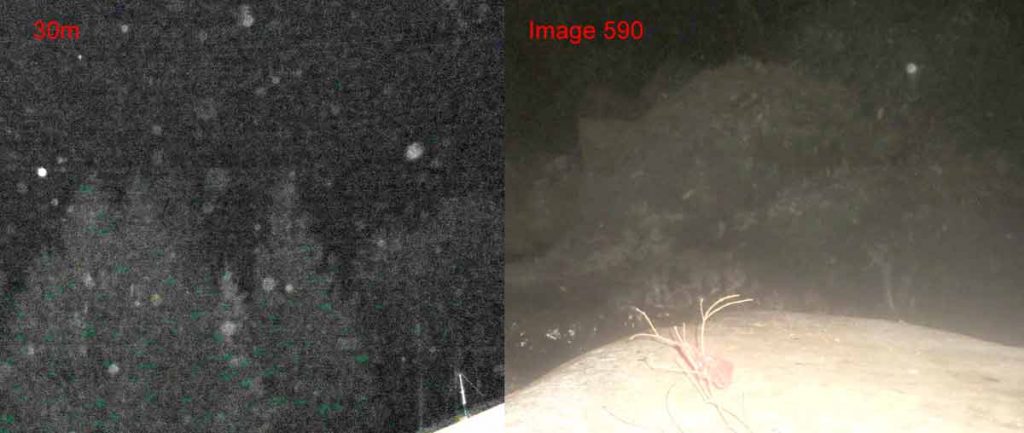
Another image where it is important to know distances is Image 590. Where it is likely that the image shows the opposite shore of a river.
The image on the left was taken at night with full power flash, while on the right is image 590 with brightness increased as much as possible and the bright rock cropped so that the background stands out more.
It is not easy to make a good comparison since it is not known what is in the image. It could be a rock face or treas. However the objects do show some color rendition while the 30m images has no color left. Therefore it is likely that the objects in the background of image 590 are less than 30m away.
Were the night photos manipulated?
There has been much discussion if the night images were manipulated. This is not an easy question as there are multiple ways to manipulate a digital image series:
- Image was not taken in the series or at a different time
- Image was cropped
- Image has details cloned out
- Image had detail added
- Image time and date was manipulated
- Unrelated images were inserted
- Images were deleted
The following assessment reviews the likelihood of image manipulations.
The probabilities are scored with the following ratings:
Probability: Very unlikely
Probability: Unlikely
Probability: Possible
Probability: likely
Probability: Very likely
- Image was not taken in the series or at a different time
Most of the images shows more or less the same overlapping objects (branches, rocks and trees). While two images, Image 550 (Balloon Rock) and Image 580 (Head) do not fit into this series. Both images also seem to have an intent as they show well composed objects.
The likelihood that any of the images showing branches, rocks and trees were taken at different times and inserted is very unlikely since there is no reason and they all reasonably match.
However Images 550 and 580 do not match the general series of images and them being there is odd. Therefore there is at least the possibility that those were taken at different time. This is less likely for image 550 since EXIF data for it exists placing it with the other images meaning that at lest one of the images that doesn’t fit was either extremely manipulated (EXIF edited) or it was taken within the series.
Probability: Possible
- Image was cropped
Any image that has an aspect ration other than 4:3 was certainly cropped since that is the aspect ratio of an original Canon Powershot SX270 HS image. All night images have an aspect ratio of 4:3. This is not evidence they were not cropped but there is no evidence that they were cropped based on the aspect ratio.
Another method to look for cropping is by comparing image artifacts. Several images have orbs in the image that were discussed above. If those orbs move within the image, it is clear evidence the image was cropped. If they remain in the same location between images it is evidence they were not cropped.
Below is image 547 with all orbs marked. This image has the most visible orbs and is used as reference.
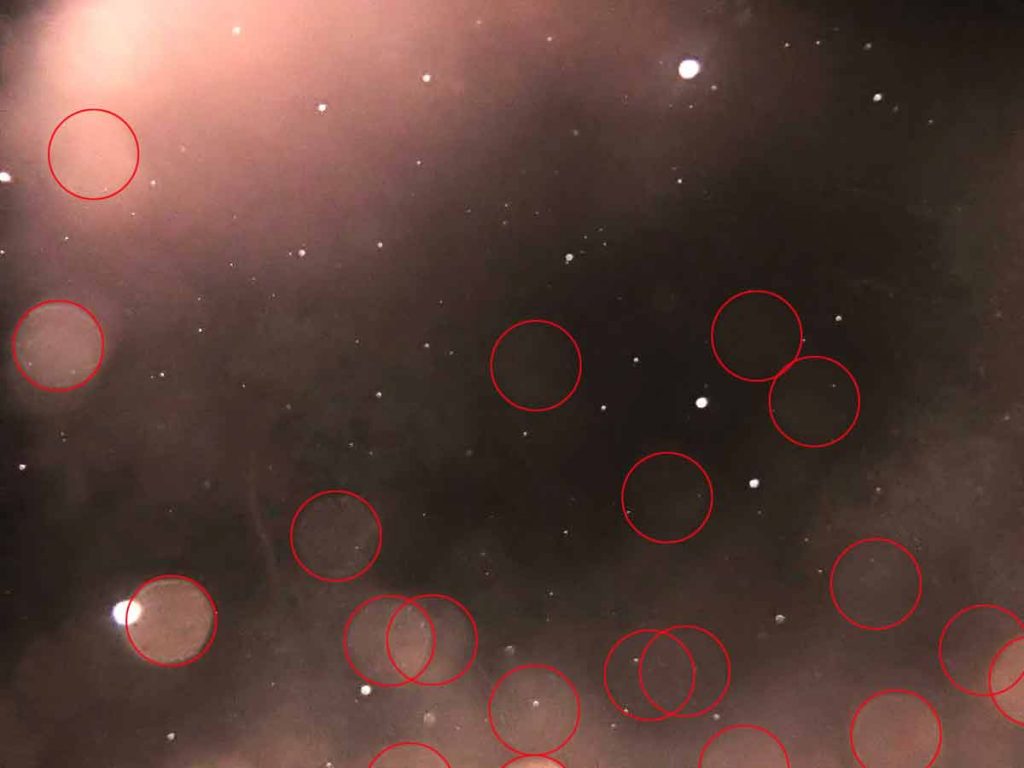
For comparison shown below are images 565 and 591. All orbs that are in the same location match exactly, which is evidence those images were not cropped.
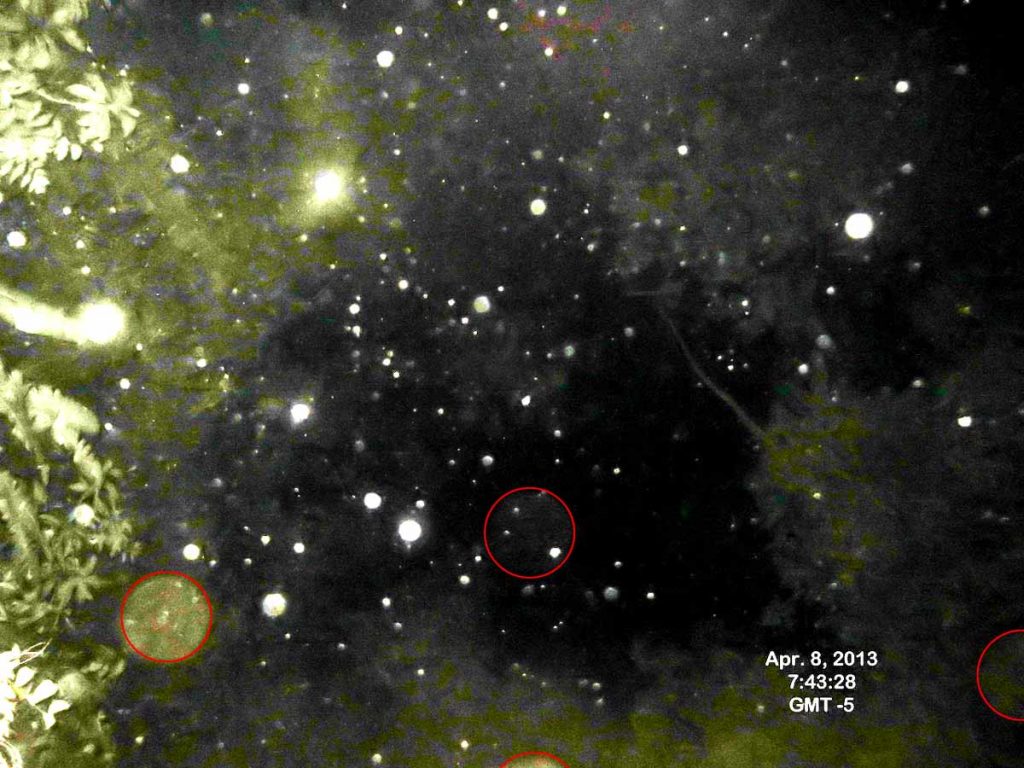

Additionally, there is very little motive to crop any of those images since there is nothing worth hiding in those images with the exception of Image 580 (head), where the angle of view is very odd and there might be motive to crop out other parts of the subject. Unfortunately the are no orbs visible in this image, which could be caused by the lighting conditions of the image of being completely lit. Analysis of image detail do not provide evidence for the image being cropped. It is reported from a person who has seen the original that it is not cropped. However that person may have seen only an already cropped version. Although image 580 is the image where there is the most motivation to crop unwanted portions out, it would have been even easier to simply delete the image, which may have happened with image 509 …
Probability: Unlikely
- Image has details cloned out
There is simply no motive to clone out details out of the images that show rocks, trees and bushes and none of the images shows apparent evidence of this happening. The only image where there may be a motive is again image 580, but again, it would be much more likely that the image would have been deleted if it shows anything unwanted.
Detailed analysis of the image does not indicate cloned or manipulated areas. Additionally Error Level and Luminance Gradient Analysis do not show evidence of cloning or editing, although in some cases it is not easy to detect.
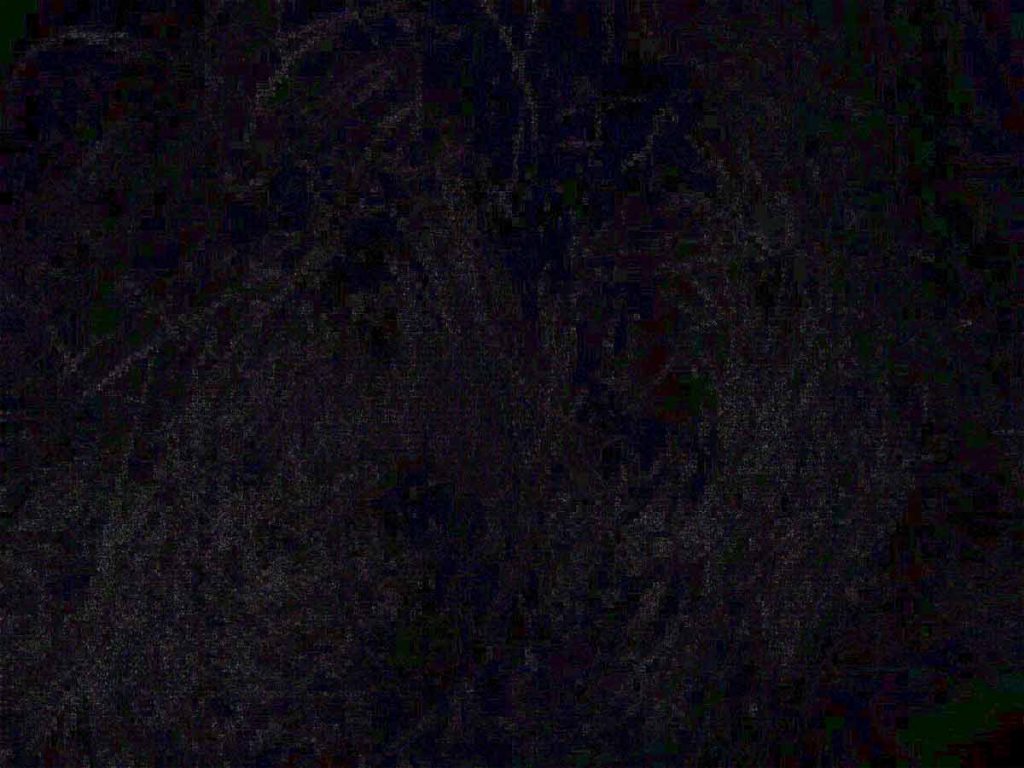
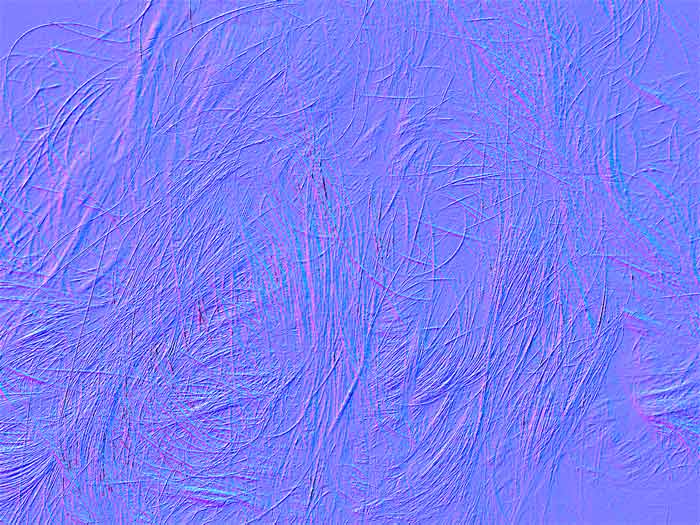
Probability: Very unlikely
- Image had detail added
There is no motive to add detail to the images. The majority of the images shows nearly no detail and the motive is not there.
Probability: Very unlikely
- Image time and date was manipulated
It is possible that the images were not all taken at the same night. While it is very likely that the majority of the images showing surroundings of the photographer were taken in the same night, it is possible the images that does stand out (image 550, balloon marker and image 580, head) were taken at other times and inserted. This would require considerable effort as all image numbers after the inserted image would have to be edited and also all EXIF data would have to be edited. This seems to be a huge effort for no apparent gain.
Probability: Unlikely
- Unrelated images were inserted
In order to insert unrelated images they would have to be from a Canon Powershot SX270 HS or all the EXIF data showing camera brand and model would have to be edited to match the original images. Again, this would be a lot of effort for no apparent gain.
It is also possible that all pictures are unrelated and inserted, but again that would require either all EXIF data to be edited or a Canon Powershot SX270 HS to be used. The original exposure parameters are 1/15s, f3.5, flash fired. Those are the exact same values my Canon Powershot SX270 HS reverts to if images are taken in complete darkness.
Probability: Very unlikely
- Images were deleted
It is possible that unwanted images were deleted as it might have been done with image 509. This would require that there are gaps in the image numbers, like image 509 is missing or that all images were renumbered and the EXIF data edited. It is possible that images after image 609 were deleted. Considering that at least one image is missing, it is possible that more images were deleted. In this case however it would be more likely that the deleted images would have been recovered by the police, unless they were secure deleted or deleted by the police.
Probability: likely
Summary
First, I’d like to thank Matt for sharing this research and for his commitment to the case. The valuable information he discovered during this research would not be possible without the hundreds of grueling hours of work that he put into the case. Exceptional job! Thank you!
There’s a lot of information to take from this research. It’s necessary to read the entirety of this article in order to grasp the depth of the analysis, however, it’s helpful to provide some overarching conclusions.
Contacting Matt
If anyone would like to reach out to Matt directly, you can send him an email directly at researchTT2@gmail.com or post a comment below. Matt’s fairly active in the community and always interested in progressing the case forward.
Thank you for reading and please reach out to us if you’re interested in contributing to the case research.
Please note: Our team is committed to accuracy of information and respecting the privacy of those involved with this disappearance case. If you have any supplementary information regarding the case, or if you were involved in this case and feel that the information available in this article impacts your privacy, please contact our team.

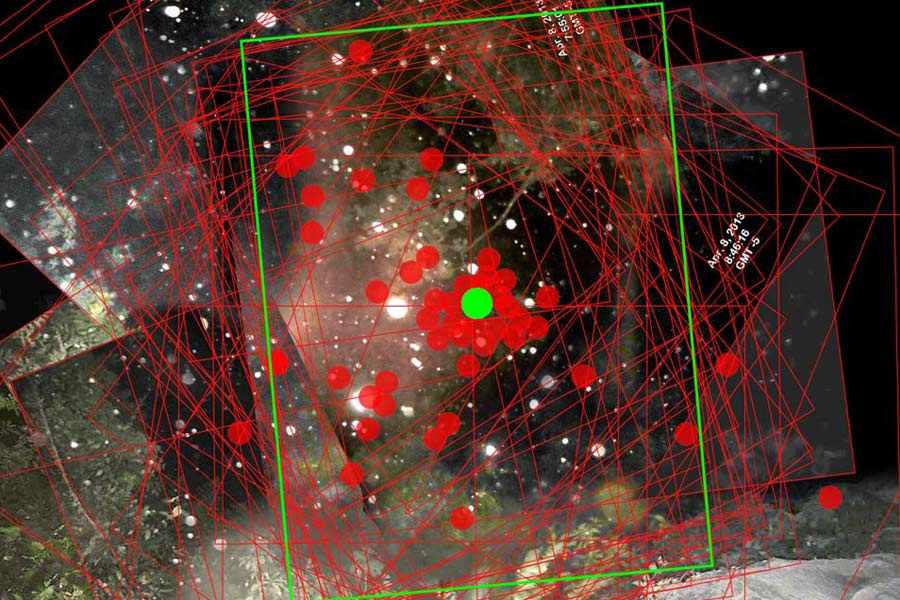

Maybe they morsed “SOS” with the flashlight…? So the pictures are just taken randomly by putting the camera up in the air. Someone would have to evaluate the timestamps on the pictures to that effect.
I think it’s actually unlikely that the reason for taking photos ar night would be to signal for help, because there were no people searching the jungle in the middle of the night, doesn’t make much sense.
Maybe they weren’t office searchers, but native people who were in the area?
Image 542
https://imperfectplan.com/wp-content/uploads/2020/11/hook-Resized-Small-1024×768.jpg
I think there is a bottle in this picture.
Plastic bottle with white cap.
As far as I know, the girls had two bottles with them. But only one was found in the backpack. Maybe this is the bottle that was not found?
You have not given a explanation on the flash not firing at full power. From the photos I have taken with the Canon SX270HS. Almost all the photos the background should be better lite from the flash. The difference is at least 3 stops or more different. From the photos I have taken the camera should have been set to an ISO of 100 to get the same effect. I have heard that the camera may have been water logged. How does this effect the flash? Would water in the flash make it dimmer?
Some time has passed since this analysis was done and an excellent 3d rendering of the photo’s has been completed since. There is little doubt the photo’s are all one location and seemingly at the top of a likely waterfall. If it faced toward Alto Ramero then it is possible they could see lights of the village and were trying to signal. The seeming heavy rain is likely just spray from the waterfall gusting with the wind.
It is possible after 8 days they had walked into a dead end cliff and did not have the strength or ability to go back and so stayed there in hope of rescue, eventually both perishing in the spot.
As the rainy season hit and waters started to rise, the backpack would be first to be washed away, followed by the bodies as the river rose high enough to move them.
https://kuula.co/post/NNty0/collection/7kGj5
https://1.bp.blogspot.com/-2cQko96ap30/XjSVyt7vudI/AAAAAAAABuE/pVkQU6dlIbkyaraUNH48ZIoVh-KZ69MtQCLcBGAsYHQ/s1600/IMG_0458_vs_IMG_nacht%2B%25282%2529.png
Wow that 3D rendering is so cool, but creepy
Regarding the overall rationale and intention of taking random pictures at night, I have not read anybody mention this.. Although it is in the subtropics, at those altitudes it gets COLD at night. That combined with being wet, it would be possible to get hypothermia. People with hypothermia do completely illogical things like taking off their clothes in the freezing snow. It is possible they were taking random shots for no reason at all. It is possible to get hypothermia at 40F or higher and it is not unheard of to get that cold up there when you combine the regular temp with a wind chill. It is not that likely that they had hypothermia but it is possible.
Can you send a request for more detailed satellite photos? Next to the hiking trail. It might help to find a place. Photos can be provided for free (as a help) or you can try to collect donations
Three speculations about Kris’s night time hair photo:
1.) There’s a possibility that Kris’s head is tilted back a bit, if it makes a difference.
2.) The upper center part of Kris’s hair appears flatter than the rest and implies her hairline, which could indicate that the upper back of her head was resting against something. Rather than Kris laying down on her back, it’s more likely she was (sitting?) upright, to account for her hair beneath the flatter spot to be more free-flowing. Laying down would also make her hair more dirty. In this case, it would make sense that the upper center part was flattened while the rest of her hair beneath and around it was not. I was thinking that she could’ve been face down at some point instead, though it would’ve needed a refluffing of the hair or subsequent leaning back for the hair below to not be flat. All of this speculation could be obscured by the possibility that someone moved her and/ or adjusted her hair for it to look the way it did in the photo. With that being said, can hand-ruffled hair look like that in the photo or was the hair naturally that messy without someone running their hand through it in some way?
3.) There’s a short, shadowy strand in the upper left of her head very close to the photo’s top edge that’s in the shape of a wide upright parabola. I’m skeptical that it could be a hair strand in itself. I also doubt that other strands of her hair are causing this shadow already so high up on and to the edge of her head. It could indicate the presence of an object.
I think the hair photo looks like she took out her pony tail and is facing down with her hair flipped over her face. If you look, her hair is defying gravity and is kind of “cow licked” up. It also looks like a hair part under the hair (like the top of her head.
I believe one detail that seems to be overlooked is that humidity in those places can also cause the bright spots even in the absence of rain, that’d explain the dry rock/hair/objects. I was in Costa Rica a few years ago and if my memory serves me well, some nights the moisture was so high I could see a similar effect just by pointing a flashlight into the sky. Further down into Panama I believe the forests get even more misty in the likes of La Amistad reserve as I have seen in pictures.
Also, regarding the shiny surface that looks like frothing water, looking at it quickly so as to avoid saturating my perspective, it seems to me more like a black plastic bag similar to the one attached to the twig. Both points I mention are not really relevant but I think it might help set a closer picture of the scenario they were actually facing.
I also would like to recount that one day it took me more than expected climbing a hill, so it got dark and I kinda panicked cause I was 16, tried to rush my way down the hill to get back home then I fell, (think I probably might have passed out since when I looked at my phone it was around 11p.m and I was certain I fell just minutes past twilight) anyway, when I went back on my feet I used my dslr with flip-up flash to take photos of the back of my head to check for bad scratches (as the girls hypothetically may have) and also to peep into the darkness to assess my situation since I had landed just inches from the void in a narrow terrace carved into a steep cliff. I was certainly locked at that spot till the morning when I could figure out how to take the big jump onto the next terrace which was wider and allowed me to climb back into safer grounds. In this case, the assertion of them pointing their camera’s flash (which was less costly than using their cellphone for that purpose) presumably into a spotted settlement seems more plausible. Regardless, congratulations for the very committed and sensible analysis and may the soul of those girls rest in peace in an utmost beautiful part of the Universe.
I wonder if the rock in 550 could be the location where that suspected photo of them swimming with two men was taken.
these pictures were means of signaling. I am 1000% sure of this.
These pictures are upward, towards the sky. The foliage is definitely hanging down over the rocks towards them. These rocks look different than the plateaurock of the red flag twig and the SOS marker.
These objects are placed horizontal and are the only pictures that look horizontally made. The rest are vertically upward the sky.
Indicating me they heard a plane or helicopter and started to try to get attention. The helicopter or plane must have been very close so they woke up ( ? ) and started the flashing.
The twig with red paper is a signaling “flag” its what they pictured as first. As of means: ” look at our bright red object that colour must get your attention” then they started to flash the light ( if you are on a island and see a ship in the horizon in the night and have a flash camera you would do the same ) up in the air.
They also pictured the S.O.S. marker on purpose also in means for look here!
Now the times of flashings looks almost like a morse S.O.S. morse code
but im 100% sure it isnt. I dont think they knew the S.O.S. morse and im not sure if anyone has checked out the times if they are some morse.
If all the night images were legit, with matching or near matching times, then in all likelihood the 2 were in front of a cliff face, where the cliff kind of leaned over the spot (shielding them from the rain). This would explain why Kris’s hair is dry in photo 580. In all likelihood, they were trying to signal a village, or somebody, in the distance for most of the photos (but not necessarily all of them). They were perhaps feeling somewhat hopeful in this moment, before they got more desperate toward the end and one or both came out from under the cliff to aim the camera at the sky and make the flash visible from all directions.
I don’t know why I don’t hear people suggesting that they were inside some sort of a pit – lika an animal trap. Either thrown inside, or it was a covered animal trap – traps like that were allegedly used by locals in Panama jungle to catch wild animals.
I think being trapped inside something perfectly explains why most of the photos seem to be looking up. It’s possible they were thrown in at night, or fell it at night (say while running away from some animal). Or they fell in during day but something prompted them to look for a way out at night. Perhaps that’s when rain started and they feared drowning inside there.
If it wasn’t a pit but say a dry river bed, then the next most likely explanation I think is that there might have been some wild animals sneaking from up above, and the flashlight was used to try to scare them away. That would explain why it was done over several hours (as the animal kept returning), it would explain why it only happened days after their disappearance. However it would struggle to explain why picture of hair or the boulder was taken – perhaps unintentionally.
The thory of it being a pit also would help to explain why one of the girls was standing so close by when her hair was pictured – as there was likely not great room inside there.
Hi
new to this case only a month ago, in Kris night time hair photo, that looks like grey PVC masking tape which is used a lot in electrical work. on this occasion they would use it as a cheap and easy way to to gag someone and stop them screaming!, its very sticky and would be very hard to remove from hair. just lay some on you forearm and pull off.
These comparative images have nothing in common with each other, nothing! It doesn’t matter how many raindrops are where, the two girls are dead! It would be much more important who killed them and why! All these afterimages are all fake! All photos were taken by the perpetrators and not by the girls! And Feliciano also knows, he knows what happened! End!
The more I look at the night photos, to try to make sense of them. The more the bottom right of kris’s head looks like brown hair. It Looks too dark to be her own in a shaded part of the picture. Could it maybe be Lisanne’s? Would make for them stand or laying in a very strange position if it was.
I hope to be able to contribute some finances towards the expedition when I’m in a little more comfortable position.
The girls need some sort of justice, it’s been long enough without answers.
3. To light up / find a path/location
I totally disagree with your opinion that they were not using the camera flash to find their location/path etc.
Your opinion squarely relies on both the girls knowing exactly how the camera works in a very emotional/scary and traumatic period of time. Scientifically yes the camera works exactly how you say in your statement. What you miss is the emotional panic most likely running through both of their minds. They are most likely lost, in pitch darkness, in the middle of an isolated region. Their water is most likely running low, they are tired and afraid. I don’t honestly believe that the first thing they would be thinking about is the modes on a camera they likely know or care little about.
I would argue that the images taken are taken for two reasons – one i think you missed.
1. That most are random enough to be taken to ‘light the way’ or to ‘see the path’. In complete pitch blackness and as aforementioned in an aroused state of panic, the only way to quickly light your way or the path would be to use the camera flash. it is the quickest and easiest solution under duress. Logically they may use different methods but under the circumstances, it may not run through their minds. I believe for these reasons alone it should be at least raised to a ‘likely’.
2. To document what is going on. There is another idea that they may have been trying to document what was going on or trying to take pictures in order to leave a trail of some kind? This is speculation and unlikely but it does need to be put out there. For example, the multiple pictures of the back of Kris’ head may have been taken by Lisanne to SHOW Kris the back of her head for some reason? May have taken a knock to the head or some kind of other injury and they were checking to see how badly hurt she was in some light? This also adds to my strong speculation that they were using the light to ‘see’ rather than ‘signal’.
I also think that some of the makeshift objects they set up (which i will leave to better persons than I to explain) were to ‘see’ if they were in the right position or stable where they had put them or out in the open enough for others tracking them to find.
For me, it all boils down to them using the flash to locate, find, and navigate effectively – not being aware of some of the camera’s other benifits; (especially coupled with their probable heightened state of panic) – i see no real reason why this would have been selected as unlikely.
I’m also not convinced that they were using this to signal – especially since some of the images are of the ground, of the back of heads, and of objects. But it’s plausible. It’s an interesting case.
I agree with you for the “rational thinking” that certain person assumes they would have… But for your first point, isn’t it clear that the pictures are all taken in the same area? This is my strong impression. So the “light up the path” theory is very unlikely for me. The photos don’t seem to show someone moving and using the flash to light up a path, at all.
I believe the object in photo 542 is a water bottle.
Well tbh guy, if you I was to use a light from camera to light the way it wouldn’t be so perfect as the way someone took the headshot of blondies back. So that don’t make since and if so then I wouldn’t be taking just one photo it would have been constant pictures and not only the same pics in same place.
Is there toxicology reports because what if they were drugged and could not focus in on what’s going on and simply get lost and also there one of the girls backpacks was on top of a rock on the river or a little to the side of a stream with a bottle water, both there phones and others belongings. Could it be they simply got drugged, then one hurt themselves because I’ve heard reports that say kris had an injured ankle by following off a cliff. I guess no one will really know but Panama and the locals know something I can feel it. It sounds sus and I know how weird it can get being lost in the woods while rain is pouring and animals lurking around but much rather get lost in Oregon woods which is a lot denser, vast and can get ugly but at least I know my way around this place some what unlike say panama which I would have no clue, I know Spanish tho so I’d be pretty much in my back yard when it comes to getting my way around their culture but I’d never go venture alone no way man!! Now it’s different when someone is making you go which I think falls perfectly in this incident. Who knows tho 🤷♂️
I totally agree. Another important factor is moon. If other nights didn’t rain and was not cloudy they didn’t need to light up the path but in a rainy cloudy day they need to do that.
Dus zonder één foto van hun verwondingen, eventueel te trekken. OP DIK EEN WEEK TIJD.
Komen ze af met DIT. Dat kan dus niet. Om maar iets te zeggen.
I’m new to this sad story and tried to go through your excellent research. Concerning the night photos, I know there is a technique often used in astrophotography which is called stacking. It combines the digital information of several photos to enhance very subtle details in what seems to be otherwise areas with no information. I myself cannot do this as it requires quite some experience but this might be interesting to try…
The photos shape a perception that they are attempting to signal for help with strobe light, orange signal marker bags, improvised signal mirror, and possibly the sos spelled by ripped paper (which makes no sense if they are sheltered from the water where paper not wet) why would one make a ground signal hidden under shelter? Why would one take photos of these signal items, none of which are effective or creative for college educated women? The camera battery can light a signal fire and smoke. Looks more like 3rd party perception management to me, in the absence of additional living photos of the disappeared women. They also left no sign for trained trackers and dogs. But if it was them, these photos indicate they were located in a clearing where they thought there was a chance to be seen by air.
Of note, the resources apparently used for signal are all presumably items they had in the backpack, not from the environment, but for the branch the bags are tied onto. This could indicate immobility. Why not lay out a giant sos message with branches or rocks? If on the move, why not do it every night? Answer possibly there was no intent to signal, but to only provide a red herring, and to have an excuse to overwrite deleted photos after last day photo. After watching parents video hiking pianista, it seems in the distance that could have been walked up to the first emergency phone call, they would have been able to turn around and walk back home easily. If that is accurate, then something else pushed them forward evasively, or they were already on the hike home at the time of the call. The key is understanding what is inside the radius of the final daytime photo of kris at the maximum pace that could have been hiked up to the time of the first emergency phone call. If there is no chance 2 bright minds could get lost within that radius, what does that mean with regard to the night pics?
Thinking about the 1 night photo “s.o.s.” trying to figure what that paper is. Then i saw something to the right side that reminds me of the edge of some medical gauze wrappers that have a little number and symbol for how to open it. Wonder if the white could be first aid gauze. Saw some accounts that they went to pharmacy on morning of hike. If thats what it is then logic says there was tape. Missing pringles can + missing tape = possible splint, in the no-foul-play scenario. Best of luck to you.
Part of the SOS sign is made from the map for the park they are in.
the bags on the twig look more like a tool to keep something above water when going through a stream. Perhaps there phones? Is it possible that the route they were taking turned into a stream because of the rain?
Perhaps this has already been pointed out: in images 551, 581, and 662 there is a definite man-made frame structure in the bottom right corner. It has the form of two capital A’s connected with a stick at the top. Has this already been discussed? What do you think this is?
Forget the above comment – it is totally wrong. I was commenting on one of your own photos – ones that you made yourself. I looked at the name of the photos and unfortunately they have the names of ***0551.jpg and ***0581.jpg. These are the numbers of the missing photos. So that’s what went wrong and so I have spent several hours trying to figure out where these photos would fit into the collage that you made. Well they don’t, and for good reason.
The only logical explanation for the night photos is the girls were trapped in a crevasse or pit and the only opening is from high above. That’s why they couldn’t escape and waited in one place for rescue. It must have been warm as the girls had time to take off their bras and put them away in the backpack. Then they must have heard voices in the night, perhaps made by locals not rescuers, and so pointed their camera straight up to use flash as signal. That’s why all the photos are in one direction, up. If u put the photos over your head and look at them from below they will make more sense. Also looking up is the only way all the water droplets appeared round instead of elongated. After the girls perished, rain and flood eventually washed their bodies out into the river system. Phosphorous is abundant element in caves that’s why their bones had traces on it. It’s a shame no one is looking for this crevasse it’s certain to contain the rest of the remains. Locals should certainly know locations of these dangerous natural features of their mountain jungle?
Sorry, posted this again, because it was not supposed to be a reply.
“There has been speculation that the images were used to signal search parties who searched at night or to helicopters that searched at night. This has to be rejected as cause since the searches were not conducted at night. ”
I read this constantly in various places as an argument against the signaling-hypothesis. That would assume that the girls had knowledge as to how, when and why search parties would be looking for them. This is something only we can have in hindsight, or people with intricate knowledge about how rescuing operations are pursued in general.
If I were lost in the jungle for days, I suppose would clutch at every straw and certainly hope people were looking for me constantly. In a vast, endless, impervious environment, nighttime is probably the best chance at finding the needle in the hay, since in the pitch-black a single flash of light might stand out for miles.
At this point we can furthermore not assume completely rational behavior whatsoever. So I don’t think boredom, panic or unease can be ruled out as a reason so easily, either. Maybe this night was darker than usual, maybe they were more restless than the days before and couldn’t sleep, felt uncomfortable in the dark. Maybe they were, for the first night, staying awake/keeping guard in alternating shifts (which also makes it less unlikely all pictures were not taken by the same girl) and just felt terrified alone in the dark.
I don’t think any potential reason (except the third party theory) is more or less likely than the other. Who knows? Maybe there was no reason at all and one or both girls had already completely lost their minds at this stage and were acting entirely erratically.
Photos are def weird, why would they take the photos in the darkness early morning at 1am to 4am, and most of which are darkness with no actual person showing up, then the hair photo is eerie, why only hair and no face/scar/other body part showed up now that you want to take pics. And most weird thing is they didn’t take any photos/videos during 4.2~4.7, why suddenly take photos on 4.8?
These photos are more like the murder was taking them to make us believe that girls were trying to ask for rescue, making us they were still alive.
Could it be that someone was taking these nightphotos with nearly the same rythm as 10 seconds for so long as a couple of hours to light up the way/spot for the other one /another one to complete something. And doing so with the camera pointing at a direction not to blind with the flash?
Hi Chris, please do take a deeper look into this spot. I’m pretty sure that this is the spot of the night photos it would be matched well. If you can do your research on that and let me your thoughts on this it would be nice.
https://www.journeyera.com/la-piedra-de-lino-rock-hike/
=== MODERATED ====
For the respect of the case, please do not publish rumors that have not been verified, unless you are willing to do the work yourself to verify them and present them to our team. I understand the temptation to discuss rumors. However, this case already has enough rumors and our team wishes to get past those rumors and focus on factual information.
Speculation is fine, publishing facts is fine, but this is not the place for publishing rumors that have not been investigated. We are in the process of cleaning our comments section to offer further respect to the families.
My apologies for the inconvenience. Please consider the KremersFroon Subreddit (link) to discuss rumors and highly-speculative case information.
“It has been speculated that the person in the photo is incapacitated laying on the ground. However I don’t find this probably since it is unlikely for anybody incapacitated or not to lay with the face to the ground since it is uncomfortable and the head would always try to roll to either side. Therefore it is more likely that the person is sitting or standing when the photo is taken.”
Also if the person in photo 508 was lying on their side, or prone with their head to one side, then the hair would naturally fall in that direction.
I was stuck in the Canadian bush with an injured forest worker overnight, me and one other worker. A lack of stretcher meant we had to wait until morning for evacuation. It was warm and we had flashlights. We kept flicking the flashlights on regularly when we were pretty certain a black bear was nearby. We had bear bangers and a rifle, but it was dark.
The frequency of these photos at night is indicative of someone using artificial light to frighten off a wild animal. This the exact sequencing and behaviour I’d expect using a camera flash aimed intermittently in the dark often with no true aim. Those photos are aimed at the darkest section with no narrative purpose. Dark is danger. Flash is a warning. One or both of the women were already in severe crisis. Even in tropical Panama, injury and trauma will lead to exposure and rapid health decline.
I’ve dealt with mountain lions. They can be tenacious and opportunistic. Assuming they only hunt by ambush is wrong. Are there jaguars in that area? If so, even more danger and another opportunistic animal looking for protein. Never assume cunning mammals have a sole approach and stalking method. I’ve seen a bear scavenge a dead animal week after week.
Rain dampens sound. Predator plus falling or water victim is a possible explanation of where human remains would turn up where they did, and it’s never a given to find bite marks. Some sort of cliff fall or water tragedy appears likely, with an abandoned backpack. That item shows up later in decent shape because some local male finds it long after the tragedy and rather than become a suspect, simply leaves it where a local woman can find it and turn it in. Moral action plus self-preservation. Cash and phones and integrity means little criminal effort.
The phone trace and attempt pattern is what could reasonably be expected of a severely disoriented, injured, lost person unused to such a hostile environment. They know their phone better than the jungle.
What bones were found speak to serious injury while hiking. The foot remains especially. Bleached bones can be from many natural sources and local forensics may not be able to discern.
They took practical items. Bras for young women travellers are inherently practical in the humid tropics. They made a very poor choice to leave established trails. Darkness, a fall, attempted self-rescue, injury, disorientation, too little water, insect bites, unfamiliar terrain and climate, all add up to a very sad ending. I’ve lived in Vancouver Canada where hikers die looking down on the city lights, just lost but trapped by terrain.
The one image of looking back on a rocky downslope with a not-so-happy look is, sadly, what one might expect when the path becomes unknown and dangerous, not in the fun, youthful manner. That’s the “Is this the right way?” look.
We don’t know much about their friendship and dominance roles, either. Leader is seriously injured but follower cannot summon courage to leave and a seek rescue. “Don’t leave me” is extremely powerful messaging dooming both.
Many…most…tragedies are a series of errors and mishaps. The event evidence points to multiple things going wrong.
I don’t see a crime here. Just a very terrible misadventure.
This was my conclusion as well.
You don’t see a crime ? You should look into the case deeper before claiming that.
Their body pieces and bones were found scattered around the area, in different states of preservation, and some bones were even obviously bleached – with absolutely no traces on them. One foot was even found cut in the shoe of its owner… The foot was intact in it, bone and flesh, the shoe was still tied.
If they had just gotten lost and had died in an accident, their bodies would have been found full or at worst partly eaten, with animal marks on them. That wasn’t the case.
If these photos are original, you can see in photo 511 a shelter of 5 stakes without cover, and it seems that it is tied with a cloth.
In your discussion of the opinions of the families, first uou say that they disagreed with the police, then you make a statement that they didn’t disagree with the police. Which is it?
Hi Joyce, thank you for your comment.
To be clear, one family strongly disagreed with the police, so much as to file a lawsuit against the Panamanian government. Additionally, both families disagreed (with each other) about the conclusions from the police findings.
So, the statements above are accurate. Matt, the author of this article, is well informed of the details of the case. I’ve revised the text for the sake of clarity.
Thanks for your interest in our work on the case.
Cheers
Ridiculous. So often I have accidentally taken a screenshot when I didn’t want to . People put way more into things . It’s way more simple , clearly those images were taken while someone was in distress he had her phone in her hand or she did and while they were fighting physically she pressed on the camera or he
Very nice and detailed work. It’s a real shame what happened to those girls, I can’t imagine how scared and desperate they must have felt… It’s hard to tell what happened, but it seems to me they got lost and possibly injured and could find a way out, but nothing can be ruled out. However I wouldn’t go as far to say things that I read some of the comments here were “everything it’s a conspiracy”, like dude stop with the movies…
Good stuff. I can see accident or murder.
The backpack being found dry and in good condition, other peoples bones in same spot, not using the phone for 5 days then attempting to use it again, all are very odd things
Don’t know about the bones, but the backpack and phone are explainable to me as someone else coming across these items at some point shortly after the girls perished, taking them, possibly turning one phone on in the process, then realizing what they were and eventually getting rid o the backpack and leaving it some place where someone else would eventually find it.
What I find so hard to understand is why the location is so difficult to find, especially if the assumption is correct that there was a monkey bridge at this location.
Hi Chris,
impressive job you’re doing here.
Just a quick comment regarding one of the pics. I am convinced that picture 541 shows part of a face (probably Lisanne’s). As I see it, the picture was taken bottom up. The overlit part is showing the underneath of her chin and left jawline. Further up, you see her cheek/cheekbone. The temple/hairline is not in the picture, but from this perspective, it is normal that you see some hair in the picture.
I don’t have a makeup dummy or similar for testing, just played around with my iphone a bit, and some of the results are quite close.
I believe picture 541 is an elbow. This and the head picture are of someone trying to photograph their injuries.
What annoys me is how the backpack was found. It was dry and clean, clearly the girls didn’t pass close the village and left it there. Somebody took it and left it there, or even gave to the woman, maybe so they’d take the reward money.
There are 2 bras on the bag, why would the girls take extra bras with them? Why take extra bras and no extra clothes, or a second water jar? I think more likely it’s their bra that were put there, but then why?
And if somebody took the bag and made it appear to public, why put the camera and phones on it? Why give these valuable data to authorities? Each girl was holding their phone, they weren’t hold on the bag, so clearly they were put there at some point.
Then there was the missing pic, why are all the others, specially the night ones, left? Why delete only 1 photo?
Totally agree that why distressed person would have phones in the backpack along with bras… unless you go for swim ?
I think its obvious they were using it as a light, you don’t sound 3 hours flashing to someone with a flash in the middle of a forest at night. Firstly you’d be unlikely to see anyone, and you would just walk towards it. With all the vegetation they wouldn’t have been able yonsee that far ahead.
Some were probably taken to see directly in front for hazards, and some of the distance to decide a route. E.g. took a picture saw a river in the distance, get closer take abother picture to make sure they don’t fall in the river. The balloon marker is clearly debris left by the river when the level is higher, they wanted to see the river not the stick with a balloon.
I think they had spent the previous days sleeping at night and trying to find their way during the day. They need shelter and they won’t find that at night. However, as they realised their lives were on the line, still lost and no rescue they decided they had to keep going or they would die. They used the flash to keep going during the night. Probably in a bad way the next day, cold and wet, they are dying. One dies before the other, the remaining girl keeps trying for signal but stays where she is, she is too weak to continue. She checks signal for a couple of days, switching it off to save battery. The last time she turns it on she is close to death, switches the phone off and dies.
That’s what accams razor would suggest happened. That is what I would do in that situation. Its a practical tool they can use in their desperation to keep going at night.
They probably took their bras off at some fairly early point and never put them back on. I’m not a woman, so I don’t know how uncomfortable bras would be in that sort of situation. But I don’t find it particularly suspicious that they didn’t have them on at the end.
As far as the backpack goes, most likely it was originally found by someone with no connection to the girls, who took it and possibly rummaged through it, maybe with the intent of using or selling its contents. Later, that person heard about what happened and realized the backpack and its contents belonged to the missing Dutch girls, so, not wanting to get caught up in the events, that person put it somewhere for someone else to eventually find.
Regarding the backpack it was, contrary to popular belief, not dry and clean as if stored on a shelf but rather that the content of it wasn’t wet and dirty as if it had been soaked in water.
The bras were the ones they were seen wearing in earlier pictures. As a woman it’s not at all strange to take off your bra when you’re bothered by the heat/humidity. Also bras can itch and scratch if you get warm and sweaty so it’s not weird to me at all that they put them in the backpack.
it also looks like a face to me in photo 585, where it shows a reddish color.
I think there is something wrong with the picture where Kris posing with her bottle of water. Expression has changed and body posture is not natural. I try to explore the picture but I don’t have material for that I was wondering if the darkness behind her was natural or photoshopped. I’m not even sure at that moment that she is facing Lisanne because she would have been very far away from her and that’s not common.
Imo Photo 580 is the front of the head, part of the hair covers the face, the head is pulled up by the hair, wee see the limit where the hair is pulled up. And in the corner you see brown hair probably Lisanne’s hair. this picture was taken by a third person.
Maybe kriss hair were swept on the her face- that’s explain why they’re so puffy.
Lissane’s hair and eyes are seen, the bodies were piled up by the killer
Those are probably not night photos but evening photos. Time zone in Panama is 6 hours earlier than in the Netherlands (in March, 7 hours in April due to DST). It is VERY likely the clock on the camera was not adjusted for time zone – my camera’s never do this and I always forget to do this manually this when travelling, and I travel a lot.
So the ‘night’ photos started at 1:29:42 AM Dutch Time, not local time. Local time would have been 7:29:42 PM, one hour after sunset. Or maybe 6:29:42 PM (sunset) if their camera was set to Dutch DST.
As a Signal: Very Likely.
Could this be real?
https://photos.google.com/share/AF1QipOaDcK-zyudR_UXP4xNvvSpKhbEUNHFkl1cvaGaZrvkiKqkgSL0BK5mjUL2SGcDjw/photo/AF1QipOHaO3eqqjaXZ8VYx2XXpwUErKpKKtjsV3-4ipL?key=UjkzUHpsRmtLNUc2RlphdjVTWHRZSVEySjNYS0NR
I am going to say …… no! I mean he has done a ton of research and analysis but that doesn’t make his conclusions correct.
In one of his videos he is trying to say the photos were manipulated, he points out that editing a photo in photoshop can cause distortion or pixelation……. while he in fact is using photoshop to crop out images of just the girls, removing the background, and using those cut-outs to “prove” his point by changing their size, positioning, etc.
He even goes on to use his own photoshop cutouts of the girls as “proof” of photos being manipulated because of shapes and sizes of parts of the girls…. anyone who has tried to make a cut out in photoshop can tell you that these lines are not perfect, no matter how much time you take, and can result in making a thumb or hand look wavy or weird.
It is well known by anyone who has looked into this case that the images we have been given access to are not the original images, this is stated on the above page as well. This could account for many of the things he is trying to point out in his videos and images.
There are thousands of photos and videos that he has put together, I am still looking through them but the observations listed were just made within the first few hundred that I have looked at. Sadly we may never know what happened to these two girls, they were alone (as far as we know) in the jungles of Panama….. We can’t get a country to agree on what fully happened to their President in Dallas Texas in 1963 when that area was loaded with hundreds of people and we have video evidence of that day.
The figure in 542 is very similar to the weird figure to the right in the picture where she looks as though she has her hands tied behind her back but is actually using her hand to keep the sun from her eyes.
About the deleted photo, I believe the plausible reason is someone within the investigation deleting it. By mistake or intentionally, but one should keep in mind the faulty investigation and human factor in it.
I think a good explanation for the night photos might be that they heard a helicopter or something similar, got excited that they might be rescued and took flash photos up in the air as a kind of SOS. This could also explain the back of Kris’ head as she stood infront of Lisanne, waving and looking up and Kris accidentally, or to highlight her, snapped a photo for the sake of the flash, not to photograph a close-up of her hair.
If that were the case though, the photo would have motion blur as her hair would have been moving as she was moving excitedly, which we do not see in the picture. We see perfectly still hair in great focus.
One of the more odd things that’s stood out to me is the picture of the rock with the torn pieces of paper and the reflective surface. Why would they take that picture at that angle, almost as if they were looking across the rock’s surface? Why wouldn’t they have taken it from above, to see what they had actually accomplished? Nothing in this case, evidence, or remaining “clues” can be conclusively used to determine accident vs foul play, and it’s true that people see what they want to see, but regardless, this utter lack of investigation, whether abject ineptitude or outright conspiracy, is disgusting. I’m thoroughly engrossed in this case and truly hoping something develops to possibly give a conclusion. Thanks so much for all the work you’ve done, organizing the wealth of information and possible red herrings that have been swirling around the tragedy of losing such promising lives.
Well, maybe they were explicitly not trying to take a picture of it, but just to shed light on it or make it temporarily visible to potential rescue parties/helicopters. Taking the picture from directly above bears the risk of obscuring whatever they may have wanted to be visible to others. There is speculations that they had laid out pieces of paper to form an “SOS” and even placed a reflective object (bottom of a pringles can?) beside it.
In my opinion there were trapped somewhere by another person. In that aerea of summit. I think first day there were togheder there but a few days later one of them was killed and thats the reason another person tryed to call emergency services so many times because she realized that a person who keeps there was going to kill her. And you can also expain this by looking on the decomposition of their body, one was killed much more earlier than another.Its much likely that during first day they were not yet aware of what was going to happen to them. They were a little bit scary but still having hope. It was because , I think they know a person who kept them or it was someone that they gave a trust. But day after day things started to change in worse and thay start calling emercency numer.I think a person who kidnapped them knew that in that aerea was no signal so he let them keep phones.I think it was on another side of the summit. Months later when they found a foot of one girl, her foot seemed to be cut by someone and I think thats what happpend. If you look on the guide going to the forest in some videos you can notice he holds kind of big knife for cutting plans, it seems like someone cut the foot of a girl by something like that. Their bodies was cut in pieces by someone. I,m pretty sure the case was not difficult to solve it but it was covered by the goverment.
Yeah I found that odd too! Like an animal wouldn’t do that!
It’s normal for feet to become detached like that during decomposition
Image 547 from the night photos is a man looking into the camera up close. I see his eyes and bridge of the nose. The camera flash reflects in his eyes.
All the random night pictures… Could this be an indigenous person not familiar with a camera, snapping the random pictures, and accidentally capturing one of himself?
Dittant – yes that is a good spot. I overlaid 550 (enhanced) onto 599 and it is a perfect fit. It at least tells us that 550 was taken at the same place and not inserted later from another location. Did they both fall onto a ledge, get injured, and there was no way off it? Or were they restrained there as it was next to a waterfall and no-one would be able to hear cries for help?
Sorry for posting twice, I found my way back here because I realized something about image_580.
I can’t be certain, obviously, but could the anomalies of that image be explained if it were taken underwater? The blobs of red surrounding the hair in IMG_580 are not recreated in the manufactured example, but exist in the original. The picture being taken underwater would also prevent the hair from looking dirty or wet; the dirt would wash out, and there would be too much water present to appear wet.
But why? I can’t find a reasonable explanation. All I can think of is that Kris fell (which means she is face down in the river in IMG_542?), and Lisanne was using the flash to see where she fell to. While feeling around in the river, she found something but couldn’t see, so she stuck her phone in the water and took a picture to confirm?
Wet hair underwater looks very different from dry hair not underwater, and you can tell in the photo the hair is dry and not underwater. There are individual hairs straying from the head on the sides of the photo, caused by heat and humidity, which if underwater would be laid down with the clumps of other hair and not free flying away from the head.
Also, if the photo was taken underwater you’d most likely see at least one or two bubbles in the picture.
Thanks for posting this. Very interesting research. I wish there was more to be found, or more time had been invested into this case. Sometimes I worry that ultimately what happened to them is that they were preyed upon due to their signalling with the camera. It wouldn’t be the first time that foreigners have been killed in those jungles.
Tremendous job, and thanks for the efforts. It is possible to know if some of the pics were photoshopped?, Could you release a “clean full pìcture”, i mean linking and putting togheter all the pics, loke a puzzle, please?: because its seems that most of the pics were taken pointing to the sky, like when you are laying on your back, like in the bottom of a cliff, from a slightly differents angles.
and why so late from 1.30 thru 4.30?: well, after almost a week in the open, no food, no sleeping well, no watch maybe, you hardly notice daylight and night, so for me its was someone making signals with the flash.
The jungle is warm in the day, but cools a lot at night; the temperature gets even lower the higher in elevation you go; and even lower when raining. I don’t know the official temperature throughout the time they were lost, but I would imagine it was somewhere around 65-70 degrees or colder at night.
I’m guessing that they were waiting out the night, but realized the weather was too much to withstand when the temperature dropped and it started raining. Not having any shelter would start to be pretty dangerous at this point. So, I agree that they were probably signalling.
Well friends. I feel so much mistery about this story, particularly the investigations have been kind of weird. From all i’ve known about this case, i think the Panama Government must be hidding something. Well, it is supposed in some times, governments are pushed to hide the truth about strange circumstances when those affect economy and reputation of a country. We can think that easily, due to the bad processes of investigation done by locals. Lost of evidence, bad manage of scenes, etc.
After this intro, i want to share some questions to you guys, where are the finger prints from camera and Kris and Lisanne stuff? if there is a technology (Even a simple recuperation software like Disk Digger) to obtain erased material with the exif, why i haven’t listened about this? in addition, is there a serious investigation about this, for example, done by Discovery ID or some familiar tv channel? cause according to yours points of view, must be a map, a 3d scene about photographies, at least a clear representation of the places in the photos, references of where they could be shot, etc. Do exist that information?
I have to congratulate Mark for his study, but that’s just a bit in all this big mistery. One of you wrote about maybe those balloons were for protecting cellphones, well, what else european people do when they go for a mountain walk? and what did the girls decided to go at 4 PM when it was late to go?
I’ve read about this story and the nighttime photos a few times and always had this theory about them.
I think some of the photos were rearranged. Especially the photos of the girls on the trails. To tell a different story of what happened to them.
I think there were photos of who the girls were last with before they disappeared. In order to get rid of this evidence, those photos were deleted.
Now something I have not seen mentioned on different sites that talk about this story is that I believe the nighttime photos were taken simply to over-write the data of the deleted photos. So that’s why there’s so many photos taken with nothing really being shown. Just taking enough photos to over-write any data on the sd card and show the girls to make it seem like they were the ones taking them.
But it’s all theories since no one really knows how much manipulation was done to the sd card.
In the analysis of the photos above, the capacity of the camera’s storage is discussed and through testing with a similar camera that capacity isn’t met by taking a similar number of photos. So, to ensure overwriting of the data marked for deletion, you would want to fill the drive to capacity, right?
In the analysis it’s also suggested that if it were a person with ill-intentions taking these photos, the only reason to return the camera is to do so out of incompetence, which I agree with. The person could just leave the camera out in the wild, or bring it home and burn it if this were the case and be better off for it. Allowing the camera to be found only provides more resources to locate the culprit; especially if it’s found out that data on the drive has been tampered with.
This story has puzzled my mind since I heard it. Mostly due to so many seemingly contradictory details. But I have come to a theory regarding the night photos. But first – in brief what I think might have happened.
The girls started the hike in good spirits (as seen from the photos). But after reaching El Mirador they met someone – possibly the tour guide they were supposed to meet the next day. He offered to show something on the other side so they went deeper into jungle instead of returning to the vilage. But some uneasiness appeared and they grew more and more concerned with the decison. The pictures show different mood. Perhaps Kris was less happy hence the photos made of her from greater distance. At some point the girls decided to flee the unwanted company. They ran away only to understand that they do not actually know the right return path. They called 112 but there was no signal. But shortly after the call they met local (indeginous) people who offer help (no detailed communication was possible due to language barrier). The girls were taken to a local farm – deeper in the jungle. Clean clothes were offered (so Kris took of shorts to be washed). But what initially seemed help turned out to be potentially dangerous place. The girls had their phones but were not able to use them except for few moments throughout the day. And the locals were not too concerned since they knew that there is no signal in the area.
Meanwhile the search for the girls commenced. The guide went to the hostel where the girls were staying to talk to them and maybe apologize only to find that they had not returned. The search for the girls was performed in different areas – far away from their actual location.
Due to growing concerns for their future fate (maybe there were some alarming indications) the girls decided to flee (on the night the photos were taken). They ran into the jungle and tried to follow the trail back to their vilage. But coming to the river they could not find the monkey bridge – so they used the camera flash to find it – making photos all around – including above since they thought the bridge is above them (photo of the hair was an accident but the hair was dry and clean because they had apent the previous days indoors). They hurriedly made a SOS sign out of the map in their backpack. Unfortunately the flash attracted attention of the followers who caught the girls. They were braught back to the farm and killed – perhaps one before the other. And chemicals available were used to aid decomposing.
Meanwhile the search continued and the abductors had to get rid of the girls’ belongings. The backpack was planted on the river bank along with the shorts and some bones/skin. To indicate that their disappearance was linked to the river and accident not the farm. As to the missing photo – maybe the locals saw the guide on it, contacted him and he deleted it – before the backpack was planted on the riverbank (possibly paying some remuneration to the locals).
Reasonable.
Not particularly reasonable, no. It makes no sense for a human villain to leave the backpack (containing the phones and camera) behind where someone could find it and hand it to the authorities, especially out in the jungle where there are endless possible ways to destroy evidence so that it will never be found. If a bad guy caught them and got rid of them, it makes far more sense that he/they would have disposed of the backpack and it would never have been found.
Chris, could you explain what you mean with: the majority of images (91) were taken within 4 minutes or less ?
Do you mean that the photo’s were taken 4 minutes apart from each other? Or do you mean that 91 pics were taken in 4 minutes time?
Picture 510 had time stamp 07:29.
The first 83 photos were taken in 30-31 minutes time, ending at 08:00:37. That makes an average of 24-25 seconds per photo.
The next 46 minutes, 10 photos were taken, including 599 (!significant pic, significant spot and angle!) and ending with photo 605.
The last 4 photos were taken with longer intervals, the last interval lasting almost 50 minutes.
Something unusual things had happened there.The Big question is,If there are more than 100 photos had been taken by either Kris or lisanne how in the earth it could’ve been deleted when there are highly chance that the images might have helped them if they were truly just trapped in the jungle?If the camera had already been on the two of them, surely they would’ve kept it and wait for the rescue.And while waiting for the rescue, since they had already brought their backpacks,food,etc., it was impossible they wouldn’t have survived and couldn’t have been traced right before they had been disappeared together.I had seen those images on google such as their shoes,Red plastic bag,bras’ and backpack somewhere found in the jungle.So, I’d really think something unexplainably situation had happened to the both of them, In either separate or same ways.
Maybe the two plastic bags tied to the twigs were for the cell phones. So they could lift them above the rocks to try to connect.
Wow, thats an awesome idea! You might be so right!
Very intresting and detailed read. The only question that wasn’t covered was the photos angle. You normally hold a camera horizontal or vertical but the photos where taken horizontal, vertical, diagonal one way then diagonal the other way. If you were signalling for help why would you be rotating the camera around so much? You would normally only rotate a camera like that if you were trying to take a picture of something
My thoughts exactly! This shows that they were NOT signalling for help.
I’ve studied the images for some time now.
The camera* was able to hop easily from spot to spot while turning its angle each time
(*the photographer)
Maybe when you suddenly hear a helicopter but cant see him because of the darkness and trees, you would flash in every direction so the pilots can see you.
Well done Dittant! I think you have made a breakthrough by linking the night time photo 550 with 599. I have been studying this case for a long time and I think that whoever took the night time photos was possibly stuck on a ledge, high up and at the side of a waterfall. Surges in the waterfall, not rain, would periodically increase the number of water droplets in the air as shown on some of the photos. Perhaps the girls used the branch with the red bags tied to it to reach out and fill with water from the waterfall.
I think there were three levels of rock to the ledge they were on – a high level rock where the SOS sign was laid out, possibly because it was the highest point that could be reached and hopefully more visible from above. As the SOS sign was photographed at eye level, this shows it was not possible for them to climb up onto the rock it was on. A portion of the front of this rock can be seen in pic 594 as a thin triangular shape at the top right of the photo – you can see a small plant growing out from the triangular shape. The middle level rock was more accessible as shown by the fact that the photo of the branch with red bags tied to it was taken from above. What looks like reflections of running water just below the edge of this middle level rock is really only white patches on the lowest level of rock below. That rock has white patches on many parts of it and also has runoff channels, which are characteristic of rocks at the edges of waterfalls.
When some of the night time photos were taken looking over the edge of the lowest rock and into the dark beyond, the photographer was actually taking pictures of the tree canopy below, not above and what looks like the wire of a monkey bridge in photo 550 could actually be a cable carrying hydro electric power from a dam (there is a dam higher up from Boquete) or a zip line running through the trees. There are loads of zip lines in the Pallo Alto area, which is not far from the Pianista trail.
The importance of the girls being stuck high up on a ledge, means that if they died on the ledge their bodies might have been washed off it if the waterfall had become more ferocious and widened due to heavier rain later in the year. Their bones could then have ended up, where they were actually found, low down on the banks of a river.
But how would they have got on the ledge in the first place? Did they fall onto it from a great height, the cause of Kris’s broken pelvis and Lisanne’s snapped ankle? Could somebody have pushed them?Perhaps the purpose of taking so many of the photos into the dark was a last desperate attempt to see if there was any way down from the ledge. Although I don’t really think that would have been the case as it would have been better to assess the situation in daylight, what I do think is that if the girls, as some people think, were trying to attract attention with the camera flash wouldn’t, they have started using the flash as soon as it got dark, when people would have been up and about? It would have made no sense to start trying to attract attention at 1.30 am when most people would have been indoors. I suppose it was possible they were delirious from hunger by the 8th night and may have thought they heard a plane going overhead.
Perhaps, like so many people think, it was not the girls who took the night time photos at all. Perhaps it was someone who harmed the girls, and then chose a place to set up a situation to try and fool everybody into thinking the girls perished after getting lost. After all, the girls wouldn’t need to photograph the SOS sign and tree branch as proof of their attempts to attract attention, but somebody trying to throw people off the scent would.
I hope that many more people will join in, in trying to piece together ideas and information about this case until eventually we discover exactly what happened to the girls. I feel we owe it to them to find out and to not let them be forgotten. Then maybe, just maybe the authorities over in Panama will feel the pressure and finally come clean and tell the truth about what really occurred.
There is absolutely no reason why anybody else would have needed or wanted to use the camera that night. None. If a third party had gotten a hold of the girls and done terrible things to them, then literally all he would have to do to get away with it is exactly what he did–nothing. Fiddling with the phones and the camera, and then leaving them in the backpack for others to eventually find, makes zero real-world sense for a human villain to do. I know we like thinking about criminal masterminds and psychopaths and things like that, but there’s just zero reason to believe any human villain would have any reason to do things like that. That’s the sort of things that happens in mystery fiction and crime thrillers, not real life.
It’s far more likely that one of the girls died on the night of April 8 and the survivor was using the camera as a light to see what happened to her friend.
I dont have access to this camera.
I have a theory that the two where indeed trying to navigate using the until the memory card was full deleting shots and overwriting them as they went. Is there for some reason that if they deleted all picures from 509 up the camera would start the count at 510?
Worth noting that 509 could be a video file as well. With this model camera there is no differnce between a deleted video and a deleted photo. It’s assumed a photo but could be a video. I think perhaps one of them filmed a goodbye message and decided to delete it. Perhaps when she tried to rerecord she ran out of power. I know some sites say photos\videos cannot be perm deleted without a computer on this camera but they are incorrect.
I would look at some of the pictures with caution. I do not consider some of the “later” leaked night images to be authentic. In general, I think some of this “source” is not authentic.
–
For example, the size of the original image is missing in the exif data.
Reading the string is also revealing.
The “Foto Sabroson” shows identical “oddities” …..
You can quickly check it here: https://29a.ch/photo-forensics. It works better with a toolkit like ghiro
some examples:
https://photos.app.goo.gl/PbVWJbiYxifScwy17
Picture 541 is a finger bent with long hairs on the top portion of the picture which means its a man taking the pictures there is no way one of those girl had long ass finger hairs like that.
So boom very likely someone was taking pictures to deceive
Comment Every person is different. It was another person who took night photographs. This is a murder! Thanks for the research.
I think that they were being led somewhere by force and the quick pics were a way of trying to document their path.
Daniel Howie, that’s not a finger, it’s part of one of the girl’s face (like one of her cheeks). The hair is from the girl’s head.
Froon stood 184 cm tall (6 ft). That is much taller than the avg Panama male. Tall gals have fairly large hands and feet
thats the side of a face. Nobody has hair that long on their knuckles. I think people want this to be a killer for some reason, but if you look at other cases like this were people disappear while hiking. Many times when people are lost they fall into these ravines and cant get back out of them. The rest of the story really doesn’t line up with a killer. it lines up with two girls who got lost probably trying to get to the waterfall that ended up allot further than they thought and they fell into a ravine.
An important observation about the night photos: photo 599 provides a missing link, for the first time spatially connecting photo 550 (red-bags-on-a-branch) to the others. I’m surprised no one has ever noticed this before. The rocks seen clearly at the edge of 599 are a direct and secure match to the dimly seen background rocks in enhanced versions of 550. We do have in both 599 and 550 a big round rock, which in 599 can be seen to be partly covered with leafy plants, not just moss, (in the enhanced 550 the covering on this rock isn’t sharply resolved) and behind and to the left of that, a smaller and distinctive triangular rock. Despite the difference in resolution, a number of details on the round rock are identical in both 599 and enhanced 550! When we add the triangular rock, we can say that, we certainly see the same formation in both photos. This match has many implications: 1. It establishes that 550 was shot at the same site with the others, disproving suggestions than it shows a different locality. 2. It probably means the photographer had the 550-rock at their back while taking most of the photos, then turned briefly around, took photo 550, and turned back again to continue in the previous motive. It is quite probable the photographer was during all this time leaning on the 550-rock itself. This gives a rather unexpected explanation of why most photos tend to point towards one particular area in space. Many wonder what was there that the photographer was pointing at. I think that possibly there was nothing important at all towards that particular area, that drew the attention of the photographer. The priority for them was to just take a relatively (under the circumstances) comfortable position leaning with their back on the 550-rock and stay more or less in that position for hours and shoot at whatever lay generally in front of them from that position. 3. It seems photo 576 (SOS marker) is located immediately to the left of 550, and that possibly the white objects seen behind the foreground rock in 550 are crumpled pieces of paper discarded/fallen from the 576-rock. 4. The only void we now have for the locality is about what is located to the right of 550. Continuing clockwise from 550 we eventually will get to the rock wall of 542, but there must be a void between 550 and 542 not recorded by the photographer. Possibly the reason for this is that in that direction the rock wall is very near the photographer and it is the steepest part around with nothing to photograph. 5. About the interpretation of 550. Is the “monkey bridge” interpretation still tenable? I don’t think so. Certainly people must start looking at enhanced versions of 599 to try and discern any steel cables, but since 599 is much clearer than 550 I think that any cable present would have been visible even without enhancement, and I don’t see anything convincing. Possibly the “lines” just visible in 550 are image artifacts. Now that we understand the positioning of the 550 rock in relation to other rocks in the photos, we can make exact comparisons with candidate sites. The triangular rock is a very useful indicator. The layout of the site speaks against the “monkey bridge” theory: It doesn’t seem we are dealing with a large stream, large enough to necessitate installing a monkey bridge. Where could so much water flow through that it would be difficult to cross? The distance between the foreground and background rocks in 550 seems small, behind the background rocks in 599 appears dense vegetation, not a stream bed. The background rock of 550, as seen in 599, (having leafy plants, not moss) isn’t like stream-battered rocks where such vegetation cannot take hold. The rounded form of the rocks does suggest water erosion, but maybe we are dealing with an old, abandoded side channel. There’s also the possibility that the rocks are granitic, so will naturally weather into a rounded shape without water erosion. If this is so, it’s not necessary for the site to be or to have been a stream bed.